Paul van Yperen's Blog, page 71
October 17, 2023
Quo vadis? (1924-1925)
The third film adaptation of Henryk Sienkiewicz's famous novel 'Quo Vadis?' was the spectacular German-Italian co-production Quo vadis? (Georg Jacoby, Gabriellino D'Annunzio, 1924-1925). Emil Jannings, the famous star of the German silent cinema, was cast as the evil emperor Nero. He leads an international star cast including Alphons Fryland, Elena Sangro, Elga Brink, Lilian Hall-Davis, Rina De Liguoro, André Habay and strongman Bruto Castellani.

German postcard by Ross Verlag, no. 699/1, 1919-1924. Photo: Filmhaus Bruckmann. Publicity still for Quo vadis? (Georg Jacoby, Gabriellino D'Annunzio, 1924-1925). Here we see Nero ( Emil Jannings ) going out of his mind when his little son dies.
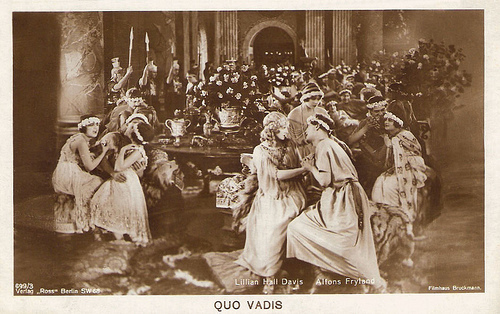
German postcard by Ross Verlag, no. 699/3, 1919-1924. Photo: Filmhaus Bruckmann. Publicity still for Quo vadis? (Georg Jacoby, Gabriellino D'Annunzio, 1924-1925). Here, Marcus Vinicius ( Alphons Fryland ) tries to seduce the chaste Lygia ( Lilian Hall-Davis ) during an orgy at Nero's palace.
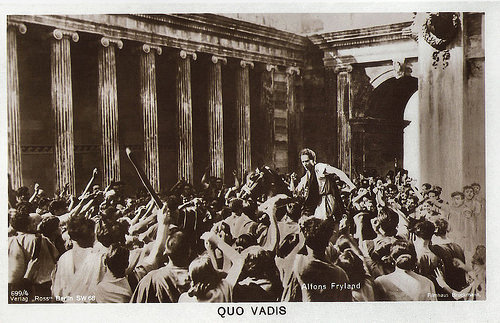
German postcard by Ross Verlag, no. 699/4, 1919-1924. Photo: Filmhaus Bruckmann. Publicity still for Quo vadis? (Gabriellino D'Annunzio, Georg Jacoby, 1925). Marcus Vinicius ( Alphons Fryland ) leads the populace against Nero.

German postcard by Ross Verlag, no. 699/5, 1919-1924. Photo: Filmhaus Bruckmann. Publicity still for Quo vadis? (Georg Jacoby, Gabriellino D'Annunzio, 1924-1925). Here we see Ursus ( Bruto Castellani ) liberating Lygia ( Lilian Hall-Davis ) after he has conquered the raging bull. Castellani's face and hair are clearly drawn afterwards. In the film the nudity is only visible for a fraction of a second.
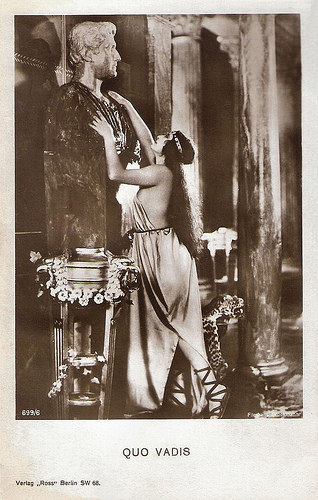
German postcard by Ross Verlag, Berlin, no. 699/6, 1919-1924. Photo: Filmhaus Brückmann. Publicity still for Quo vadis? (Gabriellino D'Annunzio, Georg Jacoby, 1924) with Rina De Liguoro as Eunice, secretly in love with her master Petronius ( André Habay ).
A huge spectacle
Ten years after the smashing success of director Enrico Guazzoni's colossal epic Quo vadis? (1913), the Unione Cinematografica Italiana (U.C.I.) decided to make a new silent film version.
The Unione Cinematografica Italiana was a Ufa-like or Universal-like merger of many Italian pre-war film companies. Grand old man Arturo Ambrosio was the producer of the third film version, Quo vadis? (1924-1925).
Directors were the German Georg Jacoby and the Italian Gabriellino D' Annunzio, son of Gabriele D'Annunzio, the famous Italian writer and adventurer.
They turned Sienkiewicz's story of Emperor Nero's politically motivated persecution of the early Christians to hush up his own burning of Rome, and of the 'conversion' of an agnostic Roman warrior via the love of a virtuous Christian girl, into a huge spectacle.
Highlights are the 'burning of Rome' scenes and the climactic fights and carnage in the gladiatorial arena. Cinematography was by Giovanni Vitrotti, Alfredo Donelli, and Curt Courant.
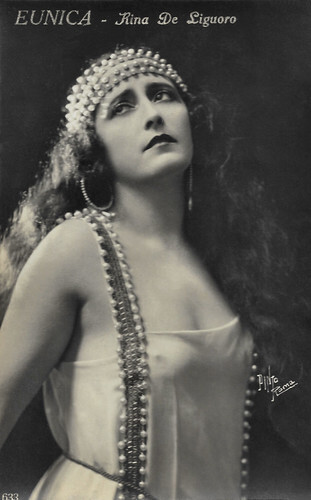
Italian postcard by Ed. A. Traldi, Milano, no. 633. Photo: Pinto, Roma. Rina de Liguoro as Eunica in Quo Vadis? (Gabriellino D'Annunzio, Georg Jacoby, 1924).
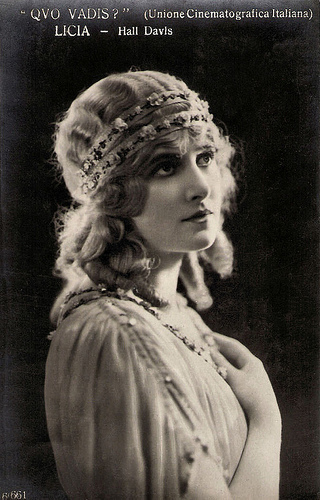
Italian postcard by Ed. A. Traldi, Milano, no. 651. Photo: Lilian Hall-Davis as Licia/Lygia in Quo vadis? (Gabriellino D'Annunzio, Georg Jacoby, 1924-1925).
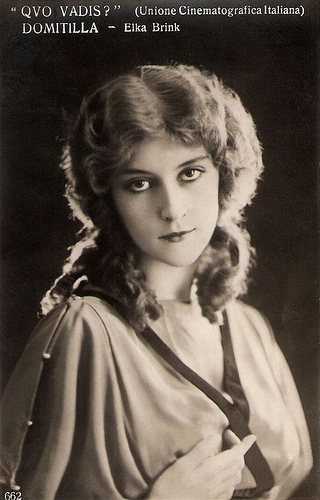
Italian postcard by Ed. A. Traldi, Milano, no. 662. Photo: Elga Brink as Domitilla in Quo vadis? (Gabriellino D'Annunzio, Georg Jacoby, 1924-1925).
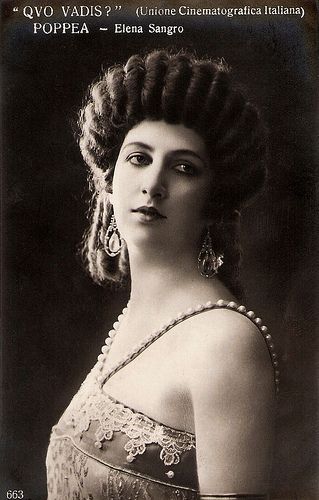
Italian postcard by Ed. A. Traldi, Milano, no. 663. Photo: Elena Sangro as the Empress Poppaea in Quo vadis? (Gabriellino D'Annunzio, Georg Jacoby, 1924-1925).
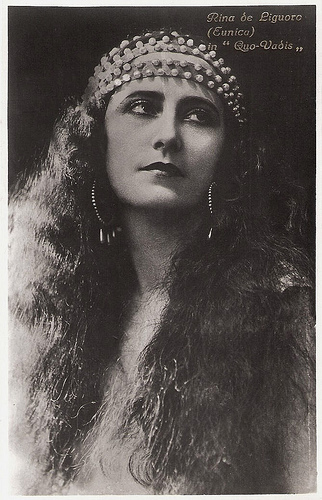
Italian postcard by Ed. G.B. Falci, Milano. Photo: Rina De Liguoro as Eunice in Quo vadis? (Gabriellino D' Annunzio, Georg Jacoby, 1924-1925).
A stellar cast
The historical epic was shot in Rome with a stellar cast of international silent stars. One of the brightest stars of the British silent cinema, Lilian Hall-Davis , and Austrian actor Alphons Fryland played the two young lovers Lygia (Licia in Italian) and Marcus Vinicius.
The German actress Elga Brink appeared as Domitilla. She has a spectacular scene, when as a Christian martyr she is first dragged by a chariot through the circus but then manages to climb up the chariot, take the reins and finish the race, to the great joy of the audience. Italian actor André Habay portrayed Marcus' uncle Petronius, Nero's 'arbiter elegantiae', who uses his wit to flatter and mock him at the same time. Italian diva Rina De Liguoro played Petronius' slave Eunice who later on becomes his mistress and dies with him.
And then there was the famous star of the German silent cinema, Emil Jannings , who was cast as the emperor Nero. Hal Erickson at AllMovie : "Jannings tackles the role of Nero with lusty abandon, making this already larger-than-life historical personality even more so." While in the 1913 version Carlo Cattaneo gave a more naive version of Nero, more the victim of his surroundings, Jannings' Nero is clearly a perverse and sadistic man, who enjoys other people's misery, frightens and plays with his courtiers, and hypocritically offers Licia's his help after Vinicius has been too rough to her, only to reveal later on his own real, lustful intentions. It is also clear the filmmakers gave Jannings a much bigger part in the film than his predecessor or than in the novel. The publicity highlighted his presence as the star of the film too.
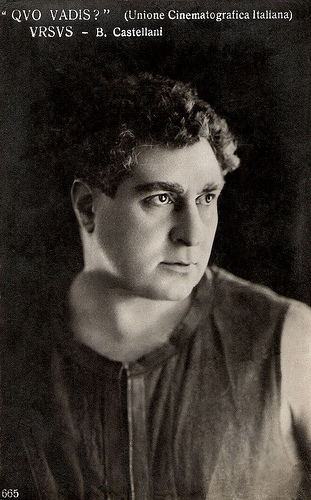
Italian Postcard by Ed. A. Traldi, Milano, no. 665. Photo: Bruto Castellani as Ursus in Quo vadis? (Gabriellino D' Annunzio, Georg Jacoby, 1924-1925).
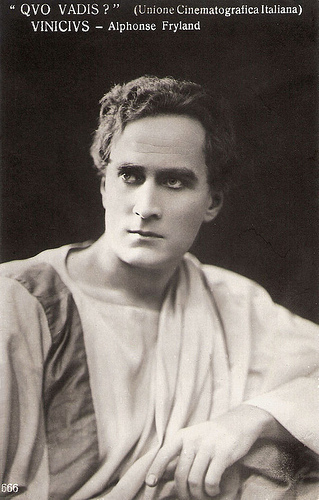
Italian postcard by Ed. Romeo Biagi, Bologna, no. 666. Photo: Unione Cinematografica Italiana. Alphons Fryland as Vinicius in Quo vadis? (Gabriellino D' Annunzio, Georg Jacoby, 1924-1925).
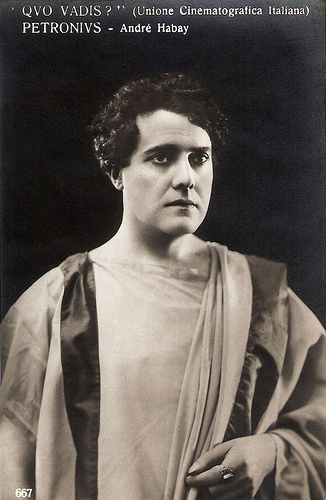
Italian postcard by Ed. A. Traldi, Milano, no. 667. Photo: André Habay as Petronius in Quo vadis? (Gabriellino D'Annunzio, Georg Jacoby, 1924-1925).
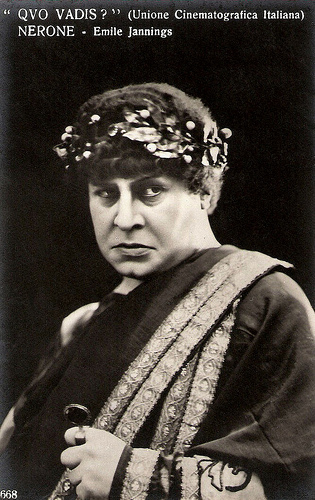
Italian postcard by Ed. A. Traldi, Milano, no. 668. Photo: Unione Cinematografica Italiano. Publicity still of Emil Jannings as Nero in Quo vadis? (Georg Jacoby, Gabriellino D'Annunzio, 1924-1925).
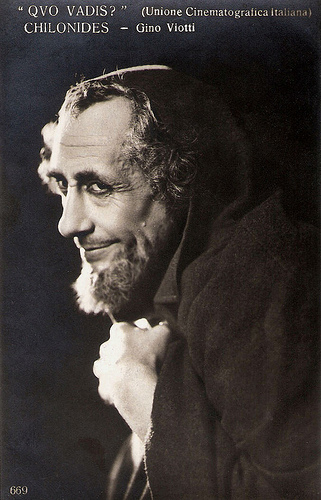
Italian postcard by Ed. A. Traldi, Milano, no. 669. Photo: Gino Viotti as the lecherous and treacherous Greek Chilo Chilonides in Quo vadis? (Gabriellino D'Annunzio, Georg Jacoby, 1924-1925).
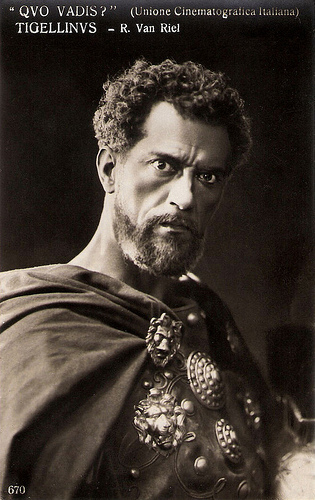
Italian postcard by Ed. A. Traldi, Milano, no. 670. Photo: Raimondo Van Riel as Nero's evil general Tigellinus in Quo vadis? (Gabriellino D'Annunzio, Georg Jacoby, 1924-1925).
Streaks of sadism and nudity
Quo vadis? had its Roman premiere on 16 March 1925. The producer had tried to equal the earlier version of 1913, adding enormous sets, designed by sculptor and architect Armando Brasini, and streaks of sadism & nudity, some already present in the novel such as the human torches, others added to attract audiences, e.g. a female fed to Nero's lampreys.
The 1925 version didn't have the worldwide success of Enrico Guazzoni's earlier film. For various reasons: people were a bit bored with epic films and the censor had ordered cuts, such as the too-explicit scenes of orgy, violence and blood gulping. The producer almost went bankrupt over copyright claims he all had to pay.
It didn't help that the lion tamer Alfred Schneider was convicted because one of his circus lions had bitten and killed an extra.
Still a fascinating film, especially for the performances of Emil Jannings as the evil emperor Nero, Elena Sangro as the empress Poppaea and Bruto Castellani as the strong man Ursus. Castellani had performed the role before in the 1913 version of Quo vadis?
Hal Erickson at AllMovie: "Although not as much of a cinematic landmark as the 1913 version of Quo Vadis?, this 1924 Italian adaptation of the Henryk Sienkiewicz best-seller was a splendidly lavish production, not to mention a worldwide box-office success."

German postcard by Ross Verlag, Berlin, no. 698/1, 1927-1928. Photo: Filmhaus Bruckmann. Emil Jannings as Nero in Quo vadis? (Gabriellino D'Annunzio, Georg Jacoby, 1924).
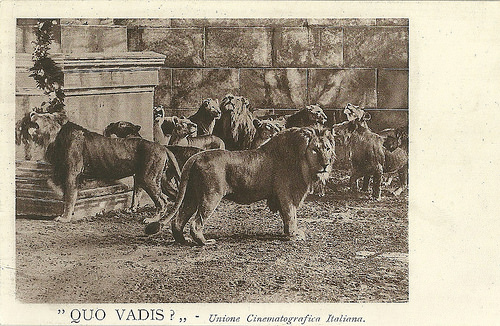
German postcard by Ross Verlag, Berlin, no. 698/3, 1927-1928. Photo: Filmhaus Bruckman. Lillian Hall-Davis as Lygia in Quo Vadis? (Gabriellino D'Annunzio, Georg Jacoby, 1924).
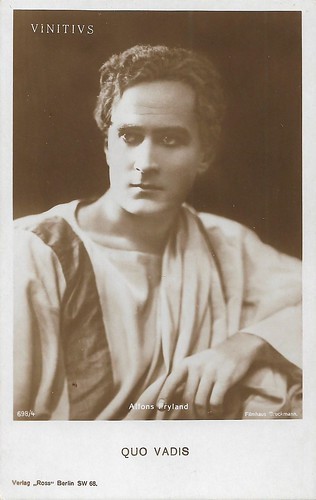
German postcard by Ross Verlag, Berlin, no. 698/4, 1927-1928. Photo: Filmhaus Bruckmann. Alphons Fryland as Vinicius in Quo vadis? (Gabriellino D'Annunzio, Georg Jacoby, 1924).
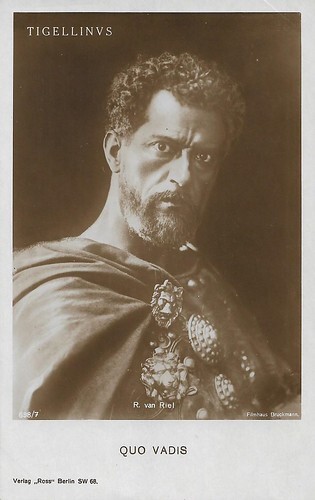
German postcard by Ross Verlag, Berlin, no. 698/7, 1927-1928. Photo: Filmhaus Bruckman. Raimondo van Riel as Tigellinus in Quo Vadis? (Gabriellino D'Annunzio, Georg Jacoby, 1924).

German postcard by Ross Verlag, Berlin, no. 698/8, 1927-1928. Photo: Filmhaus Bruckman. Rina De Liguoro as Eunice in Quo Vadis? (Gabriellino D'Annunzio, Georg Jacoby, 1924).
Magnificently restored
Hal Erickson mentions at AllMovie that the subsequent Hollywood popularity of Emil Jannings prompted a reissue of Quo vadis? in 1929. Reportedly a newly recorded musical score was added.
In 1951 Hollywood made a new version with sound and in colour, Quo Vadis (Mervyn LeRoy, 1951). The film stars Robert Taylor, Deborah Kerr , Leo Genn , and Peter Ustinov. It was nominated for eight Academy Awards.
Fifty years later followed a Polish adaptation by Jerzy Kawalerowicz: Quo Vadis (2001). There was also a 1985 mini-series starring Klaus Maria Brandauer as Nero.
Also in 2001, the Dutch Filmmuseum (now Eye Filmmuseum) in Amsterdam restored the silent 1924 version of Quo vadis?, based on various existing copies. This magnificently restored version had its 're-premiere' at the Bologna film festival Cinema Ritrovato in 2002.
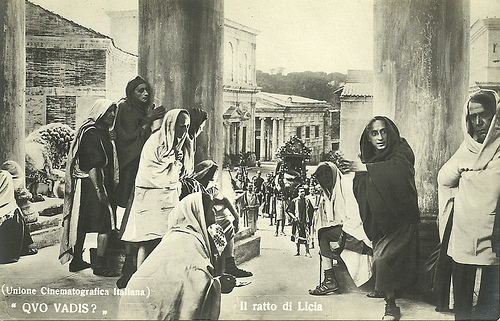
Italian postcard. Photo: UCI (Unione Cinematografica Italiana). Publicity still of the scene of the kidnapping of Lygia in Quo vadis? (Gabriellino D'Annunzio, Georg Jacoby, 1924-1925).
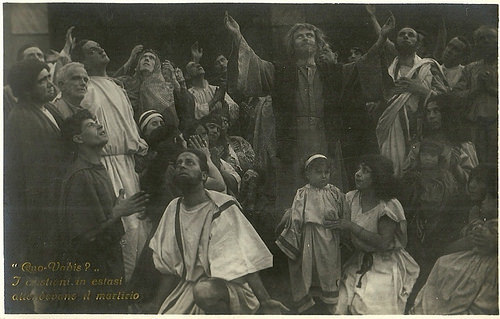
Italian postcard by G.G. Falci, Milano / La Fotominio. Photo: UCI (Unione Cinematografica Italiana). Publicity still for Quo vadis? (Gabriellino D'Annunzio, Georg Jacoby, 1924). Caption: The Christians awaited their martyrdom in ecstasy.
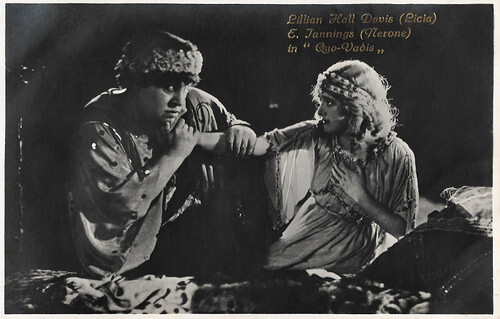
Italian postcard by G.B. Falci, Milano, no. 38. Lilian Hall-Davis as Lygia and Emil Jannings as Nero in Quo Vadis? (Gabriellino D'Annunzio, Georg Jacoby, 1924).
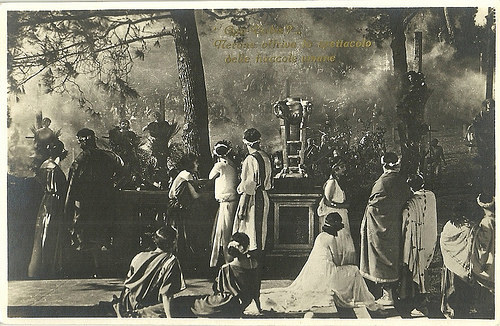
Italian postcard by G.G. Falci, Milano / La Fotominio, no. 156. Photo: UCI (Unione Cinematografica Italiana). Publicity still for Quo vadis? (Gabriellino D'Annunzio, Georg Jacoby, 1924). Caption: Nero offered the spectacle of the human torches.
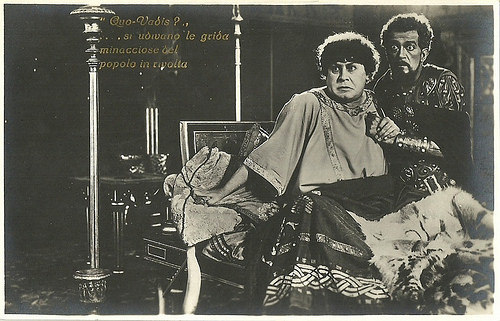
Italian postcard by G.G. Falci, Milano / La Fotominio, no. 159. Photo: UCI (Unione Cinematografica Italiana). Publicity still for Quo vadis? (Gabriellino D'Annunzio, Georg Jacoby, 1924). Caption: They heard the menacing shouts of the revolting mob. Shown are Emil Jannings as Nero and Raimondo Van Riel as Tigellinus. Actually, the scene refers to Nero's nightmare.

Italian postcard by G.B. Falci, Milano in the Fotominio series, no. 159. Gildo Bocci as Vitellius at Nero's orgy in Quo Vadis? (Gabriellino D'Annunzio, Georg Jacoby, 1924).
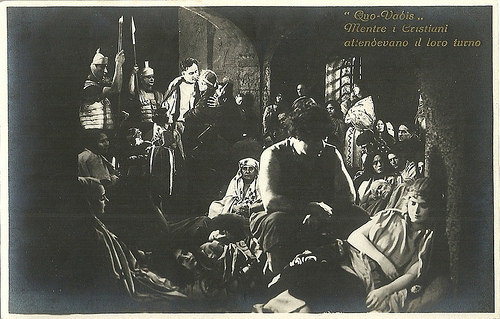
Italian postcard by G.G. Falci, Milano / La Fotominio, no. 163. Photo: UCI (Unione Cinematografica Italiana). Publicity still for Quo vadis? (Gabriellino D'Annunzio, Georg Jacoby, 1924). Caption: While the Christians were awaiting their turn. In the foreground, Ursus ( Bruto Castellani ) is guarding Licia ( Lilian Hall-Davis ). In the background, the light falls on the family of Plautus, Domitilla ( Elga Brink ) and their son (Marcella Sabatini).
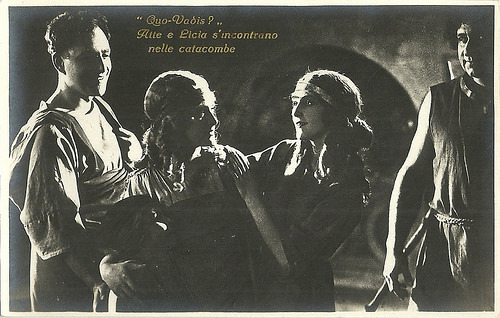
Italian postcard by G.G. Falci, Milano / La Fotominio, no. 165. Photo: UCI (Unione Cinematografica Italiana). Publicity still for Quo vadis? (Gabriellino D'Annunzio, Georg Jacoby, 1924). Caption: Acte and Licia meet again in the catacombs. (But actually, the caption is wrong. Here, Lygia ( Lilian Hall-Davis ) meets again Domitilla ( Elga Brink ), her husband Plautus (name unknown) and their son. On the right Ursus ( Bruto Castellani ).
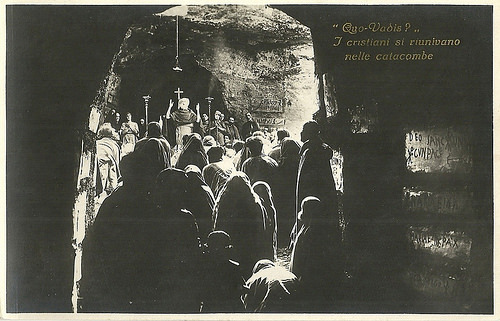
Italian postcard by G.G. Falci, Milano / La Fotominio, no. 168. Photo: UCI (Unione Cinematografica Italiana). Publicity still for Quo vadis? (Gabriellino D'Annunzio, Georg Jacoby, 1924). Caption: The Christians gathered in the catacombs.
Sources: Vittorio Martinelli, Il cinema muto italiano. I film degli anni venti, 1923-1931, Hal Erickson (AllMovie), Marcin Kukuczka (IMDb), Wikipedia and IMDb.
This earlier post at EFSP on Quo vadis? (1924) contains a postcard series published by the Turinese Ed. L'Argentografica.

German postcard by Ross Verlag, no. 699/1, 1919-1924. Photo: Filmhaus Bruckmann. Publicity still for Quo vadis? (Georg Jacoby, Gabriellino D'Annunzio, 1924-1925). Here we see Nero ( Emil Jannings ) going out of his mind when his little son dies.

German postcard by Ross Verlag, no. 699/3, 1919-1924. Photo: Filmhaus Bruckmann. Publicity still for Quo vadis? (Georg Jacoby, Gabriellino D'Annunzio, 1924-1925). Here, Marcus Vinicius ( Alphons Fryland ) tries to seduce the chaste Lygia ( Lilian Hall-Davis ) during an orgy at Nero's palace.

German postcard by Ross Verlag, no. 699/4, 1919-1924. Photo: Filmhaus Bruckmann. Publicity still for Quo vadis? (Gabriellino D'Annunzio, Georg Jacoby, 1925). Marcus Vinicius ( Alphons Fryland ) leads the populace against Nero.

German postcard by Ross Verlag, no. 699/5, 1919-1924. Photo: Filmhaus Bruckmann. Publicity still for Quo vadis? (Georg Jacoby, Gabriellino D'Annunzio, 1924-1925). Here we see Ursus ( Bruto Castellani ) liberating Lygia ( Lilian Hall-Davis ) after he has conquered the raging bull. Castellani's face and hair are clearly drawn afterwards. In the film the nudity is only visible for a fraction of a second.

German postcard by Ross Verlag, Berlin, no. 699/6, 1919-1924. Photo: Filmhaus Brückmann. Publicity still for Quo vadis? (Gabriellino D'Annunzio, Georg Jacoby, 1924) with Rina De Liguoro as Eunice, secretly in love with her master Petronius ( André Habay ).
A huge spectacle
Ten years after the smashing success of director Enrico Guazzoni's colossal epic Quo vadis? (1913), the Unione Cinematografica Italiana (U.C.I.) decided to make a new silent film version.
The Unione Cinematografica Italiana was a Ufa-like or Universal-like merger of many Italian pre-war film companies. Grand old man Arturo Ambrosio was the producer of the third film version, Quo vadis? (1924-1925).
Directors were the German Georg Jacoby and the Italian Gabriellino D' Annunzio, son of Gabriele D'Annunzio, the famous Italian writer and adventurer.
They turned Sienkiewicz's story of Emperor Nero's politically motivated persecution of the early Christians to hush up his own burning of Rome, and of the 'conversion' of an agnostic Roman warrior via the love of a virtuous Christian girl, into a huge spectacle.
Highlights are the 'burning of Rome' scenes and the climactic fights and carnage in the gladiatorial arena. Cinematography was by Giovanni Vitrotti, Alfredo Donelli, and Curt Courant.

Italian postcard by Ed. A. Traldi, Milano, no. 633. Photo: Pinto, Roma. Rina de Liguoro as Eunica in Quo Vadis? (Gabriellino D'Annunzio, Georg Jacoby, 1924).

Italian postcard by Ed. A. Traldi, Milano, no. 651. Photo: Lilian Hall-Davis as Licia/Lygia in Quo vadis? (Gabriellino D'Annunzio, Georg Jacoby, 1924-1925).

Italian postcard by Ed. A. Traldi, Milano, no. 662. Photo: Elga Brink as Domitilla in Quo vadis? (Gabriellino D'Annunzio, Georg Jacoby, 1924-1925).

Italian postcard by Ed. A. Traldi, Milano, no. 663. Photo: Elena Sangro as the Empress Poppaea in Quo vadis? (Gabriellino D'Annunzio, Georg Jacoby, 1924-1925).

Italian postcard by Ed. G.B. Falci, Milano. Photo: Rina De Liguoro as Eunice in Quo vadis? (Gabriellino D' Annunzio, Georg Jacoby, 1924-1925).
A stellar cast
The historical epic was shot in Rome with a stellar cast of international silent stars. One of the brightest stars of the British silent cinema, Lilian Hall-Davis , and Austrian actor Alphons Fryland played the two young lovers Lygia (Licia in Italian) and Marcus Vinicius.
The German actress Elga Brink appeared as Domitilla. She has a spectacular scene, when as a Christian martyr she is first dragged by a chariot through the circus but then manages to climb up the chariot, take the reins and finish the race, to the great joy of the audience. Italian actor André Habay portrayed Marcus' uncle Petronius, Nero's 'arbiter elegantiae', who uses his wit to flatter and mock him at the same time. Italian diva Rina De Liguoro played Petronius' slave Eunice who later on becomes his mistress and dies with him.
And then there was the famous star of the German silent cinema, Emil Jannings , who was cast as the emperor Nero. Hal Erickson at AllMovie : "Jannings tackles the role of Nero with lusty abandon, making this already larger-than-life historical personality even more so." While in the 1913 version Carlo Cattaneo gave a more naive version of Nero, more the victim of his surroundings, Jannings' Nero is clearly a perverse and sadistic man, who enjoys other people's misery, frightens and plays with his courtiers, and hypocritically offers Licia's his help after Vinicius has been too rough to her, only to reveal later on his own real, lustful intentions. It is also clear the filmmakers gave Jannings a much bigger part in the film than his predecessor or than in the novel. The publicity highlighted his presence as the star of the film too.

Italian Postcard by Ed. A. Traldi, Milano, no. 665. Photo: Bruto Castellani as Ursus in Quo vadis? (Gabriellino D' Annunzio, Georg Jacoby, 1924-1925).

Italian postcard by Ed. Romeo Biagi, Bologna, no. 666. Photo: Unione Cinematografica Italiana. Alphons Fryland as Vinicius in Quo vadis? (Gabriellino D' Annunzio, Georg Jacoby, 1924-1925).

Italian postcard by Ed. A. Traldi, Milano, no. 667. Photo: André Habay as Petronius in Quo vadis? (Gabriellino D'Annunzio, Georg Jacoby, 1924-1925).

Italian postcard by Ed. A. Traldi, Milano, no. 668. Photo: Unione Cinematografica Italiano. Publicity still of Emil Jannings as Nero in Quo vadis? (Georg Jacoby, Gabriellino D'Annunzio, 1924-1925).

Italian postcard by Ed. A. Traldi, Milano, no. 669. Photo: Gino Viotti as the lecherous and treacherous Greek Chilo Chilonides in Quo vadis? (Gabriellino D'Annunzio, Georg Jacoby, 1924-1925).

Italian postcard by Ed. A. Traldi, Milano, no. 670. Photo: Raimondo Van Riel as Nero's evil general Tigellinus in Quo vadis? (Gabriellino D'Annunzio, Georg Jacoby, 1924-1925).
Streaks of sadism and nudity
Quo vadis? had its Roman premiere on 16 March 1925. The producer had tried to equal the earlier version of 1913, adding enormous sets, designed by sculptor and architect Armando Brasini, and streaks of sadism & nudity, some already present in the novel such as the human torches, others added to attract audiences, e.g. a female fed to Nero's lampreys.
The 1925 version didn't have the worldwide success of Enrico Guazzoni's earlier film. For various reasons: people were a bit bored with epic films and the censor had ordered cuts, such as the too-explicit scenes of orgy, violence and blood gulping. The producer almost went bankrupt over copyright claims he all had to pay.
It didn't help that the lion tamer Alfred Schneider was convicted because one of his circus lions had bitten and killed an extra.
Still a fascinating film, especially for the performances of Emil Jannings as the evil emperor Nero, Elena Sangro as the empress Poppaea and Bruto Castellani as the strong man Ursus. Castellani had performed the role before in the 1913 version of Quo vadis?
Hal Erickson at AllMovie: "Although not as much of a cinematic landmark as the 1913 version of Quo Vadis?, this 1924 Italian adaptation of the Henryk Sienkiewicz best-seller was a splendidly lavish production, not to mention a worldwide box-office success."

German postcard by Ross Verlag, Berlin, no. 698/1, 1927-1928. Photo: Filmhaus Bruckmann. Emil Jannings as Nero in Quo vadis? (Gabriellino D'Annunzio, Georg Jacoby, 1924).

German postcard by Ross Verlag, Berlin, no. 698/3, 1927-1928. Photo: Filmhaus Bruckman. Lillian Hall-Davis as Lygia in Quo Vadis? (Gabriellino D'Annunzio, Georg Jacoby, 1924).

German postcard by Ross Verlag, Berlin, no. 698/4, 1927-1928. Photo: Filmhaus Bruckmann. Alphons Fryland as Vinicius in Quo vadis? (Gabriellino D'Annunzio, Georg Jacoby, 1924).

German postcard by Ross Verlag, Berlin, no. 698/7, 1927-1928. Photo: Filmhaus Bruckman. Raimondo van Riel as Tigellinus in Quo Vadis? (Gabriellino D'Annunzio, Georg Jacoby, 1924).

German postcard by Ross Verlag, Berlin, no. 698/8, 1927-1928. Photo: Filmhaus Bruckman. Rina De Liguoro as Eunice in Quo Vadis? (Gabriellino D'Annunzio, Georg Jacoby, 1924).
Magnificently restored
Hal Erickson mentions at AllMovie that the subsequent Hollywood popularity of Emil Jannings prompted a reissue of Quo vadis? in 1929. Reportedly a newly recorded musical score was added.
In 1951 Hollywood made a new version with sound and in colour, Quo Vadis (Mervyn LeRoy, 1951). The film stars Robert Taylor, Deborah Kerr , Leo Genn , and Peter Ustinov. It was nominated for eight Academy Awards.
Fifty years later followed a Polish adaptation by Jerzy Kawalerowicz: Quo Vadis (2001). There was also a 1985 mini-series starring Klaus Maria Brandauer as Nero.
Also in 2001, the Dutch Filmmuseum (now Eye Filmmuseum) in Amsterdam restored the silent 1924 version of Quo vadis?, based on various existing copies. This magnificently restored version had its 're-premiere' at the Bologna film festival Cinema Ritrovato in 2002.

Italian postcard. Photo: UCI (Unione Cinematografica Italiana). Publicity still of the scene of the kidnapping of Lygia in Quo vadis? (Gabriellino D'Annunzio, Georg Jacoby, 1924-1925).

Italian postcard by G.G. Falci, Milano / La Fotominio. Photo: UCI (Unione Cinematografica Italiana). Publicity still for Quo vadis? (Gabriellino D'Annunzio, Georg Jacoby, 1924). Caption: The Christians awaited their martyrdom in ecstasy.

Italian postcard by G.B. Falci, Milano, no. 38. Lilian Hall-Davis as Lygia and Emil Jannings as Nero in Quo Vadis? (Gabriellino D'Annunzio, Georg Jacoby, 1924).

Italian postcard by G.G. Falci, Milano / La Fotominio, no. 156. Photo: UCI (Unione Cinematografica Italiana). Publicity still for Quo vadis? (Gabriellino D'Annunzio, Georg Jacoby, 1924). Caption: Nero offered the spectacle of the human torches.

Italian postcard by G.G. Falci, Milano / La Fotominio, no. 159. Photo: UCI (Unione Cinematografica Italiana). Publicity still for Quo vadis? (Gabriellino D'Annunzio, Georg Jacoby, 1924). Caption: They heard the menacing shouts of the revolting mob. Shown are Emil Jannings as Nero and Raimondo Van Riel as Tigellinus. Actually, the scene refers to Nero's nightmare.

Italian postcard by G.B. Falci, Milano in the Fotominio series, no. 159. Gildo Bocci as Vitellius at Nero's orgy in Quo Vadis? (Gabriellino D'Annunzio, Georg Jacoby, 1924).

Italian postcard by G.G. Falci, Milano / La Fotominio, no. 163. Photo: UCI (Unione Cinematografica Italiana). Publicity still for Quo vadis? (Gabriellino D'Annunzio, Georg Jacoby, 1924). Caption: While the Christians were awaiting their turn. In the foreground, Ursus ( Bruto Castellani ) is guarding Licia ( Lilian Hall-Davis ). In the background, the light falls on the family of Plautus, Domitilla ( Elga Brink ) and their son (Marcella Sabatini).

Italian postcard by G.G. Falci, Milano / La Fotominio, no. 165. Photo: UCI (Unione Cinematografica Italiana). Publicity still for Quo vadis? (Gabriellino D'Annunzio, Georg Jacoby, 1924). Caption: Acte and Licia meet again in the catacombs. (But actually, the caption is wrong. Here, Lygia ( Lilian Hall-Davis ) meets again Domitilla ( Elga Brink ), her husband Plautus (name unknown) and their son. On the right Ursus ( Bruto Castellani ).

Italian postcard by G.G. Falci, Milano / La Fotominio, no. 168. Photo: UCI (Unione Cinematografica Italiana). Publicity still for Quo vadis? (Gabriellino D'Annunzio, Georg Jacoby, 1924). Caption: The Christians gathered in the catacombs.
Sources: Vittorio Martinelli, Il cinema muto italiano. I film degli anni venti, 1923-1931, Hal Erickson (AllMovie), Marcin Kukuczka (IMDb), Wikipedia and IMDb.
This earlier post at EFSP on Quo vadis? (1924) contains a postcard series published by the Turinese Ed. L'Argentografica.
Published on October 17, 2023 22:00
October 16, 2023
Piper Laurie (1932-2023)
Last Saturday, 15 October 2023, American stage and screen actress Piper Laurie (1932) died in her hometown Los Angeles. She was known for her roles in the films The Hustler (1961), Carrie (1976), and Children of a Lesser God (1986), all of which brought her Oscar nominations. She is also known for her performances as Kirsten Arnesen in the original TV production of Days of Wine and Roses (1958) and as Catherine Martell in the cult television series Twin Peaks (1990-1991), for which she won a Golden Globe Award in 1991. Laurie, who was 91, received twelve Emmy Award nominations during her long career.

Vintage postcard.
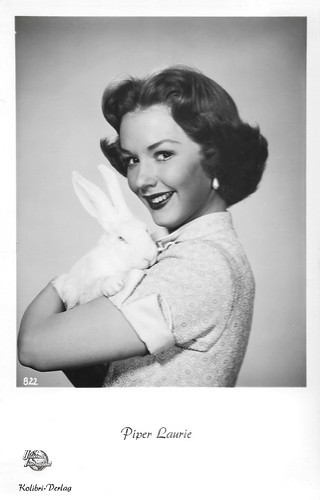
German postcard by Kolibri Verlag, Minden/Westf., no. 822. Photo: Universal International.
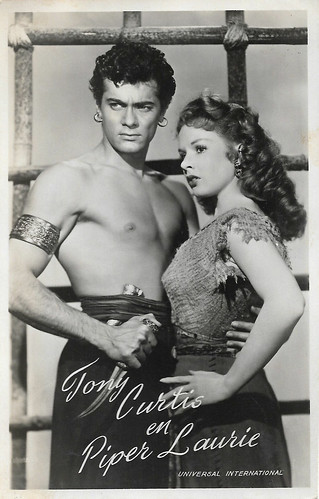
Dutch postcard by Takken, Utrecht, no. 686. Photo: Universal International. Tony Curtis and Piper Laurie in The Prince Who Was A Thief (Rudolph Maté, 1951).
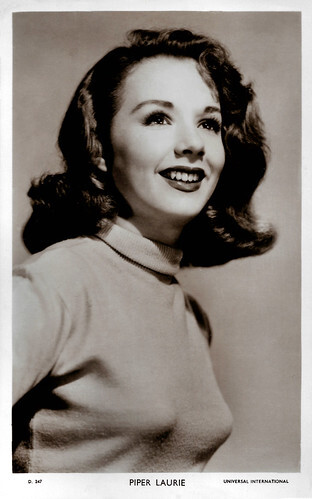
British postcard in the Picturegoer Series, London, no. D 247. Photo: Universal International.
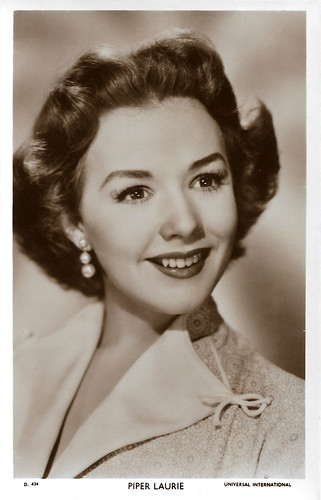
British postcard in the Picturegoer Series, London, no. D. 434. Photo: Universal International.
Bathing in milk and eating flower petals for her luminous skin
Piper Laurie was born Rosetta Jacobs in 1932, in Detroit, Michigan. She was the younger daughter of Charlotte Sadie (née Alperin) and Alfred Jacobs, a furniture dealer. In 1938, the family moved to Los Angeles, where she attended a Hebrew school. For much of her early childhood, her parents placed Laurie and her older sister in a children's home, which they both despised. To combat her shyness, her parents provided her with weekly elocution lessons.
Piper studied acting with Benno and Betomi Schnider for three years. This eventually led to minor roles at nearby Universal Studios. In 1949, Rosetta Jacobs signed a long-term contract with Universal Studios and changed her screen name to Piper Laurie, which she has used since then. At Universal, she met other soon-to-be familiar actors Julie Adams , Tony Curtis and Rock Hudson .
Her breakout role was in the comedy Louisa (Alexander Hall, 1950), with Ronald Reagan , whom she dated a few times before his marriage to Nancy Davis. In her 2011 autobiography 'Learning to Live Out Loud', she claimed that she lost her virginity to him. Several other roles followed: Francis Goes to the Races (Arthur Lubin, 1951) with Donald O'Connor, the Swashbuckler The Prince Who Was a Thief (Rudolph Mate, 1951) with Tony Curtis in his first starring role, and the comedy Has Anybody Seen My Gal? (Douglas Sirk, 1952) with Rock Hudson .
To enhance her image, Universal Studios told gossip columnists that Laurie bathed in milk and ate flower petals to protect her luminous skin. Other films were the adventures Son of Ali Baba (Kurt Neumann, 1952) again opposite Tony Curtis , and The Golden Blade (Nathan Juran, 1953) again co-starring Rock Hudson . She also co-starred with Rory Calhoun in the Western Dawn at Socorro (George Sherman, 1954), and the musical Ain't Misbehavin' (Edward Buzzell, 1955).
Discouraged by the lack of serious film roles, she moved to New York to study acting and to seek work on the stage and on television. She appeared on TV in Twelfth Night, produced by Hallmark Hall of Fame, Days of Wine and Roses (John Frankenheimer, 1958) with Cliff Robertson, presented by Playhouse 90 (in the film version, their roles were taken over by Jack Lemmon and Lee Remick), and opposite Martin Balsam in Winterset (George Schaefer, 1959), also presented by Playhouse 90.
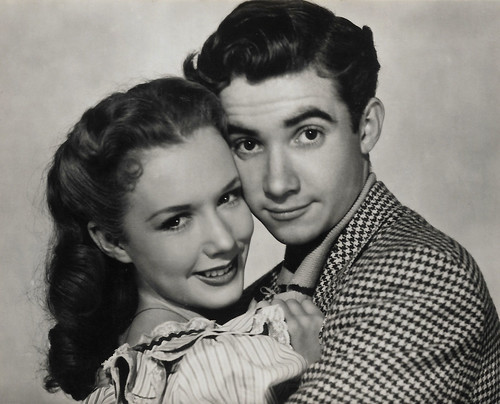
Vintage collectors card. Photo: Universal International. Piper Laurie and Scotty Beckett in Louisa (Alexander Hall, 1950).
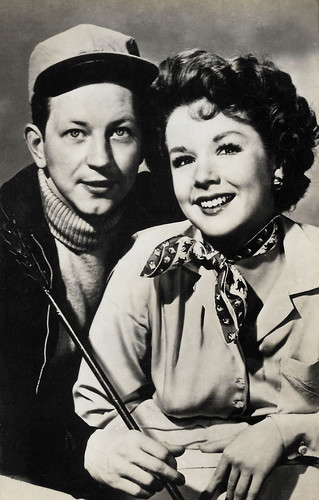
Spanish postcard. Photo: Universal International. Piper Laurie and Donald O'Connor in Francis Goes to the Races (Arthur Lubin, 1951).
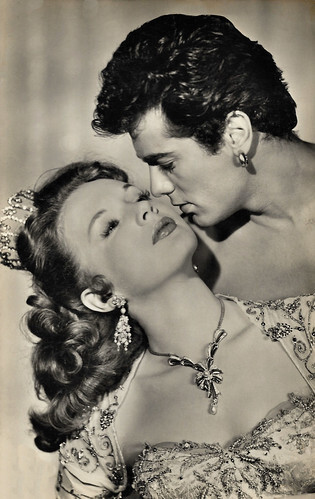
Spanish postcard by Archivo Bermejo, no. 4942. Photo: Universal International. Piper Laurie and Tony Curtis in The Prince Who Was a Thief (Rudolph Mate, 1951).
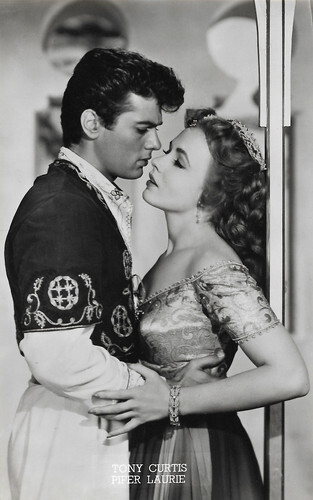
Vintage postcard. Photo: Universal International. Piper Laurie and Tony Curtis in The Prince Who Was a Thief (Rudolph Mate, 1951).
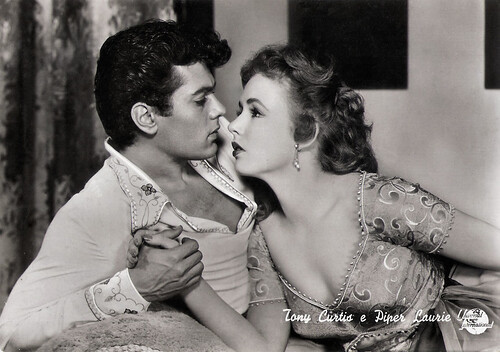
Italian postcard by Bromofoto, Milano, no. 400. Photo: Universal International. Tony Curtis and Piper Laurie in The Prince Who Was A Thief (Rudolph Maté, 1951).
Supernatural horror
Piper Laurie was again lured to Hollywood by the offer to co-star with Paul Newman in The Hustler (Robert Rossen, 1961). She played Newman's girlfriend, Sarah Packard, and for her performance, she received an Academy Award nomination for Best Actress. The Hustler was a major critical and popular success, gaining a reputation as a modern classic.
However, substantial film roles did not come her way, so Laurie and her husband moved to New York. In 1964, she appeared in two TV medical dramas — as Alicia Carter in The Eleventh Hour episode 'My Door Is Locked and Bolted', and as Alice Marin in the Breaking Point episode 'The Summer House'.
In 1965, she starred in a Broadway revival of Tennessee Williams' 'The Glass Menagerie', opposite Maureen Stapleton, Pat Hingle, and George Grizzard. She devoted her energies to the Civil Rights movement and to the Vietnam War, feeling acting was less important.
Laurie did not appear in another feature film until she accepted the role of Margaret White in the supernatural horror film Carrie (Brian De Palma, 1976). Her co-star, Sissy Spacek, praised her acting skill: "She is a remarkable actress. She never does what you expect her to do — she always surprises you with her approach to a scene." Laurie received an Oscar nomination for Best Supporting Actress, and the commercial success of the film relaunched her career.
She appeared in the horror drama Ruby (Curtis Harrington, 1977) and as Mary Horton in the Australian romance Tim (Michael Pate, 1979) opposite Mel Gibson . After her 1981 divorce, Laurie relocated to California. She received a third Oscar nomination for her portrayal of Mrs. Norman in Children of a Lesser God (Randa Haines, 1986). That same year, she was awarded an Emmy for her performance in the TV film Promise (Glenn Jordan, 1986), co-starring James Garner and James Woods.
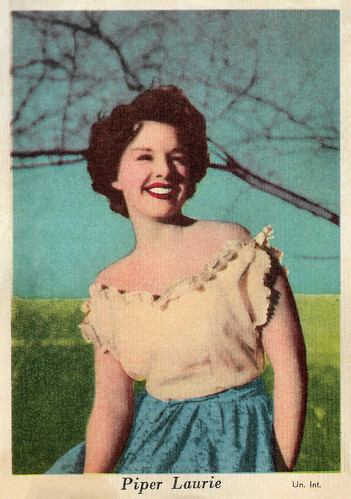
Vintage postcard. Photo: Universal International.
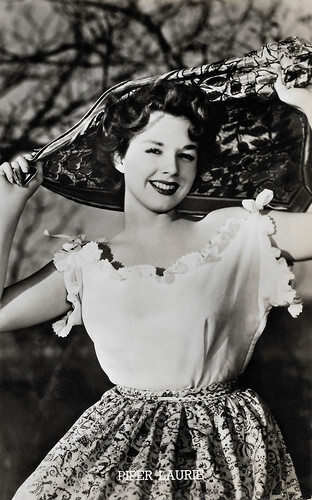
Belgian postcard. Photo: Universal International.
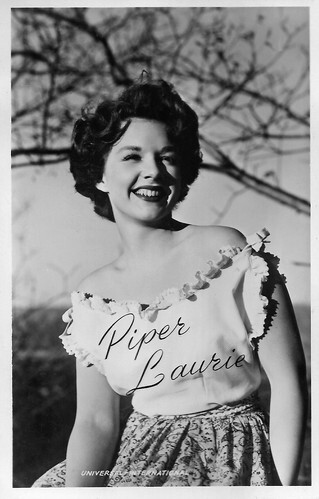
Dutch postcard by Takken / 't Sticht, no. 780. Photo: Universal-International.
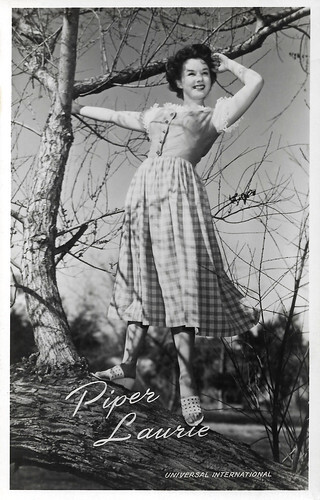
Dutch postcard by Takken, no. 1525. Photo: Universal International.
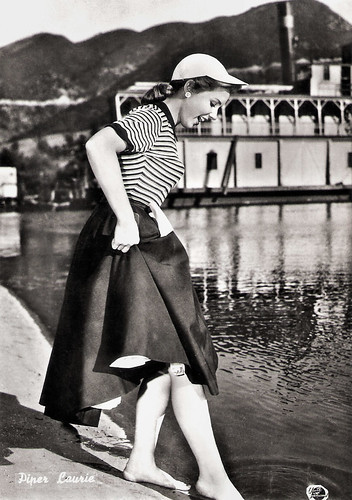
Italian postcard by Bromofoto, Milano, no. 1238. Photo: Universal International.
Twelve Emmy nominations
In 1990-1991, Piper Laurie starred as the devious Catherine Martell in David Lynch's television series Twin Peaks. She also appeared in Other People's Money (Norman Jewison, 1991) with Danny DeVito and Gregory Peck , and in horror maestro Dario Argento's first American film, Trauma (1993) with Asia Argento, the director's daughter.
On stage, she had a featured role in the Off-Broadway production of 'The Destiny of Me' in 1992, and later returned to Broadway for Lincoln Center's acclaimed 2002 revival of Paul Osborn's 'Morning's at Seven', with Julie Hagerty and Estelle Parsons. On television, she played George Clooney 's character's mother on ER (1995). Then, she appeared with Patty Duke in the TV film A Christmas Memory (Glenn Jordan, 1997) based on the story by Truman Capote, and in the Sci-Fi thriller The Faculty (Robert Rodriguez, 1998) with Josh Hartnett and Elijah Wood.
She made guest appearances on television shows such as Matlock (1986), Frasier (1994 and 1999) and Will & Grace (2000). Laurie also appeared in an episode of Law & Order: Special Victims Unit (2001) and in Cold Case (2005). She returned to the big screen for independent films, such as Eulogy (Michael Clancy, 2004) and The Dead Girl (Karen Moncrieff, 2006), opposite Toni Collette.
Piper Laurie was married once, to New York Herald Tribune entertainment writer Joe Morgenstern. They met shortly after the release of The Hustler in 1961 when Morgenstern interviewed her during the film's promotion. They soon began dating, and nine months after the interview, they were married in 1962. In 1971, they had a daughter, Anne Grace Morgenstern. In 1982, the couple divorced, after which she relocated to the Hollywood area and continued working in films and television. Laurie won an Emmy Award for her role in Promise (Glenn Jordan, 1986).
In total, she received twelve Emmy nominations, including one for playing Magda Goebbels, wife of Joseph Goebbels, in The Bunker (George Schaefer, 1981), opposite Anthony Hopkins as Hitler, one for her role in the miniseries, The Thorn Birds (Daryl Duke, 1983), two nominations for her work in Twin Peaks, as Catherine Martell, and a nomination for her guest appearance on Frasier. She has been nominated for an Academy Award for her performances in three films. Piper Laurie remained active. She appeared in the films Snapshots (Melanie Mayron, 2018) and White Boy Rick (Yann Demange, 2018), starring Matthew McConaughey and this year she could be heard in an episode of the podcast series Around the Sun (Brad Forenza, 2022-2023), as alien Maude!
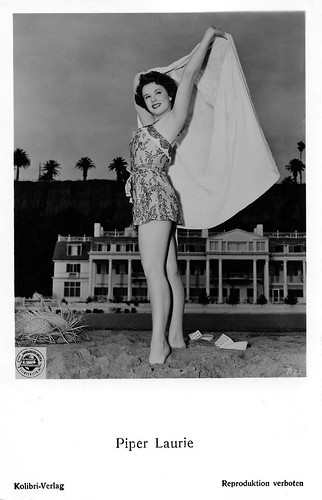
German postcard by Kolibri-Verlag. Photo: Universal International.
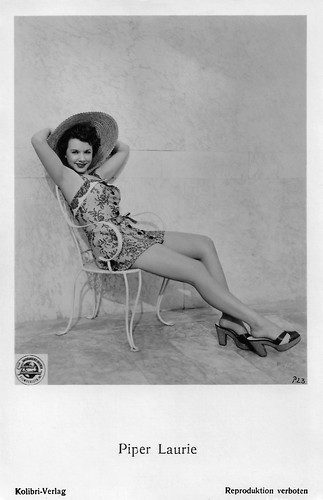
German postcard by Kolibri-Verlag. Photo: Universal International.
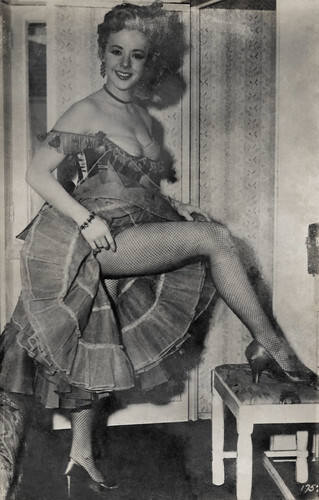
Spanish postcard by Archivo Bermejo, no. 248 / 6679.
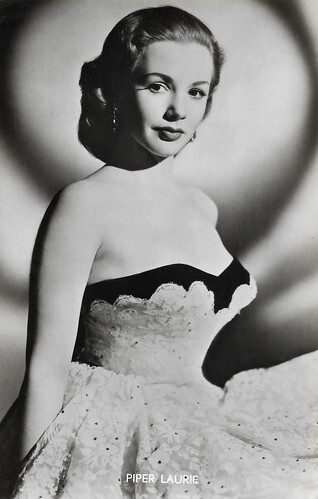
Belgian postcard. Photo: Universal.
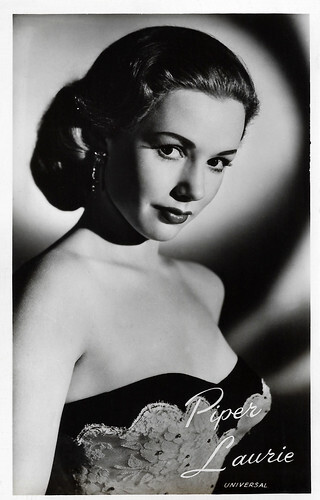
Dutch postcard by Takken / 't Sticht, no. 1492. Photo: Universal.
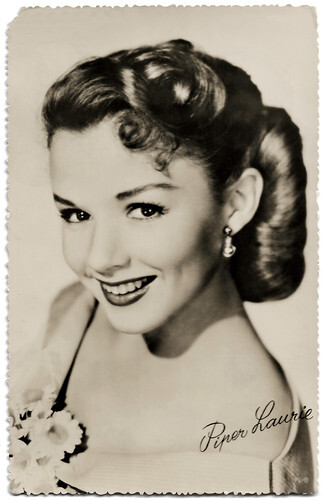
Dutch postcard by DRC, no. F 191, sent by mail in 1958. Photo: Universal International.
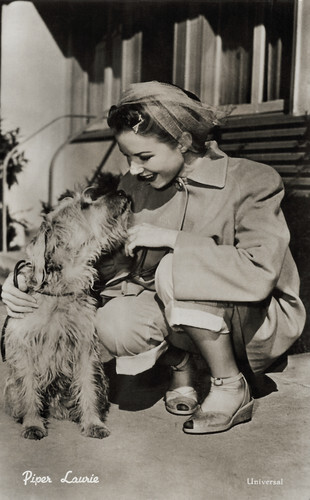
Vintage postcard. Photo: Universal.
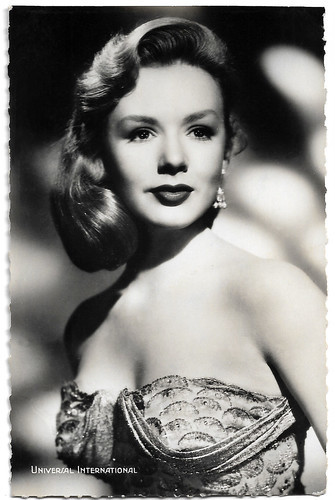
French postcard by Editions du Globe, no. 476. Photo: Universal International.
Sources: Wikipedia and .

Vintage postcard.

German postcard by Kolibri Verlag, Minden/Westf., no. 822. Photo: Universal International.

Dutch postcard by Takken, Utrecht, no. 686. Photo: Universal International. Tony Curtis and Piper Laurie in The Prince Who Was A Thief (Rudolph Maté, 1951).

British postcard in the Picturegoer Series, London, no. D 247. Photo: Universal International.

British postcard in the Picturegoer Series, London, no. D. 434. Photo: Universal International.
Bathing in milk and eating flower petals for her luminous skin
Piper Laurie was born Rosetta Jacobs in 1932, in Detroit, Michigan. She was the younger daughter of Charlotte Sadie (née Alperin) and Alfred Jacobs, a furniture dealer. In 1938, the family moved to Los Angeles, where she attended a Hebrew school. For much of her early childhood, her parents placed Laurie and her older sister in a children's home, which they both despised. To combat her shyness, her parents provided her with weekly elocution lessons.
Piper studied acting with Benno and Betomi Schnider for three years. This eventually led to minor roles at nearby Universal Studios. In 1949, Rosetta Jacobs signed a long-term contract with Universal Studios and changed her screen name to Piper Laurie, which she has used since then. At Universal, she met other soon-to-be familiar actors Julie Adams , Tony Curtis and Rock Hudson .
Her breakout role was in the comedy Louisa (Alexander Hall, 1950), with Ronald Reagan , whom she dated a few times before his marriage to Nancy Davis. In her 2011 autobiography 'Learning to Live Out Loud', she claimed that she lost her virginity to him. Several other roles followed: Francis Goes to the Races (Arthur Lubin, 1951) with Donald O'Connor, the Swashbuckler The Prince Who Was a Thief (Rudolph Mate, 1951) with Tony Curtis in his first starring role, and the comedy Has Anybody Seen My Gal? (Douglas Sirk, 1952) with Rock Hudson .
To enhance her image, Universal Studios told gossip columnists that Laurie bathed in milk and ate flower petals to protect her luminous skin. Other films were the adventures Son of Ali Baba (Kurt Neumann, 1952) again opposite Tony Curtis , and The Golden Blade (Nathan Juran, 1953) again co-starring Rock Hudson . She also co-starred with Rory Calhoun in the Western Dawn at Socorro (George Sherman, 1954), and the musical Ain't Misbehavin' (Edward Buzzell, 1955).
Discouraged by the lack of serious film roles, she moved to New York to study acting and to seek work on the stage and on television. She appeared on TV in Twelfth Night, produced by Hallmark Hall of Fame, Days of Wine and Roses (John Frankenheimer, 1958) with Cliff Robertson, presented by Playhouse 90 (in the film version, their roles were taken over by Jack Lemmon and Lee Remick), and opposite Martin Balsam in Winterset (George Schaefer, 1959), also presented by Playhouse 90.

Vintage collectors card. Photo: Universal International. Piper Laurie and Scotty Beckett in Louisa (Alexander Hall, 1950).

Spanish postcard. Photo: Universal International. Piper Laurie and Donald O'Connor in Francis Goes to the Races (Arthur Lubin, 1951).

Spanish postcard by Archivo Bermejo, no. 4942. Photo: Universal International. Piper Laurie and Tony Curtis in The Prince Who Was a Thief (Rudolph Mate, 1951).

Vintage postcard. Photo: Universal International. Piper Laurie and Tony Curtis in The Prince Who Was a Thief (Rudolph Mate, 1951).

Italian postcard by Bromofoto, Milano, no. 400. Photo: Universal International. Tony Curtis and Piper Laurie in The Prince Who Was A Thief (Rudolph Maté, 1951).
Supernatural horror
Piper Laurie was again lured to Hollywood by the offer to co-star with Paul Newman in The Hustler (Robert Rossen, 1961). She played Newman's girlfriend, Sarah Packard, and for her performance, she received an Academy Award nomination for Best Actress. The Hustler was a major critical and popular success, gaining a reputation as a modern classic.
However, substantial film roles did not come her way, so Laurie and her husband moved to New York. In 1964, she appeared in two TV medical dramas — as Alicia Carter in The Eleventh Hour episode 'My Door Is Locked and Bolted', and as Alice Marin in the Breaking Point episode 'The Summer House'.
In 1965, she starred in a Broadway revival of Tennessee Williams' 'The Glass Menagerie', opposite Maureen Stapleton, Pat Hingle, and George Grizzard. She devoted her energies to the Civil Rights movement and to the Vietnam War, feeling acting was less important.
Laurie did not appear in another feature film until she accepted the role of Margaret White in the supernatural horror film Carrie (Brian De Palma, 1976). Her co-star, Sissy Spacek, praised her acting skill: "She is a remarkable actress. She never does what you expect her to do — she always surprises you with her approach to a scene." Laurie received an Oscar nomination for Best Supporting Actress, and the commercial success of the film relaunched her career.
She appeared in the horror drama Ruby (Curtis Harrington, 1977) and as Mary Horton in the Australian romance Tim (Michael Pate, 1979) opposite Mel Gibson . After her 1981 divorce, Laurie relocated to California. She received a third Oscar nomination for her portrayal of Mrs. Norman in Children of a Lesser God (Randa Haines, 1986). That same year, she was awarded an Emmy for her performance in the TV film Promise (Glenn Jordan, 1986), co-starring James Garner and James Woods.

Vintage postcard. Photo: Universal International.

Belgian postcard. Photo: Universal International.

Dutch postcard by Takken / 't Sticht, no. 780. Photo: Universal-International.

Dutch postcard by Takken, no. 1525. Photo: Universal International.

Italian postcard by Bromofoto, Milano, no. 1238. Photo: Universal International.
Twelve Emmy nominations
In 1990-1991, Piper Laurie starred as the devious Catherine Martell in David Lynch's television series Twin Peaks. She also appeared in Other People's Money (Norman Jewison, 1991) with Danny DeVito and Gregory Peck , and in horror maestro Dario Argento's first American film, Trauma (1993) with Asia Argento, the director's daughter.
On stage, she had a featured role in the Off-Broadway production of 'The Destiny of Me' in 1992, and later returned to Broadway for Lincoln Center's acclaimed 2002 revival of Paul Osborn's 'Morning's at Seven', with Julie Hagerty and Estelle Parsons. On television, she played George Clooney 's character's mother on ER (1995). Then, she appeared with Patty Duke in the TV film A Christmas Memory (Glenn Jordan, 1997) based on the story by Truman Capote, and in the Sci-Fi thriller The Faculty (Robert Rodriguez, 1998) with Josh Hartnett and Elijah Wood.
She made guest appearances on television shows such as Matlock (1986), Frasier (1994 and 1999) and Will & Grace (2000). Laurie also appeared in an episode of Law & Order: Special Victims Unit (2001) and in Cold Case (2005). She returned to the big screen for independent films, such as Eulogy (Michael Clancy, 2004) and The Dead Girl (Karen Moncrieff, 2006), opposite Toni Collette.
Piper Laurie was married once, to New York Herald Tribune entertainment writer Joe Morgenstern. They met shortly after the release of The Hustler in 1961 when Morgenstern interviewed her during the film's promotion. They soon began dating, and nine months after the interview, they were married in 1962. In 1971, they had a daughter, Anne Grace Morgenstern. In 1982, the couple divorced, after which she relocated to the Hollywood area and continued working in films and television. Laurie won an Emmy Award for her role in Promise (Glenn Jordan, 1986).
In total, she received twelve Emmy nominations, including one for playing Magda Goebbels, wife of Joseph Goebbels, in The Bunker (George Schaefer, 1981), opposite Anthony Hopkins as Hitler, one for her role in the miniseries, The Thorn Birds (Daryl Duke, 1983), two nominations for her work in Twin Peaks, as Catherine Martell, and a nomination for her guest appearance on Frasier. She has been nominated for an Academy Award for her performances in three films. Piper Laurie remained active. She appeared in the films Snapshots (Melanie Mayron, 2018) and White Boy Rick (Yann Demange, 2018), starring Matthew McConaughey and this year she could be heard in an episode of the podcast series Around the Sun (Brad Forenza, 2022-2023), as alien Maude!

German postcard by Kolibri-Verlag. Photo: Universal International.

German postcard by Kolibri-Verlag. Photo: Universal International.

Spanish postcard by Archivo Bermejo, no. 248 / 6679.

Belgian postcard. Photo: Universal.

Dutch postcard by Takken / 't Sticht, no. 1492. Photo: Universal.

Dutch postcard by DRC, no. F 191, sent by mail in 1958. Photo: Universal International.

Vintage postcard. Photo: Universal.

French postcard by Editions du Globe, no. 476. Photo: Universal International.
Sources: Wikipedia and .
Published on October 16, 2023 22:00
October 15, 2023
Elza Temary
Elza Temary (1905-1968) was a Hungarian film actress, who acted in several German silent and early German films. She moved to the USA when Hitler rose to power.
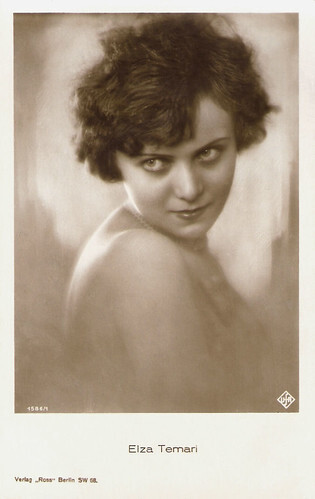
German postcard by Ross Verlag, Berlin, no. 1586/1, 1927-1928. Photo: Ufa.
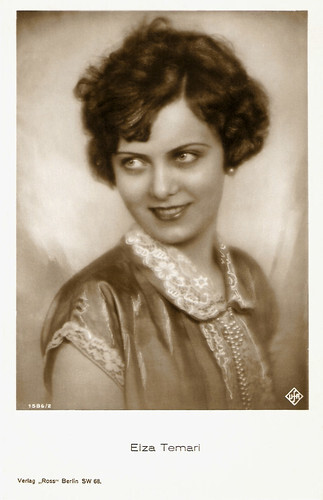
German postcard by Ross Verlag, Berlin, no. 1586/2, 1927-1928. Photo: Ufa.
Adam and Eve
Elza Temary or Elsa Temari (and variations) was born Elza Klecker in Temeswar, Austria-Hungary (today Timișoara, Romania) in 1905.
One of her first films was the crime film Harry Hill im Banne der Todesstrahlen/Harry Hill under the spell of the death rays (Valy Arnheim, 1925), an episode in the Harry Hill series. The film was forbidden for unknown reasons and was probably never shown in a theatre.
She had a big supporting part in the silent drama Unser täglich Brot/Our Daily Bread (Constantin J. David, 1926) starring Fritz Kampers , Mary Nolan and Dina Gralla . She played the female lead in the silent crime film Der Bettler vom Kölner Dom/The Beggar from Cologne Cathedral (Rolf Randolf, 1927) starring Henry Stuart .
She co-starred with Reinhold Schünzel in the silent comedy Adam und Eva/Adam and Eve (Rudolf Biebrach, 1928). Then followed the comedy Gefahren der Brautzeit/Dangers of the Engagement Period (Fred Sauer, 1930) starring Marlene Dietrich and Willi Forst . It was Dietrich's last film before her breakthrough role in Der blaue Engel/The Blue Angel (Josef von Sternberg, 1930), which made her an international star and led to her departure for Hollywood.
Temary played a spy in the drama Rasputin, Dämon der Frauen/Rasputin, Demon with Women (Adolf Trotz, 1932) starring Conrad Veidt in the title role. It portrays the influence wielded by Grigori Rasputin over the Russian Royal Family around the time of the First World War. It was released the same year as an American film about him, Rasputin and the Empress (Richard Boleslawski, Charles Brabin, 1932), starring Lionel Barrymore as Rasputin and his sister Ethel Barrymore as the Empress.
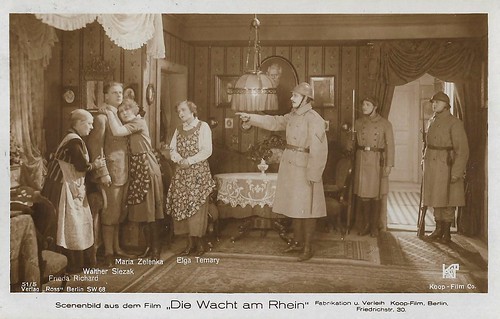
German postcard by Ross Verlag, Berlin, no. 51/5. Photo: Koop-Film, Berlin. Walter Slezak as Walter Thiermann, engineer of Franz Großmann, surrounded by his old mother (Frida Richard), his beloved Maria ( Maria Zelenka ), and his sister Renate (Elza Temary) in Die Wacht am Rhein. Aus des Rheinlands Schicksalstagen/The Watch on the Rhine. From the fateful days of the Rhineland (Helene Lackner, 1925-1926). Elza is misspelt as Elga here.
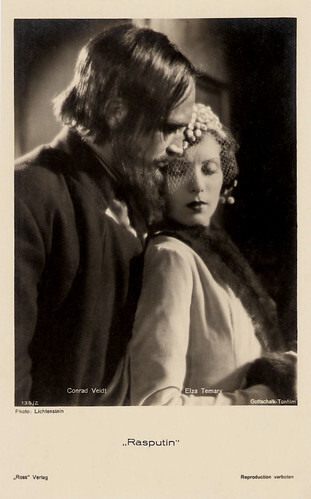
German postcard by Ross Verlag, no. 135/2. Photo: Lichtenstein / Gottschalk Tonfilm. Conrad Veidt and Elza Temary in Rasputin, Dämon der Frauen / Rasputin (Adolph Trotz, 1932). Conrad Veidt plays the legendary mystic who ruled the czarist court in its last years, as the czarina hoped he could heal her son's haemophilia. In the end, he was murdered in 1916 by a number of aristocrats, but not before predicting the downfall of the regime.
A socialite wife
Elza Temary's film career in Berlin ended abruptly as Hitler took power. In 1933, she left Germany on board the passenger steamer Albert Ballin.
She married American wildlife photographer/socialite Philip Chancellor in London. The couple moved to Montecito, California, next to Santa Barbara. As Elza Chancellor, she was then occasionally in the press as a socialite and as Philip's wife.
The Chancellors later moved to Los Angeles and in 1937 to Beverly Hills. In 1937-1938, Elza's husband, Philip was a witness in a trial. A British man, an alleged Nazi, was accused of attempting to extort money from Philip.
Allegedly, the man wanted to fund the assassination of 24 prominent Hollywood Jews. The accused man was allowed to quickly leave the country and return to England.
After World War II, the Chancellors divorced and in 1946, Elza married Howard S. Splane. In 1956, the couple relocated to Tucson, Arizona. There, Elza Temary died in 1968. Her husband had passed away a year earlier.
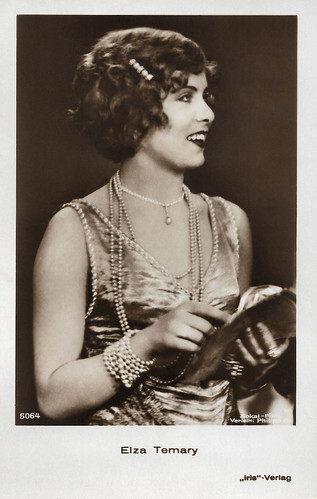
Austrian postcard by Iris Verlag, no. 5064. Photo: Sokal-Film / Verleih Philipp & Co. Elza Temary acted in the German Sokal-Film production Die Spielerin/Chance the Idol (Graham Cutts, 1927), starring Jack Trevor and Agnes Esterhazy . Graham Cutts was working in Germany at the time for Gainsborough Pictures. Romanian-born German producer Harry R. Sokal was married to Esterhazy, who had the female lead or major supporting parts in several of his films from the 1920s.
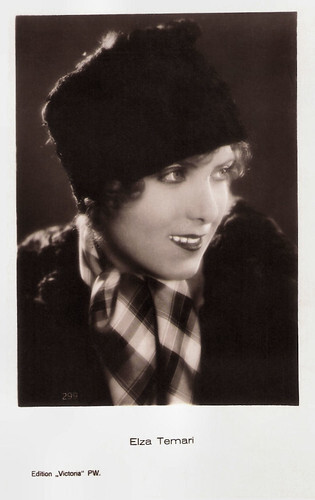
Polish postcard by Edition Victoria, no. 299.
Sources: Wikipedia (German and English) and .

German postcard by Ross Verlag, Berlin, no. 1586/1, 1927-1928. Photo: Ufa.

German postcard by Ross Verlag, Berlin, no. 1586/2, 1927-1928. Photo: Ufa.
Adam and Eve
Elza Temary or Elsa Temari (and variations) was born Elza Klecker in Temeswar, Austria-Hungary (today Timișoara, Romania) in 1905.
One of her first films was the crime film Harry Hill im Banne der Todesstrahlen/Harry Hill under the spell of the death rays (Valy Arnheim, 1925), an episode in the Harry Hill series. The film was forbidden for unknown reasons and was probably never shown in a theatre.
She had a big supporting part in the silent drama Unser täglich Brot/Our Daily Bread (Constantin J. David, 1926) starring Fritz Kampers , Mary Nolan and Dina Gralla . She played the female lead in the silent crime film Der Bettler vom Kölner Dom/The Beggar from Cologne Cathedral (Rolf Randolf, 1927) starring Henry Stuart .
She co-starred with Reinhold Schünzel in the silent comedy Adam und Eva/Adam and Eve (Rudolf Biebrach, 1928). Then followed the comedy Gefahren der Brautzeit/Dangers of the Engagement Period (Fred Sauer, 1930) starring Marlene Dietrich and Willi Forst . It was Dietrich's last film before her breakthrough role in Der blaue Engel/The Blue Angel (Josef von Sternberg, 1930), which made her an international star and led to her departure for Hollywood.
Temary played a spy in the drama Rasputin, Dämon der Frauen/Rasputin, Demon with Women (Adolf Trotz, 1932) starring Conrad Veidt in the title role. It portrays the influence wielded by Grigori Rasputin over the Russian Royal Family around the time of the First World War. It was released the same year as an American film about him, Rasputin and the Empress (Richard Boleslawski, Charles Brabin, 1932), starring Lionel Barrymore as Rasputin and his sister Ethel Barrymore as the Empress.

German postcard by Ross Verlag, Berlin, no. 51/5. Photo: Koop-Film, Berlin. Walter Slezak as Walter Thiermann, engineer of Franz Großmann, surrounded by his old mother (Frida Richard), his beloved Maria ( Maria Zelenka ), and his sister Renate (Elza Temary) in Die Wacht am Rhein. Aus des Rheinlands Schicksalstagen/The Watch on the Rhine. From the fateful days of the Rhineland (Helene Lackner, 1925-1926). Elza is misspelt as Elga here.

German postcard by Ross Verlag, no. 135/2. Photo: Lichtenstein / Gottschalk Tonfilm. Conrad Veidt and Elza Temary in Rasputin, Dämon der Frauen / Rasputin (Adolph Trotz, 1932). Conrad Veidt plays the legendary mystic who ruled the czarist court in its last years, as the czarina hoped he could heal her son's haemophilia. In the end, he was murdered in 1916 by a number of aristocrats, but not before predicting the downfall of the regime.
A socialite wife
Elza Temary's film career in Berlin ended abruptly as Hitler took power. In 1933, she left Germany on board the passenger steamer Albert Ballin.
She married American wildlife photographer/socialite Philip Chancellor in London. The couple moved to Montecito, California, next to Santa Barbara. As Elza Chancellor, she was then occasionally in the press as a socialite and as Philip's wife.
The Chancellors later moved to Los Angeles and in 1937 to Beverly Hills. In 1937-1938, Elza's husband, Philip was a witness in a trial. A British man, an alleged Nazi, was accused of attempting to extort money from Philip.
Allegedly, the man wanted to fund the assassination of 24 prominent Hollywood Jews. The accused man was allowed to quickly leave the country and return to England.
After World War II, the Chancellors divorced and in 1946, Elza married Howard S. Splane. In 1956, the couple relocated to Tucson, Arizona. There, Elza Temary died in 1968. Her husband had passed away a year earlier.

Austrian postcard by Iris Verlag, no. 5064. Photo: Sokal-Film / Verleih Philipp & Co. Elza Temary acted in the German Sokal-Film production Die Spielerin/Chance the Idol (Graham Cutts, 1927), starring Jack Trevor and Agnes Esterhazy . Graham Cutts was working in Germany at the time for Gainsborough Pictures. Romanian-born German producer Harry R. Sokal was married to Esterhazy, who had the female lead or major supporting parts in several of his films from the 1920s.

Polish postcard by Edition Victoria, no. 299.
Sources: Wikipedia (German and English) and .
Published on October 15, 2023 22:00
October 14, 2023
Jean Parker
American film and stage actress Jean Parker (1915–2005) landed her first screen test while still in high school. She played the tragic Beth in the original Little Women (1933), starred as the spoiled daughter of an American chain store millionaire who persuades her nouveau riche father to transport a Scottish castle in the hilarious British fantasy-comedy The Ghost Goes West (1936), and she was a perfect stooge for Stan Laurel and Oliver Hardy, as an innkeeper's daughter with whom Ollie falls in love in The Flying Deuces (1939).

British postcard by Art Photo, no. 177.
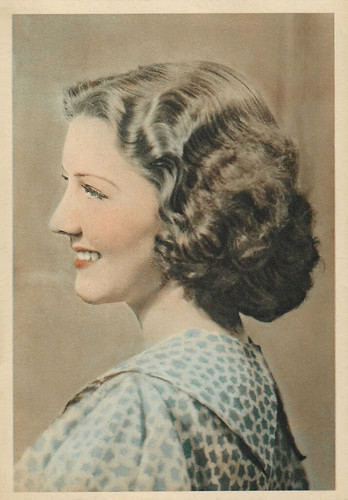
British postcard by De Reszke Cigarettes, no. 40. Photo: M.G.M.

British postcard in the Colourgraph Series, London, no. C 203a. Photo: Paramount.
Winning a poster-painting contest
Jean Parker was born Lois Mae Green in 1915. Her father was Lewis Green, a gunsmith and hunter, and her mother was Pearl Melvina Burch. Later, her mother worked at MGM in the set department and created magnificent flowers, trees and other greenery for such notable films as National Velvet (1944), known professionally as Mildred Brenner.
Lois was an accomplished gymnast and dancer. At age 10, she was adopted by the Spickard family of Pasadena when both her father and mother were unemployed during the Great Depression. She initially aspired to be an illustrator and artist. At 17, she entered a poster-painting contest and won for portraying Father Time.
After a photograph of her was published in a Los Angeles newspaper, Ida Koverman, the assistant to MGM studio chief Louis B. Mayer, contacted the would-be starlet and had Mayer offer her an MGM contract.
She made her feature film debut in the pre-code drama Divorce in the Family (Charles Reisner, 1932), before being loaned to Columbia Pictures, who cast her in Frank Capra's Lady for a Day (1933).
Parker made several important films in the following years, including Little Women (George Cukor, 1933) with Joan Bennett and Katharine Hepburn ; Sequoia (Chester M. Franklin, Edwin L. Marin, 1934) with Russell Hardie, shot in the Sequoia National Forest near Springville, California; Operator 13 (Richard Boleslawski, 1934) with Marion Davies and Gary Cooper ; and The Ghost Goes West (René Clair, 1935) with Robert Donat .
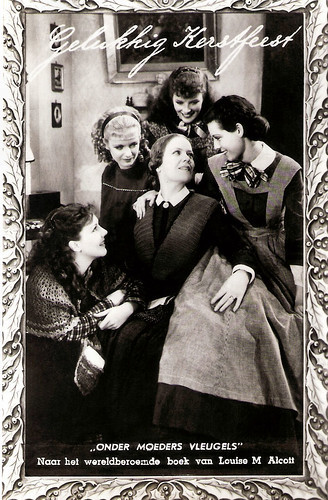
Dutch postcard by the Rialto Theatre, Amsterdam, 1934. Photo: Remaco Radio Picture. Publicity still for Little Women (George Cukor, 1933). In the picture are Katharine Hepburn , Joan Bennett , Frances Dee, Jean Parker and Spring Byington. The Dutch title of the film and the book by Louise M. Alcott is Onder moeders vleugels.
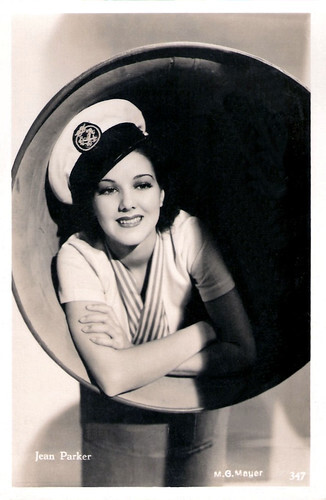
Dutch postcard by JosPe, Arnhem, no. 347. Photo: M.G.M.
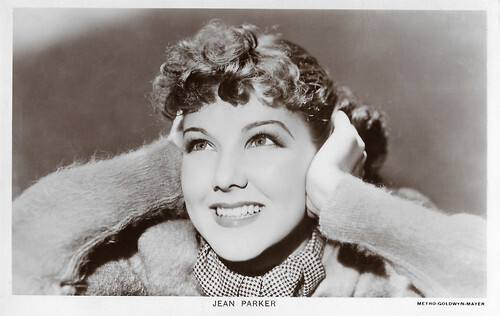
British postcard in the Picturegoer Series, London, no. 950. Photo: Metro Goldwyn Mayer (M.G.M.).
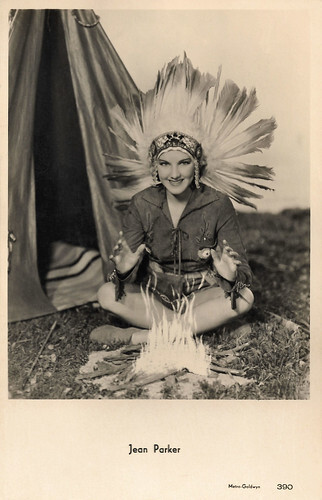
Dutch postcard by JosPe, Arnhem, no. 390. Photo: Metro Goldwyn Mayer.
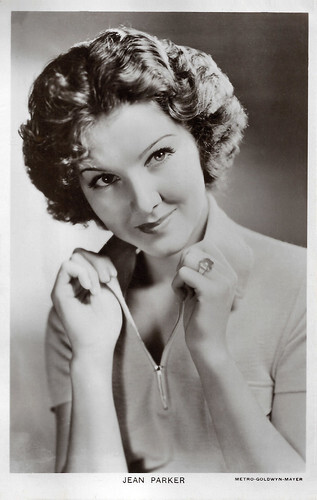
British postcard in the Picturegoer Series, London, no. 810. Photo: Metro-Goldwyn-Mayer.
Entertaining injured servicemen during World War II
Jean Parker remained active in film throughout the 1940s. Parker later starred in the Laurel and Hardy comedy The Flying Deuces (A. Edward Sutherland, 1939), followed by the sports film The Pittsburgh Kid (Jack Townley, 1941), and the Film Noir Dead Man's Eyes (Reginald Le Borg, 1944), opposite Lon Chaney Jr.
After several successful cross-country trips entertaining injured servicemen during World War II, Jean Parker wed and divorced Curt Grotter of the Braille Institute in Los Angeles, and moved on to New York to star in the play 'Loco'. She also starred on Broadway in 'Burlesque' (1946-1947) with Bert Lahr, and in the hit 'Born Yesterday' (1948), filling in for Judy Holliday.
Parker's fourth and last husband, actor Robert Lowery, played opposite her as Brock in the play for a short stint. By this marriage, Parker bore her only child, a son, Robert Lowery Hanks.
By the 1950s, Parker's film career had slowed, though she continued to appear in supporting parts in the Westerns The Gunfighter (Henry King, 1950) with Gregory Peck and Toughest Man in Arizona (R. G. Springsteen, 1952), and the Film Noir Black Tuesday (Hugo Fregonese, 1954) opposite Edward G. Robinson . Parker made her final film appearance in Apache Uprising (R. G. Springsteen, 1965) starring Rory Calhoun.
Later in her career, she played in the West Coast theatre circuit and worked as an acting coach. Parker died in 2005 at the Motion Picture Country Home and Hospital in Woodland Hills, California, aged 90, from a stroke. She lived there from 1998 until her death. Jean was survived by her son and two granddaughters, Katie and Nora Hanks.
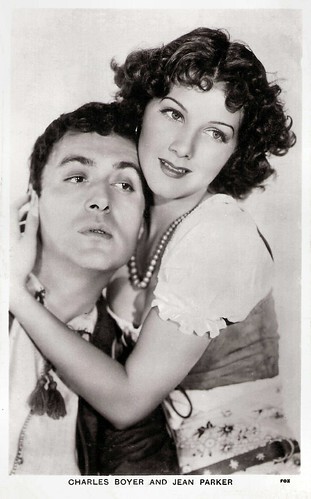
British postcard in the Film Partners Series, no. P 143. Photo: Fox. Charles Boyer and Jean Parker in Caravan (Erik Charell, 1934).
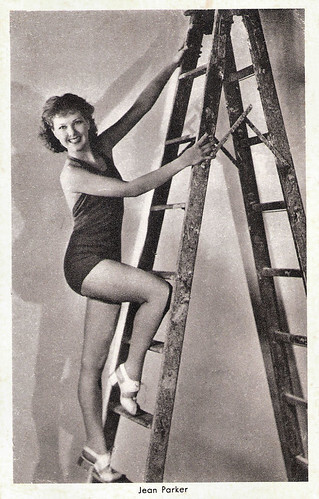
Dutch postcard. Sent by mail in 1948.
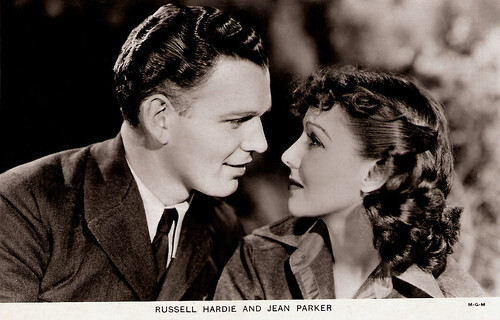
British postcard in the Film Partners Series, London, no. P. 156. Photo: M.G.M. Russell Hardie and Jean Parker in Sequoia (Chester M. Franklin, Edwin L. Marin, 1934).
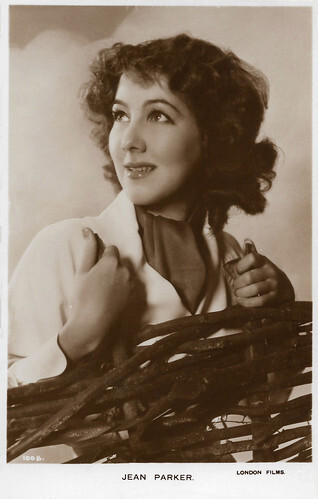
British Real Photograph postcard, no. 100b. Photo: London Films. Jean Parker in The Ghost Goes West (René Clair, 1935).
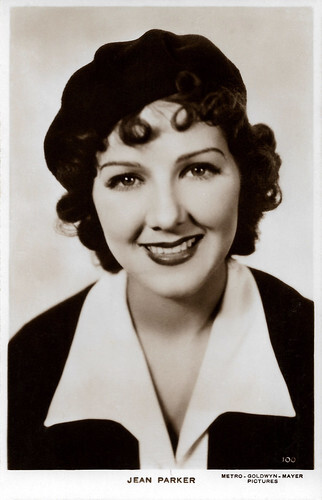
British Real Photograph postcard, no. 100. Photo: Metro Goldwyn Mayer.
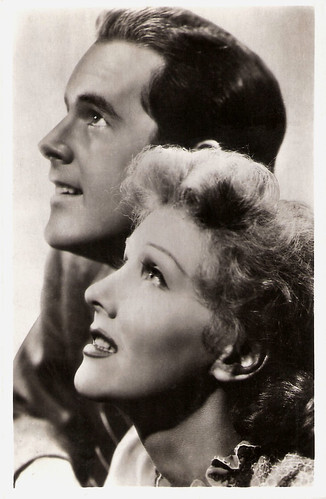
Dutch postcard, sent by mail in the Netherlands in 1942.
Sources: Ronald Bergan (The Guardian), (IMDb), Wikipedia and .

British postcard by Art Photo, no. 177.

British postcard by De Reszke Cigarettes, no. 40. Photo: M.G.M.

British postcard in the Colourgraph Series, London, no. C 203a. Photo: Paramount.
Winning a poster-painting contest
Jean Parker was born Lois Mae Green in 1915. Her father was Lewis Green, a gunsmith and hunter, and her mother was Pearl Melvina Burch. Later, her mother worked at MGM in the set department and created magnificent flowers, trees and other greenery for such notable films as National Velvet (1944), known professionally as Mildred Brenner.
Lois was an accomplished gymnast and dancer. At age 10, she was adopted by the Spickard family of Pasadena when both her father and mother were unemployed during the Great Depression. She initially aspired to be an illustrator and artist. At 17, she entered a poster-painting contest and won for portraying Father Time.
After a photograph of her was published in a Los Angeles newspaper, Ida Koverman, the assistant to MGM studio chief Louis B. Mayer, contacted the would-be starlet and had Mayer offer her an MGM contract.
She made her feature film debut in the pre-code drama Divorce in the Family (Charles Reisner, 1932), before being loaned to Columbia Pictures, who cast her in Frank Capra's Lady for a Day (1933).
Parker made several important films in the following years, including Little Women (George Cukor, 1933) with Joan Bennett and Katharine Hepburn ; Sequoia (Chester M. Franklin, Edwin L. Marin, 1934) with Russell Hardie, shot in the Sequoia National Forest near Springville, California; Operator 13 (Richard Boleslawski, 1934) with Marion Davies and Gary Cooper ; and The Ghost Goes West (René Clair, 1935) with Robert Donat .

Dutch postcard by the Rialto Theatre, Amsterdam, 1934. Photo: Remaco Radio Picture. Publicity still for Little Women (George Cukor, 1933). In the picture are Katharine Hepburn , Joan Bennett , Frances Dee, Jean Parker and Spring Byington. The Dutch title of the film and the book by Louise M. Alcott is Onder moeders vleugels.

Dutch postcard by JosPe, Arnhem, no. 347. Photo: M.G.M.

British postcard in the Picturegoer Series, London, no. 950. Photo: Metro Goldwyn Mayer (M.G.M.).

Dutch postcard by JosPe, Arnhem, no. 390. Photo: Metro Goldwyn Mayer.

British postcard in the Picturegoer Series, London, no. 810. Photo: Metro-Goldwyn-Mayer.
Entertaining injured servicemen during World War II
Jean Parker remained active in film throughout the 1940s. Parker later starred in the Laurel and Hardy comedy The Flying Deuces (A. Edward Sutherland, 1939), followed by the sports film The Pittsburgh Kid (Jack Townley, 1941), and the Film Noir Dead Man's Eyes (Reginald Le Borg, 1944), opposite Lon Chaney Jr.
After several successful cross-country trips entertaining injured servicemen during World War II, Jean Parker wed and divorced Curt Grotter of the Braille Institute in Los Angeles, and moved on to New York to star in the play 'Loco'. She also starred on Broadway in 'Burlesque' (1946-1947) with Bert Lahr, and in the hit 'Born Yesterday' (1948), filling in for Judy Holliday.
Parker's fourth and last husband, actor Robert Lowery, played opposite her as Brock in the play for a short stint. By this marriage, Parker bore her only child, a son, Robert Lowery Hanks.
By the 1950s, Parker's film career had slowed, though she continued to appear in supporting parts in the Westerns The Gunfighter (Henry King, 1950) with Gregory Peck and Toughest Man in Arizona (R. G. Springsteen, 1952), and the Film Noir Black Tuesday (Hugo Fregonese, 1954) opposite Edward G. Robinson . Parker made her final film appearance in Apache Uprising (R. G. Springsteen, 1965) starring Rory Calhoun.
Later in her career, she played in the West Coast theatre circuit and worked as an acting coach. Parker died in 2005 at the Motion Picture Country Home and Hospital in Woodland Hills, California, aged 90, from a stroke. She lived there from 1998 until her death. Jean was survived by her son and two granddaughters, Katie and Nora Hanks.

British postcard in the Film Partners Series, no. P 143. Photo: Fox. Charles Boyer and Jean Parker in Caravan (Erik Charell, 1934).

Dutch postcard. Sent by mail in 1948.

British postcard in the Film Partners Series, London, no. P. 156. Photo: M.G.M. Russell Hardie and Jean Parker in Sequoia (Chester M. Franklin, Edwin L. Marin, 1934).

British Real Photograph postcard, no. 100b. Photo: London Films. Jean Parker in The Ghost Goes West (René Clair, 1935).

British Real Photograph postcard, no. 100. Photo: Metro Goldwyn Mayer.

Dutch postcard, sent by mail in the Netherlands in 1942.
Sources: Ronald Bergan (The Guardian), (IMDb), Wikipedia and .
Published on October 14, 2023 22:00
October 13, 2023
Red Letter
The closing event of the Pordenone Silent Film Festival is a screening of Charles Chaplin's The Pilgrim (1923) and Buster Keaton's Sherlock Jr. (1924), for which a new orchestral score was created. At EFSP we focus on a special series of Chaplin postcards. Red Letter photocards was a British series of sepia-tinted postcards with pictures of the films Charlie Chaplin made for the Essanay Studio in 1915 such as The Tramp, Shanghaied, A Woman By the Sea and The Bank. The complete series contains 26 postcards, but 19 are yet in our collection.
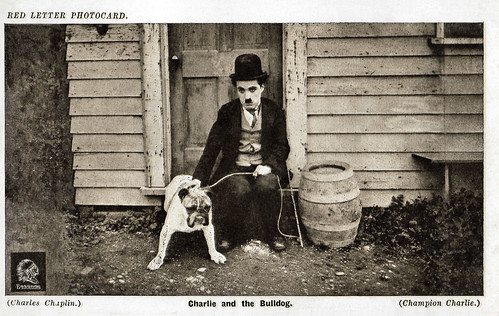
British postcard by Red Letter. Photo: Essanay. Charlie Chaplin in The Champion/Champion Charlie (Charles Chaplin, 1915). Caption: Charlie and the Bulldog.

British postcard by Red Letter. Photo: Essanay. Charlie Chaplin in A Night Out/His Night Out (Charles Chaplin, 1915). Caption: A Small Flirtation (Charlie's Night Out). The man left of Chaplin is Ben Turpin. The man on the right is Leo White, who plays the French Count/dandy while his companion is Eva Sawyer. In the back, the head waiter, played by Bud Jamison.
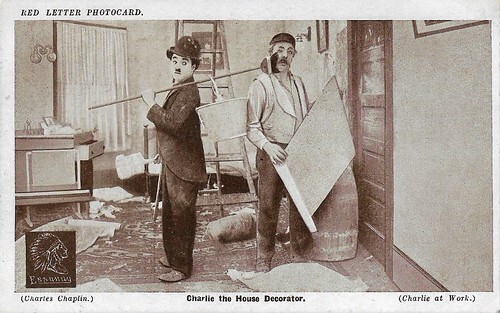
British postcard by Red Letter. Photo: Essanay. Charlie Chaplin in Work (Charles Chaplin, 1915). Caption: Charlie the House Decorator (Charlie at Work). The man right of Chaplin is Charles Inslee.
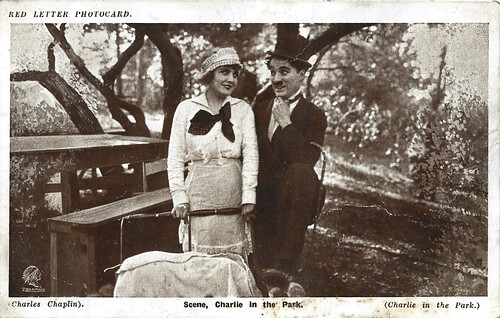
British postcard by Red Letter. Photo: Essanay. Charlie Chaplin and Edna Purviance in In the Park (Charles Chaplin, 1915). Caption: Scene, Charlie in the Park (Charlie in the Park).
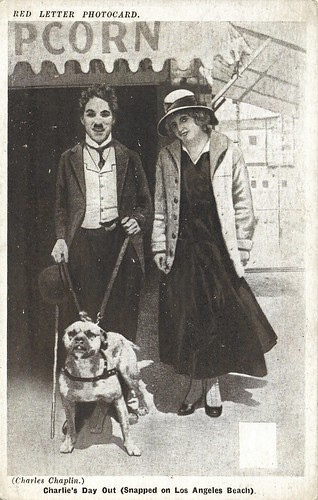
British postcard by Red Letter. Photo: Essanay. Charlie Chaplin in By the Sea/Charlie's Day Out (Charles Chaplin, 1915). Caption: Charlie's Day Out (Snapped on Los Angeles Beach). Almost unrecognisable because of the drawn face is Edna Purviance. NB There is no dog in the film.
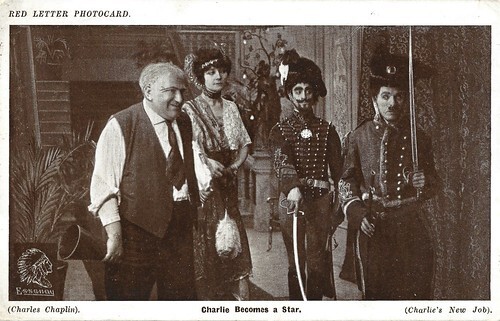
British postcard by Red Letter. Photo: Essanay. Charlie Chaplin in His New Job (Charles Chaplin, 1915), also with Charles Inslee as the director, Charlotte Mineau as the film star, and Leo White as the leading man. Caption: Charlie Becomes a Star (Charlie's New Job).
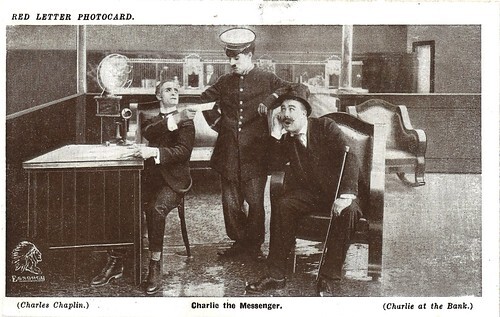
British postcard by Red Letter. Photo: Essanay. Charlie Chaplin is a janitor in The Bank (Charles Chaplin, 1915). The man right of Chaplin is John Rand, a salesman who proves to be a robber. Caption: Charlie the Messenger (Charlie at the Bank).
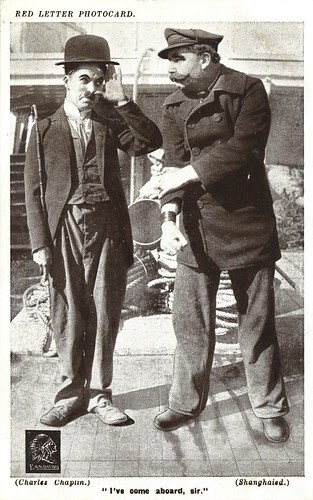
British postcard by Red Letter. Photo: Essanay. Charlie Chaplin in Shanghaied (Charles Chaplin, 1915). The man right of Chaplin is Lawrence Bowes, who plays the ship's mate. Caption: "'I've come aboard, sir." (Shanghaied.)

British postcard by Red Letter. Photo: Essanay. Charlie Chaplin in A Woman (Charles Chaplin, 1915). Left, Edna Purviance as the daughter and right, Marta Golden as the mother. Caption: Charlie "The Perfect Lady."
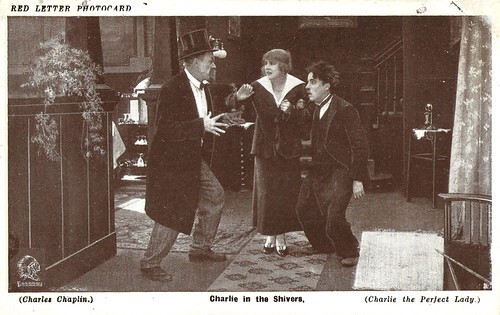
British postcard by Red Letter. Photo: Essanay. Charlie Chaplin in A Woman (Charles Chaplin, 1915), also with Edna Purviance as the daughter and Charles Inslee as the father. Caption: Charlie in the Shivers (Charlie the Perfect Lady.)
Chaplin’s cinematic adolescence
In November 1914, Charles Chaplin left Mack Sennett's Keystone Film Company and signed on at the Essanay Film Manufacturing Company, where he made 14 films plus a cameo appearance in Broncho Billy Anderson's film His Regeneration. After the expiration of his one-year contract with Keystone, Chaplin was lured to Essanay, founded in 1907, for the unprecedented salary of $1,250 per week, with a bonus of $10,000 for merely signing with the company and his own production unit. The fourteen short films he made for Essanay were distinctly marked and designated upon release as the “Essanay-Chaplin Brand.”If the early slapstick of the Keystone comedies represents Chaplin’s cinematic infancy, the films he made for Essanay are his adolescence. The Essanays find Chaplin in transition, taking greater time and care with each film, experimenting with new ideas, and adding flesh to the Tramp character that would become his legacy. Chaplin’s Essanay comedies reveal an artist experimenting with his palette and finding his craft.
While no single Chaplin film for Essanay displays the aggregate transformation to the more complex, subtle filmmaking that characterises his later work, these comedies contain a collection of wonderful, revelatory moments, foreshadowing the pathos (The Tramp), comedic transposition (A Night Out), fantasy (A Night Out), gag humour (The Champion), and irony (Police), of the mature Chaplin films to come. The most celebrated of the Essanay comedies, The Tramp is regarded as the first classic Chaplin film. It is noteworthy because of Chaplin’s use of pathos in situations designed to evoke pity or compassion toward the characters, particularly the Tramp. An innovation in comedic filmmaking, The Tramp dares to have a sad ending. Pathos also appears in The Bank, in which Charlie’s heart is broken when the object of his affection throws away the flowers he has given her and tears up the accompanying love note.
Jeffrey Vance at Charlie Chaplin.com : "Nowhere is the evidence of Chaplin’s growing cinematic maturity more evident than in the subtle evolution of the Tramp’s treatment of women in the Essanay comedies. At Essanay, Chaplin found Edna Purviance, who would remain his leading lady until A Woman of Paris (1923). Born Olga Edna Purviance in Nevada in 1895, she had trained as a secretary and was recommended to Chaplin by an Essanay employee as a beautiful young woman who frequented a popular San Francisco café. Chaplin was instantly captivated by her beauty and charm. The personal chemistry between Chaplin and Purviance served the Tramp’s changing attitudes toward women well, resulting in no small part from the intimate relationship the two enjoyed off-screen. In the Keystone comedies, the Tramp was usually at odds with the women in his life, such as his frequent foil Mabel Normand . Purviance was far more demure and refined, and the Tramp’s interplay with her is gentle and often romantic. Although the female characters of the first Essanays are indistinguishable from those of the Keystones (more often than not, objects of desire, derision, or simply unimportant to the plot), beginning with The Champion, there is a softening in the Tramp’s attitude toward women. The romantic longing at the beginning of A Jitney Elopement demonstrates this transformation.
The evolution of the Tramp was undoubtedly fueled by Chaplin’s efforts to seize greater creative control over his films. Unlike the Keystone comedies, which have a simple plot and place primacy on farce humour, Chaplin’s Essanay comedies display more sophisticated plots and involve more textured characters. The maddening pace of producing nearly one new Keystone comedy each week was reflected in the rapid pace and formulaic storylines in the films. However, the pace of Essanay was somewhat slower, allowing Chaplin to take more time and care in creating his films, and more room to experiment. The tempered pace shows in the style of the films, which contain more subtle pantomime and character development. Although the first seven films Chaplin made for Essanay were released over three months, Chaplin slowed the pace of production to one two-reel film per month after that.
Chaplin had disagreements with Essanay from the beginning. The company’s co-founder, George K. Spoor, had never heard of Chaplin and was reluctant at first to give him his promised $10,000 signing bonus. Chaplin also refused to allow Essanay’s practice of projecting the original negative when screening rough film footage, which saved the studio the expense of making a positive copy, insisting that viewing prints had to be made." Chaplin disliked the unpredictable weather of Chicago and left after only one year for more money and more creative control elsewhere. His departure caused a rift between founders Spoor and G.M. Anderson, better known as 'Broncho Billy' Anderson, cinema’s first cowboy star. Chaplin was the studio's biggest moneymaker, and Essanay resorted to creating "new" Chaplin comedies from file footage and out-takes. Finally, with Chaplin off the Essanay scene for good, Essanay signed French comedian Max Linder , whose clever pantomime, often compared to Chaplin's, failed to match Chaplin's popularity in America. Chaplin remained bitter about this period in his career for the rest of his life.
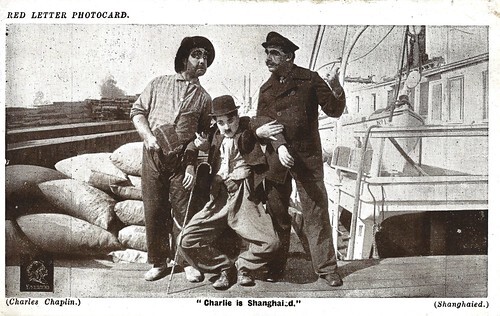
British postcard by Red Letter. Photo: Essanay. Charlie Chaplin in Shanghaied (Charles Chaplin, 1915). The two men, left and right of Chaplin, are Bud Jamison and Lawrence Bowes, the first and second mates on the ship. Caption: "Charlie is Shanghaied." (Shanghaied.)
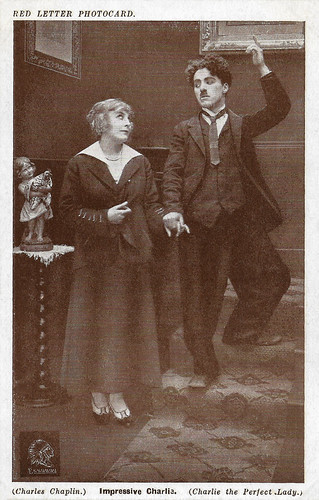
British postcard by Red Letter. Photo: Essanay. Charlie Chaplin and Edna Purviance in A Woman (Charles Chaplin, 1915). Caption: Impressive Charlie. (Charlie the Perfect Lady.)
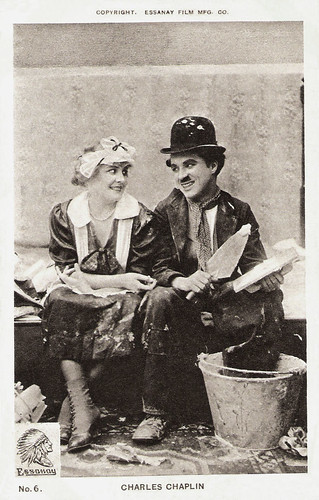
British postcard by Red Letter, no. 6. Photo: Essanay. Charlie Chaplin and Edna Purviance in Work (Charles Chaplin, 1915).
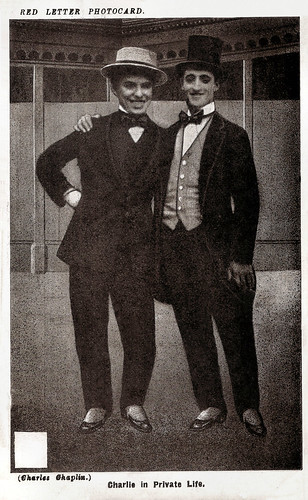
British postcard by Red Letter Photocard. Photo: Essanay. Caption: Charlie in Private Life.
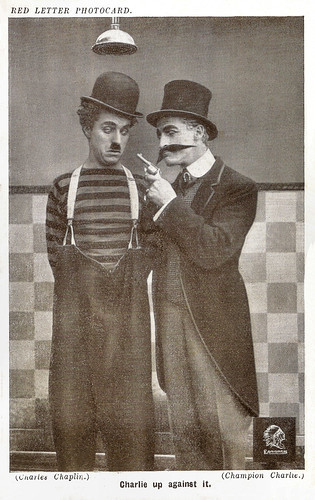
British postcard by Red Letter Photocard. Photo: Essanay. Charlie Chaplin and Leo White in The Champion (Charles Chaplin, 1915). Caption: Charlie up against it. (Champion Charlie.)
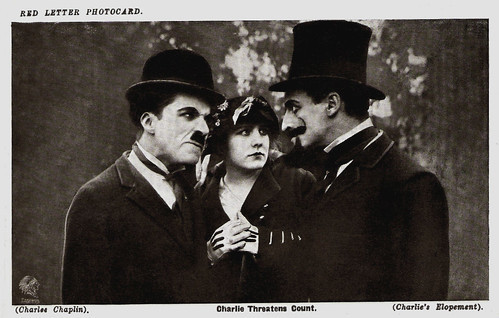
British postcard by Red Letter. Photo: Essanay. Charlie Chaplin , Edna Purviance and Leo White in A Jitney Elopement (Charles Chaplin, 1915). Caption: Charlie Threatens Count. (Charlie's Elopement.)
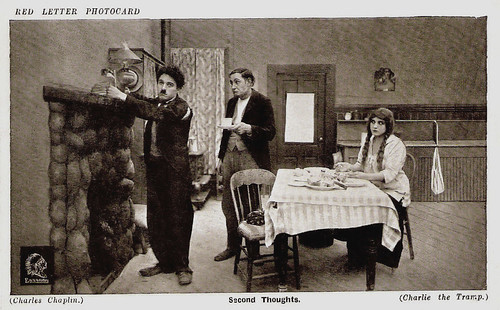
British postcard by Red Letter. Photo: Essanay. Charlie Chaplin as The Tramp, Ernest Van Pelt as The Farmer, and Edna Purviance as The Farmer's Daughter in The Tramp (Charles Chaplin, 1915). Caption: Second Thoughts. (Charlie the Tramp.)
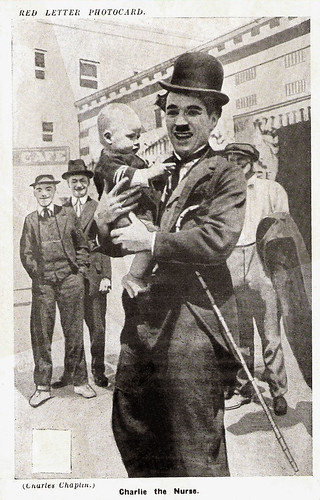
British Postcard by Red Letter. Photo: Essanay. Charlie Chaplin in His Trysting Place (Charles Chaplin, 1914). Caption: Charlie the Nurse.
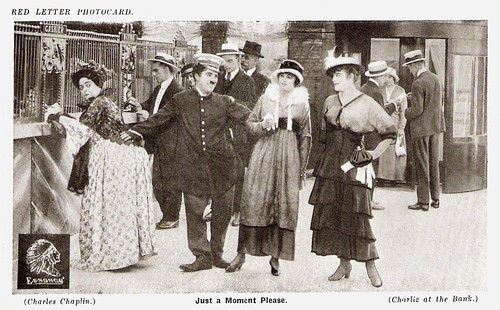
British postcard by Red Letter. Photo: Essanay. Charlie Chaplin and at left Carrie Clark Ward in The Bank (Charles Chaplin, 1915). Caption: Just a Moment Please. (Charlie at the Bank.)
Sources: Jeffrey Vance (Charlie Chaplin.com), (IMDb), Mauvais genres, Wikipedia and .

British postcard by Red Letter. Photo: Essanay. Charlie Chaplin in The Champion/Champion Charlie (Charles Chaplin, 1915). Caption: Charlie and the Bulldog.

British postcard by Red Letter. Photo: Essanay. Charlie Chaplin in A Night Out/His Night Out (Charles Chaplin, 1915). Caption: A Small Flirtation (Charlie's Night Out). The man left of Chaplin is Ben Turpin. The man on the right is Leo White, who plays the French Count/dandy while his companion is Eva Sawyer. In the back, the head waiter, played by Bud Jamison.

British postcard by Red Letter. Photo: Essanay. Charlie Chaplin in Work (Charles Chaplin, 1915). Caption: Charlie the House Decorator (Charlie at Work). The man right of Chaplin is Charles Inslee.

British postcard by Red Letter. Photo: Essanay. Charlie Chaplin and Edna Purviance in In the Park (Charles Chaplin, 1915). Caption: Scene, Charlie in the Park (Charlie in the Park).

British postcard by Red Letter. Photo: Essanay. Charlie Chaplin in By the Sea/Charlie's Day Out (Charles Chaplin, 1915). Caption: Charlie's Day Out (Snapped on Los Angeles Beach). Almost unrecognisable because of the drawn face is Edna Purviance. NB There is no dog in the film.

British postcard by Red Letter. Photo: Essanay. Charlie Chaplin in His New Job (Charles Chaplin, 1915), also with Charles Inslee as the director, Charlotte Mineau as the film star, and Leo White as the leading man. Caption: Charlie Becomes a Star (Charlie's New Job).

British postcard by Red Letter. Photo: Essanay. Charlie Chaplin is a janitor in The Bank (Charles Chaplin, 1915). The man right of Chaplin is John Rand, a salesman who proves to be a robber. Caption: Charlie the Messenger (Charlie at the Bank).

British postcard by Red Letter. Photo: Essanay. Charlie Chaplin in Shanghaied (Charles Chaplin, 1915). The man right of Chaplin is Lawrence Bowes, who plays the ship's mate. Caption: "'I've come aboard, sir." (Shanghaied.)

British postcard by Red Letter. Photo: Essanay. Charlie Chaplin in A Woman (Charles Chaplin, 1915). Left, Edna Purviance as the daughter and right, Marta Golden as the mother. Caption: Charlie "The Perfect Lady."

British postcard by Red Letter. Photo: Essanay. Charlie Chaplin in A Woman (Charles Chaplin, 1915), also with Edna Purviance as the daughter and Charles Inslee as the father. Caption: Charlie in the Shivers (Charlie the Perfect Lady.)
Chaplin’s cinematic adolescence
In November 1914, Charles Chaplin left Mack Sennett's Keystone Film Company and signed on at the Essanay Film Manufacturing Company, where he made 14 films plus a cameo appearance in Broncho Billy Anderson's film His Regeneration. After the expiration of his one-year contract with Keystone, Chaplin was lured to Essanay, founded in 1907, for the unprecedented salary of $1,250 per week, with a bonus of $10,000 for merely signing with the company and his own production unit. The fourteen short films he made for Essanay were distinctly marked and designated upon release as the “Essanay-Chaplin Brand.”If the early slapstick of the Keystone comedies represents Chaplin’s cinematic infancy, the films he made for Essanay are his adolescence. The Essanays find Chaplin in transition, taking greater time and care with each film, experimenting with new ideas, and adding flesh to the Tramp character that would become his legacy. Chaplin’s Essanay comedies reveal an artist experimenting with his palette and finding his craft.
While no single Chaplin film for Essanay displays the aggregate transformation to the more complex, subtle filmmaking that characterises his later work, these comedies contain a collection of wonderful, revelatory moments, foreshadowing the pathos (The Tramp), comedic transposition (A Night Out), fantasy (A Night Out), gag humour (The Champion), and irony (Police), of the mature Chaplin films to come. The most celebrated of the Essanay comedies, The Tramp is regarded as the first classic Chaplin film. It is noteworthy because of Chaplin’s use of pathos in situations designed to evoke pity or compassion toward the characters, particularly the Tramp. An innovation in comedic filmmaking, The Tramp dares to have a sad ending. Pathos also appears in The Bank, in which Charlie’s heart is broken when the object of his affection throws away the flowers he has given her and tears up the accompanying love note.
Jeffrey Vance at Charlie Chaplin.com : "Nowhere is the evidence of Chaplin’s growing cinematic maturity more evident than in the subtle evolution of the Tramp’s treatment of women in the Essanay comedies. At Essanay, Chaplin found Edna Purviance, who would remain his leading lady until A Woman of Paris (1923). Born Olga Edna Purviance in Nevada in 1895, she had trained as a secretary and was recommended to Chaplin by an Essanay employee as a beautiful young woman who frequented a popular San Francisco café. Chaplin was instantly captivated by her beauty and charm. The personal chemistry between Chaplin and Purviance served the Tramp’s changing attitudes toward women well, resulting in no small part from the intimate relationship the two enjoyed off-screen. In the Keystone comedies, the Tramp was usually at odds with the women in his life, such as his frequent foil Mabel Normand . Purviance was far more demure and refined, and the Tramp’s interplay with her is gentle and often romantic. Although the female characters of the first Essanays are indistinguishable from those of the Keystones (more often than not, objects of desire, derision, or simply unimportant to the plot), beginning with The Champion, there is a softening in the Tramp’s attitude toward women. The romantic longing at the beginning of A Jitney Elopement demonstrates this transformation.
The evolution of the Tramp was undoubtedly fueled by Chaplin’s efforts to seize greater creative control over his films. Unlike the Keystone comedies, which have a simple plot and place primacy on farce humour, Chaplin’s Essanay comedies display more sophisticated plots and involve more textured characters. The maddening pace of producing nearly one new Keystone comedy each week was reflected in the rapid pace and formulaic storylines in the films. However, the pace of Essanay was somewhat slower, allowing Chaplin to take more time and care in creating his films, and more room to experiment. The tempered pace shows in the style of the films, which contain more subtle pantomime and character development. Although the first seven films Chaplin made for Essanay were released over three months, Chaplin slowed the pace of production to one two-reel film per month after that.
Chaplin had disagreements with Essanay from the beginning. The company’s co-founder, George K. Spoor, had never heard of Chaplin and was reluctant at first to give him his promised $10,000 signing bonus. Chaplin also refused to allow Essanay’s practice of projecting the original negative when screening rough film footage, which saved the studio the expense of making a positive copy, insisting that viewing prints had to be made." Chaplin disliked the unpredictable weather of Chicago and left after only one year for more money and more creative control elsewhere. His departure caused a rift between founders Spoor and G.M. Anderson, better known as 'Broncho Billy' Anderson, cinema’s first cowboy star. Chaplin was the studio's biggest moneymaker, and Essanay resorted to creating "new" Chaplin comedies from file footage and out-takes. Finally, with Chaplin off the Essanay scene for good, Essanay signed French comedian Max Linder , whose clever pantomime, often compared to Chaplin's, failed to match Chaplin's popularity in America. Chaplin remained bitter about this period in his career for the rest of his life.

British postcard by Red Letter. Photo: Essanay. Charlie Chaplin in Shanghaied (Charles Chaplin, 1915). The two men, left and right of Chaplin, are Bud Jamison and Lawrence Bowes, the first and second mates on the ship. Caption: "Charlie is Shanghaied." (Shanghaied.)

British postcard by Red Letter. Photo: Essanay. Charlie Chaplin and Edna Purviance in A Woman (Charles Chaplin, 1915). Caption: Impressive Charlie. (Charlie the Perfect Lady.)

British postcard by Red Letter, no. 6. Photo: Essanay. Charlie Chaplin and Edna Purviance in Work (Charles Chaplin, 1915).

British postcard by Red Letter Photocard. Photo: Essanay. Caption: Charlie in Private Life.

British postcard by Red Letter Photocard. Photo: Essanay. Charlie Chaplin and Leo White in The Champion (Charles Chaplin, 1915). Caption: Charlie up against it. (Champion Charlie.)

British postcard by Red Letter. Photo: Essanay. Charlie Chaplin , Edna Purviance and Leo White in A Jitney Elopement (Charles Chaplin, 1915). Caption: Charlie Threatens Count. (Charlie's Elopement.)

British postcard by Red Letter. Photo: Essanay. Charlie Chaplin as The Tramp, Ernest Van Pelt as The Farmer, and Edna Purviance as The Farmer's Daughter in The Tramp (Charles Chaplin, 1915). Caption: Second Thoughts. (Charlie the Tramp.)

British Postcard by Red Letter. Photo: Essanay. Charlie Chaplin in His Trysting Place (Charles Chaplin, 1914). Caption: Charlie the Nurse.

British postcard by Red Letter. Photo: Essanay. Charlie Chaplin and at left Carrie Clark Ward in The Bank (Charles Chaplin, 1915). Caption: Just a Moment Please. (Charlie at the Bank.)
Sources: Jeffrey Vance (Charlie Chaplin.com), (IMDb), Mauvais genres, Wikipedia and .
Published on October 13, 2023 22:00
October 11, 2023
Quo vadis?, Cabiria and the 'Archaeologists'
Today, 12 October 2023, the new book by Ivo Blom, 'Quo vadis?, Cabiria and the 'Archaeologists'' is presented at the Giornate del Cinema Muto, The Pordenone Silent Film Festival in Pordenone, Italy. In the early 1910s, Italy was the world leader in cinema with its spectacular films of Roman and Carthaginian antiquity. Despite their innovations in storytelling and mise en scène, filmmakers like Enrico Guazzoni and Giovanni Pastrone also looked backwards to the 19th century, by appropriating not only literature and theatre but also painting, which has been hitherto little researched. ‘Archaeologist’ painters like Gérôme, Alma-Tadema and Rochegrosse, who combined painstaking historical research with their own imagination of antiquity, thus experienced a second life in the 20th-century medium of film. Thanks to the use of mechanical reproduction, their works became part of public memory and were reused by filmmakers, most evident in two key films of the early years of Italian cinema:
Quo vadis?
(1913) and
Cabiria
(1914). Yet, particularly for
Cabiria
, this book, published by Edizioni Kaplan, also creates a new archaeological framework from which to approach early Italian epics.

Book cover of Ivo Blom's 'Quo vadis?, Cabiria and the 'Archaeologists''. Edizioni Kaplan, 2023. Photo: Italia Almirante Manzini in Cabiria (Giovanni Pastrone, 1914).
Quo vadis? (1913)

Italian postcard by Uff. Rev. St. Terni. Photo: Cines. Picture for the early epic Quo vadis? (Enrico Guazzoni, 1913), adapted from Henryk Sienkiewicz's classic novel and the biggest film hit of 1913 worldwide. Caption: The death of the gladiator. This image cites Jean-Léon Gérôme's famous painting 'Pollice verso' (Thumbs down, 1872) and was often used in the publicity for the film. In the back, the emperor Nero (Carlo Cattaneo) makes the sign of thumbs down, a sign for the conqueror to kill his adversary. Flanking Nero are, at left, Tigellinus (Cesare Moltroni) and, at right, Petronius ( Gustavo Serena ). Left of the imperial box, the Vestal Virgins are seated.
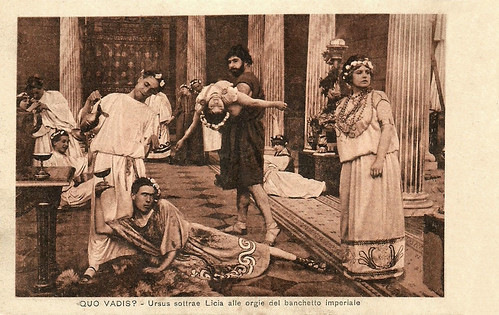
Italian postcard by Uff. Rev. St. Terni. Photo: Cines. Picture for Quo vadis? (Enrico Guazzoni, 1913). Helped by Acte, Nero's former mistress, Ursus ( Bruto Castellani ) subtracts Lygia ( Lea Giunchi ) from the orgy of the imperial banquet, where the drunken Roman Vinicius tries to rape her.
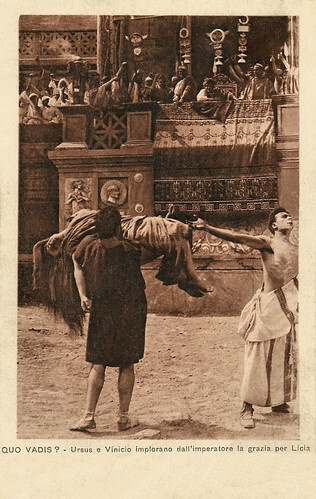
Italian postcard by Uff. Rev. St. Terni. Photo: Cines. Picture for Quo vadis? (Enrico Guazzoni, 1913). Ursus ( Bruto Castellani ) and Vinicius ( Amleto Novelli ) implore the audience and emperor Nero to grace the Christian Lygia ( Lea Giunchi ) after Ursus has killed the bull on which back Lygia had been bound. The audience raves because of Ursus' tour de force. Vinicius has stripped his clothes to show his scars from the wars, while Ursus holds up Lygia. All around Nero hold their thumbs up for grace, even if this sign seems to have been a 19th-century invention and historically incorrect.
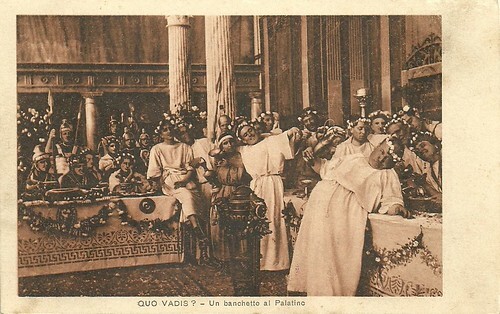
Italian postcard by Uff. Rev. St. Terni. Photo: Cines. Picture for Quo vadis? (Enrico Guazzoni, 1913). Caption: A banquet on the Palatine. The fat and drunken man in front is Giuseppe Gambardella, who was also famous as Checco in short Italian comedies.
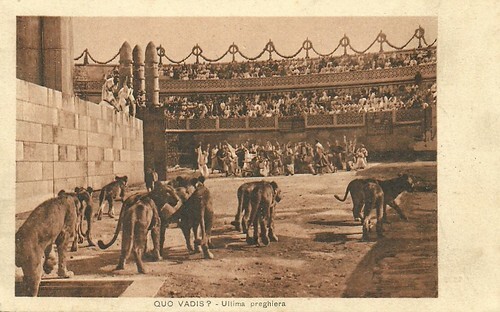
Italian postcard by Uff. Rev. St. Terni. Photo: Cines. Picture for Quo vadis? (Enrico Guazzoni, 1913). Caption: The last prayer. This scene quotes Jean-Léon Gérôme's painting 'The Christian Martyrs' Last Prayer' (1863-1883).
Who is Ivo Blom?
Ivo Blom is lecturer in Comparative Arts & Media Studies at Vrije Universiteit, Amsterdam. His research often deals with intervisual relationships between cinema and other arts.
Besides his monographs 'Jean Desmet and the Early Dutch Film Trade' (2000) and 'Reframing Luchino Visconti: Film and Art' (2018), he has often published on Italian silent film and its ties with art and visual culture.
He has also contributed to the crossmedial exhibitions 'Alma-Tadema: At Home in Antiquity' (Fries Museum/ Untere Belvedere/ Leighton House, 2016-17) and 'Enfin le cinéma!' (Musée d’Orsay, 2021-22).
For the 2020 Cinefest ‘Kino, Krieg und Tulpen. Deutsch-niederländische Filmbeziehungen’ (13-22 November 2020) he was co-curator of the film program and co-author of the accompanying catalogue.
And since 2007 Ivo Blom has been one of the editors of European Film Star Postcards.
Cabiria (1914)
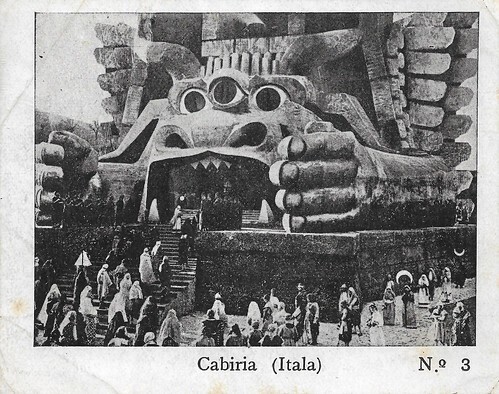
Spanish minicard by Chocolate Amatller, Barcelona, no. 3 in a series of 12 cards. Photo: Itala Film. Picture from the Italian silent mega-epic Cabiria (Giovanni Pastrone, 1914), starring Italia Almirante Manzini as Sophonisba, Umberto Mozzato as Fulvio Axilla, Lydia Quaranta as Cabiria and Bartolomeo Pagano as Maciste. Here we see the giant entrance to the Temple of Moloch, which was inspired by a painting by the French artist Henri Motte.

Spanish minicard by Chocolate Amatller, Barcelona, no. 5 in a series of 12 cards. Photo: Itala Film. Picture from Cabiria (Giovanni Pastrone, 1914), starring Italia Almirante Manzini as Sophonisba, Umberto Mozzato as Fulvio Axilla, Lydia Quaranta as Cabiria and Bartolomeo Pagano as Maciste. Here Sophonisba (Italia Almirante) and Massinissa (Vitale Di Stefano) are married. The statue in the back is a variation of the Egyptian statue of Sekhmet, as can be found at the Louvre in Paris and the Museo Egizio in Turin.
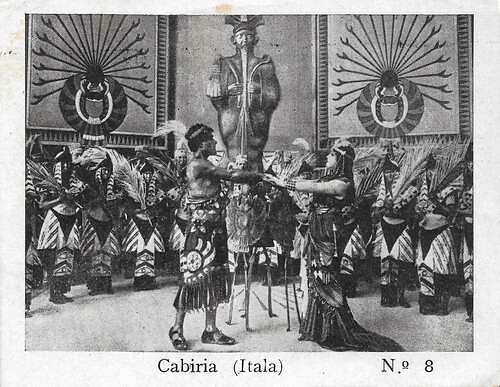
Spanish minicard by Chocolate Amatller, Barcelona, no. 8 in a series of 12 cards. Photo: Itala Film. Picture from Cabiria (Giovanni Pastrone, 1914), starring Italia Almirante Manzini as Sophonisba, Umberto Mozzato as Fulvio Axilla, Lydia Quaranta as Cabiria and Bartolomeo Pagano as Maciste. Here Queen Sophonisba receives her former lover and now adversary Massinissa (Vitale Di Stefano) in her palace at Cirta. In contrast to the palace of Carthage, the one at Cirta has many Egyptian elements in its design, such as the Osiris-like decoration on the back wall, as well as the scarab motif.
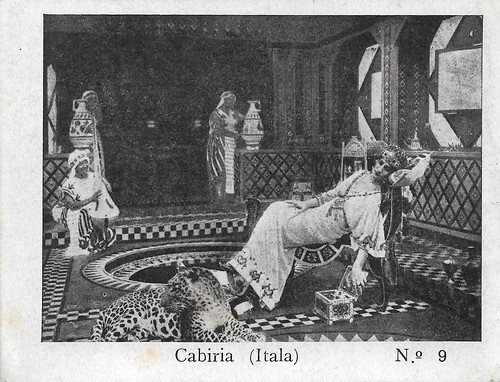
Spanish minicard by Chocolate Amatller, Barcelona, no. 9 in a series of 12 cards. Photo: Itala Film. Picture from Cabiria (Giovanni Pastrone, 1914), starring Italia Almirante Manzini as Sophonisba, Umberto Mozzato as Fulvio Axilla, Lydia Quaranta as Cabiria and Bartolomeo Pagano as Maciste. Here we see the princess Sophonisba (Italia Almirante Manzini) in her boudoir. This set was inspired by a watercolour by the French artist Georges-Antoine Rochegrosse, used for a 1900 edition of Gustave Flaubert's novel 'Salammbô'.
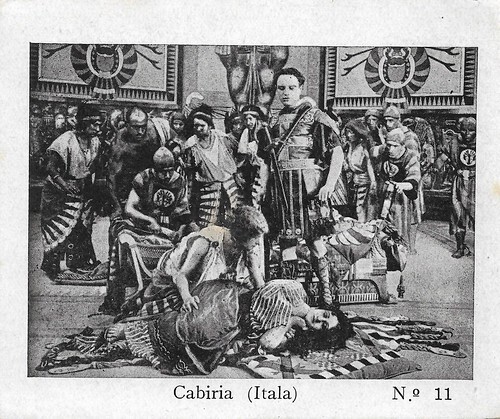
Spanish minicard by Chocolate Amatller, Barcelona, no. 11 in a series of 12 cards. Photo: Itala Film. Picture from Cabiria (Giovanni Pastrone, 1914), starring Italia Almirante Manzini as Sophonisba, Umberto Mozzato as Fulvio Axilla, Lydia Quaranta as Cabiria and Bartolomeo Pagano as Maciste. Here we see the death of Sophonisba, surrounded by Cabiria, Fulvio Axilla and the courtiers. She has poisoned herself, rather than become a slave to the Romans.
Teaser trailer Quo Vadis, Cabiria and the 'Archaeologists'. Source: Ivo Blom @ YouTube. Teaser made by Jaar & Dag Media.
Sources: Edizioni Kaplan and Ivo Blom.

Book cover of Ivo Blom's 'Quo vadis?, Cabiria and the 'Archaeologists''. Edizioni Kaplan, 2023. Photo: Italia Almirante Manzini in Cabiria (Giovanni Pastrone, 1914).
Quo vadis? (1913)

Italian postcard by Uff. Rev. St. Terni. Photo: Cines. Picture for the early epic Quo vadis? (Enrico Guazzoni, 1913), adapted from Henryk Sienkiewicz's classic novel and the biggest film hit of 1913 worldwide. Caption: The death of the gladiator. This image cites Jean-Léon Gérôme's famous painting 'Pollice verso' (Thumbs down, 1872) and was often used in the publicity for the film. In the back, the emperor Nero (Carlo Cattaneo) makes the sign of thumbs down, a sign for the conqueror to kill his adversary. Flanking Nero are, at left, Tigellinus (Cesare Moltroni) and, at right, Petronius ( Gustavo Serena ). Left of the imperial box, the Vestal Virgins are seated.

Italian postcard by Uff. Rev. St. Terni. Photo: Cines. Picture for Quo vadis? (Enrico Guazzoni, 1913). Helped by Acte, Nero's former mistress, Ursus ( Bruto Castellani ) subtracts Lygia ( Lea Giunchi ) from the orgy of the imperial banquet, where the drunken Roman Vinicius tries to rape her.

Italian postcard by Uff. Rev. St. Terni. Photo: Cines. Picture for Quo vadis? (Enrico Guazzoni, 1913). Ursus ( Bruto Castellani ) and Vinicius ( Amleto Novelli ) implore the audience and emperor Nero to grace the Christian Lygia ( Lea Giunchi ) after Ursus has killed the bull on which back Lygia had been bound. The audience raves because of Ursus' tour de force. Vinicius has stripped his clothes to show his scars from the wars, while Ursus holds up Lygia. All around Nero hold their thumbs up for grace, even if this sign seems to have been a 19th-century invention and historically incorrect.

Italian postcard by Uff. Rev. St. Terni. Photo: Cines. Picture for Quo vadis? (Enrico Guazzoni, 1913). Caption: A banquet on the Palatine. The fat and drunken man in front is Giuseppe Gambardella, who was also famous as Checco in short Italian comedies.

Italian postcard by Uff. Rev. St. Terni. Photo: Cines. Picture for Quo vadis? (Enrico Guazzoni, 1913). Caption: The last prayer. This scene quotes Jean-Léon Gérôme's painting 'The Christian Martyrs' Last Prayer' (1863-1883).
Who is Ivo Blom?
Ivo Blom is lecturer in Comparative Arts & Media Studies at Vrije Universiteit, Amsterdam. His research often deals with intervisual relationships between cinema and other arts.
Besides his monographs 'Jean Desmet and the Early Dutch Film Trade' (2000) and 'Reframing Luchino Visconti: Film and Art' (2018), he has often published on Italian silent film and its ties with art and visual culture.
He has also contributed to the crossmedial exhibitions 'Alma-Tadema: At Home in Antiquity' (Fries Museum/ Untere Belvedere/ Leighton House, 2016-17) and 'Enfin le cinéma!' (Musée d’Orsay, 2021-22).
For the 2020 Cinefest ‘Kino, Krieg und Tulpen. Deutsch-niederländische Filmbeziehungen’ (13-22 November 2020) he was co-curator of the film program and co-author of the accompanying catalogue.
And since 2007 Ivo Blom has been one of the editors of European Film Star Postcards.
Cabiria (1914)

Spanish minicard by Chocolate Amatller, Barcelona, no. 3 in a series of 12 cards. Photo: Itala Film. Picture from the Italian silent mega-epic Cabiria (Giovanni Pastrone, 1914), starring Italia Almirante Manzini as Sophonisba, Umberto Mozzato as Fulvio Axilla, Lydia Quaranta as Cabiria and Bartolomeo Pagano as Maciste. Here we see the giant entrance to the Temple of Moloch, which was inspired by a painting by the French artist Henri Motte.

Spanish minicard by Chocolate Amatller, Barcelona, no. 5 in a series of 12 cards. Photo: Itala Film. Picture from Cabiria (Giovanni Pastrone, 1914), starring Italia Almirante Manzini as Sophonisba, Umberto Mozzato as Fulvio Axilla, Lydia Quaranta as Cabiria and Bartolomeo Pagano as Maciste. Here Sophonisba (Italia Almirante) and Massinissa (Vitale Di Stefano) are married. The statue in the back is a variation of the Egyptian statue of Sekhmet, as can be found at the Louvre in Paris and the Museo Egizio in Turin.

Spanish minicard by Chocolate Amatller, Barcelona, no. 8 in a series of 12 cards. Photo: Itala Film. Picture from Cabiria (Giovanni Pastrone, 1914), starring Italia Almirante Manzini as Sophonisba, Umberto Mozzato as Fulvio Axilla, Lydia Quaranta as Cabiria and Bartolomeo Pagano as Maciste. Here Queen Sophonisba receives her former lover and now adversary Massinissa (Vitale Di Stefano) in her palace at Cirta. In contrast to the palace of Carthage, the one at Cirta has many Egyptian elements in its design, such as the Osiris-like decoration on the back wall, as well as the scarab motif.

Spanish minicard by Chocolate Amatller, Barcelona, no. 9 in a series of 12 cards. Photo: Itala Film. Picture from Cabiria (Giovanni Pastrone, 1914), starring Italia Almirante Manzini as Sophonisba, Umberto Mozzato as Fulvio Axilla, Lydia Quaranta as Cabiria and Bartolomeo Pagano as Maciste. Here we see the princess Sophonisba (Italia Almirante Manzini) in her boudoir. This set was inspired by a watercolour by the French artist Georges-Antoine Rochegrosse, used for a 1900 edition of Gustave Flaubert's novel 'Salammbô'.

Spanish minicard by Chocolate Amatller, Barcelona, no. 11 in a series of 12 cards. Photo: Itala Film. Picture from Cabiria (Giovanni Pastrone, 1914), starring Italia Almirante Manzini as Sophonisba, Umberto Mozzato as Fulvio Axilla, Lydia Quaranta as Cabiria and Bartolomeo Pagano as Maciste. Here we see the death of Sophonisba, surrounded by Cabiria, Fulvio Axilla and the courtiers. She has poisoned herself, rather than become a slave to the Romans.
Teaser trailer Quo Vadis, Cabiria and the 'Archaeologists'. Source: Ivo Blom @ YouTube. Teaser made by Jaar & Dag Media.
Sources: Edizioni Kaplan and Ivo Blom.
Published on October 11, 2023 22:00
October 10, 2023
Crosscurrents of American and European Slapstick
Steve Massa, author of 'Lame Brains and Lunatics' and 'Slapstick Divas: The Women of Silent Comedy' is one of the guest programmers at Le Giornate del Cinema Muto this year. In 'Crosscurrents of American and European Slapstick', Massa and his co-curator Uli Ruedel highlight many great silent comedians including Harold Lloyd, Karl Valentin, Syd Chaplin, Sarah Duhamel, Mack Sennett, Mabel Normand, Ford Sterling, Pat & Patachon, Slim Summerville & Bobby Dunn, Larry Semon, Fratellini Brothers, Marcel Perez, André Deed, and Charley Chase. For this post, we selected 15 of their best postcards.
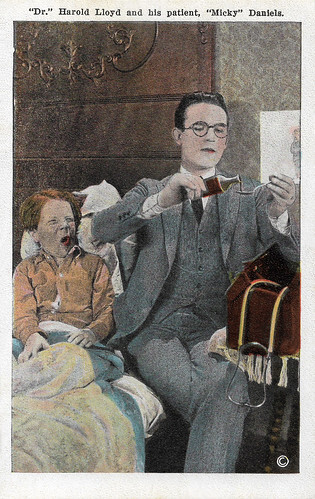
American postcard by Postcard Co. California, Los Angeles. Photo: Glen G. Stone, Los Angeles. Harold Lloyd and Mickey Daniels in Dr. Jack (1922). Captions: "Dr." Harold Lloyd and his patient, "Mickey" Daniels. (front) Showing Harold Lloyd in the role of a doctor who "dispenses happiness". Both he and his patient "look their parts". For the freckled youngster, the happiness has evidently to come after the dose.
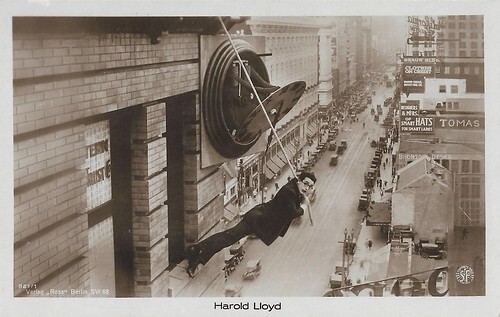
Vintage German postcard by Ross Verlag, no. 821/1, 1925-1926. Distr. S.F. (Südfilm A.G.). Harold Lloyd in the classic scene in Safety Last! (Fred Neymeyer, Sam Taylor, 1923). The street below is Los Angeles' Broadway, behind the clock is the still extant building of the Hamburgers / May Department Store. The clock itself was a set, built on the top of the building of 908 S. Broadway.
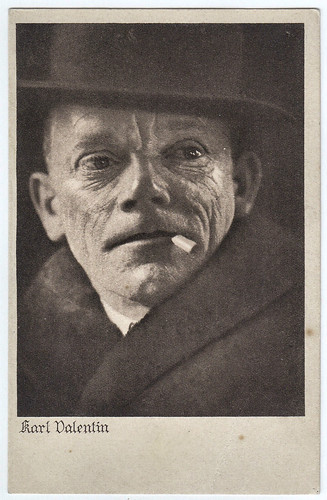
German postcard by Heliogravüre J.B. Obernetter, München. Collection: Marlene Pilaete. Bavarian comedian Karl Valentin (1882-1948) starred in many silent German films in the 1920s. Valentin was also active as a cabaret performer, clown, author and film producer, and was sometimes called the 'Charlie Chaplin of Germany'. His work influenced artists like Bertolt Brecht and Samuel Beckett.
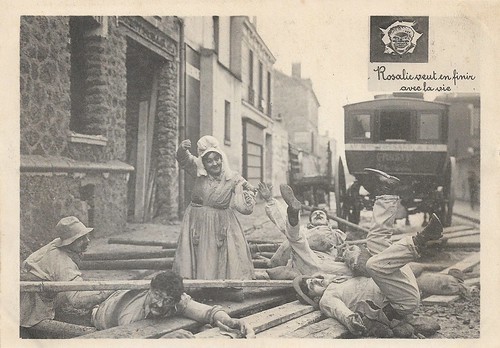
French collectors card by Pathé Frères, Comica, 1911. Photo: Pathé Frères, Comica, 1911. Sarah Duhamel as Rosalie in Rosalie veut en finir avec la vie (1911). Rosalie is fired, so she wants to commit suicide. She shoots herself with a revolver but only destroys the mirror. She throws herself on the tramway rails, but, alas, this one takes another track. She throws herself from a parapet but in vain. Desperate, she goes into a gunshop, throws a bomb and mounts to heaven But is only to cause her to descend again, this time in the arms of a well-mustached police officer, so gets lust for life again.
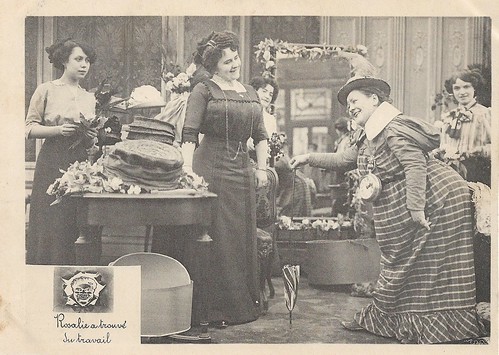
French collectors card by Pathé Frères, Comica, 1911. Photo: Pathé Frères, Comica, 1911. Sarah Duhamel as Rosalie in Rosalie a trouvé du travail (1911). Rosalie is hired as a worker at a fashion shop but has to promise to be at work at 7 sharp. The next morning she awakes at 10 to 7, shoots out of bed, dresses in haste, jumps down the stairs, and crosses the obstacles like a tornado. After a dishevelled run full of wild episodes, Rosalie arrives, red-headed and muddy, scarred with snags, at the fashion shop, only to read the sign on the closed front door, 'closed on Sundays and holidays'.
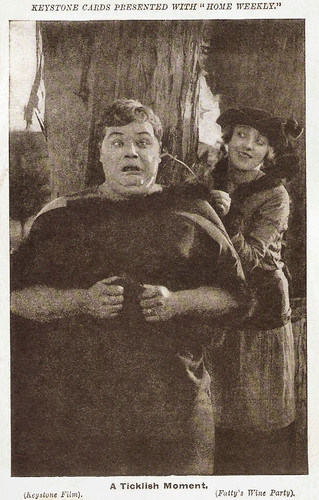
American postcard by Keystone cards, presented with Home Weekly. Photo: Keystone Film. Fatty Arbuckle and Mabel Normand in Fatty's Wine Party (Roscoe 'Fatty' Arbuckle, 1914). Caption: A Ticklish Moment.
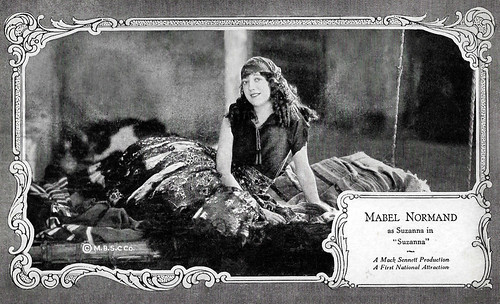
American postcard by Max B. Sheffer Card Co., Chicago (M.B.S.C.Co.). Photo: Mack Sennett Production / First National. Mabel Normand as Suzanna in Suzanna (F. Richard Jones, 1923).

German postcard by Ross Verlag, no. 4453/2, 1929-1930. Photo: Lothar Stark-Film. Collection: Geoffrey Donaldson Institute. The Danish double-act Fy og Bi (Fyrtårnet og Bivognen aka Pat & Patachon ) was the most famous comedy couple of the European silent cinema. Long Carl Schenstrom (1881-1942) and short Harald Madsen (1890-1949) became very popular in the 1920s with their short slapstick films.
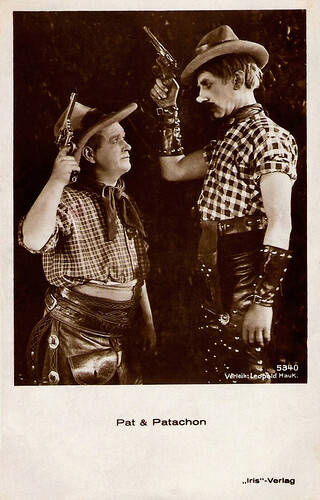
Austrian postcard by Iris Verlag, no. 5340. Photo: Verleih Leopold Hauk. Pat and Patachon in Filmens Helte/ Long and Short, the film heroes (Lau Lauritzen, Palladium 1928).
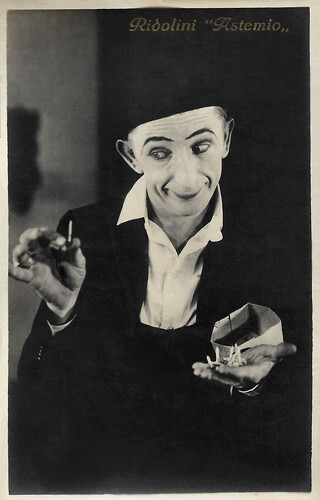
Italian postcard by G.B. Falci Editore, Milano, no. 285. Caption: Ridolini "al Tabarin". Larry Semon (Ridolini) in Trouble Brewing (James D. Davis, Larry Semon, 1924).
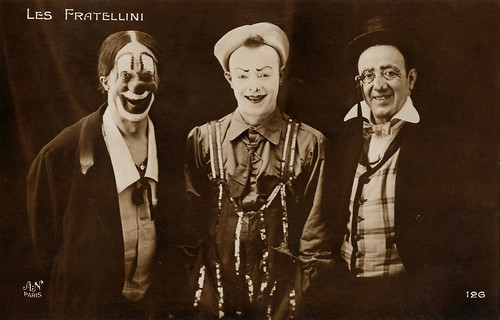
French postcard by A.N., Paris, no. 126. From left to right, Albert, François and Paolo (Paul) Fratellini. The three brothers starred together in the French silent film Rêves de clowns (René Hervouin, Madame Vigier de Maisonneuve, 1924) in which they played three famous clowns who are puzzled by a single woman in the audience who seems to find their act not funny.
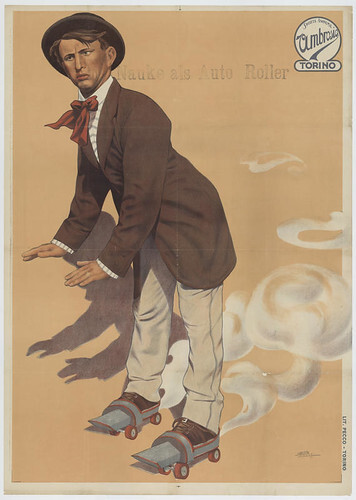
Italian poster by Litografia Pecco, Torino. The Ambrosio production Gli auto-scat di Robinet (1911) is a short comedy with the actor Marcel Fabre a.k.a. Marcel Perez a.k.a. Robinet. The poster is part of the Desmet-Collection of the Eye Filmmuseum.
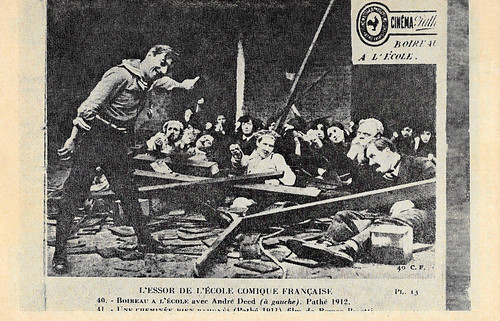
French postcard by Sadag de France, Imp., Paris, no. 40. Photo: Pathé Frères. André Deed in Boireau à l'école/Boireau at school (André Deed, 1912). André Deed (1879-1940) was one the most popular comedians in French and Italian silent cinema under the names of Boireau and Cretinetti. He also was a film director and scriptwriter.
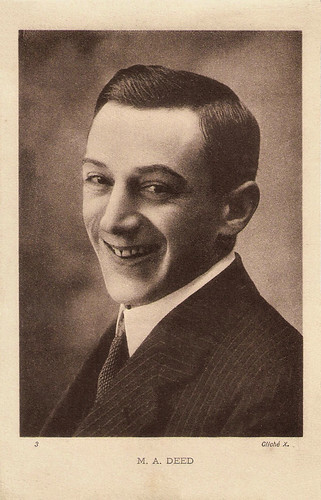
French postcard, no. 3. Cliché X. André Deed .
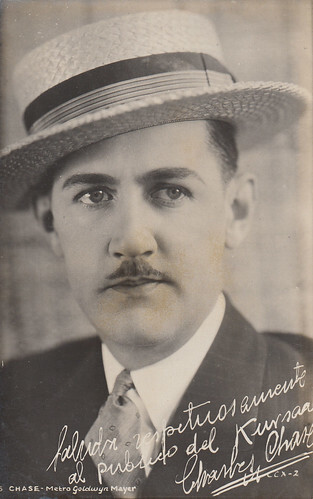
Spanish postcard by IFG. Photo: Metro Goldwyn Mayer. Collection: Marlene Pilaete. American comedian, actor, screenwriter, and film director Charley Chase (1893-1940) was best known for his work in Hal Roach's short film comedies. Chase usually portrayed an apparently gentle and charming man who in reality, it eventually turned out, was quite a loser after all.
Many thanks to Steve Massa, and also to Ivo Blom, Marlene Pilaete and Egbert Barten of the Geoffrey Donaldson Institute.

American postcard by Postcard Co. California, Los Angeles. Photo: Glen G. Stone, Los Angeles. Harold Lloyd and Mickey Daniels in Dr. Jack (1922). Captions: "Dr." Harold Lloyd and his patient, "Mickey" Daniels. (front) Showing Harold Lloyd in the role of a doctor who "dispenses happiness". Both he and his patient "look their parts". For the freckled youngster, the happiness has evidently to come after the dose.

Vintage German postcard by Ross Verlag, no. 821/1, 1925-1926. Distr. S.F. (Südfilm A.G.). Harold Lloyd in the classic scene in Safety Last! (Fred Neymeyer, Sam Taylor, 1923). The street below is Los Angeles' Broadway, behind the clock is the still extant building of the Hamburgers / May Department Store. The clock itself was a set, built on the top of the building of 908 S. Broadway.

German postcard by Heliogravüre J.B. Obernetter, München. Collection: Marlene Pilaete. Bavarian comedian Karl Valentin (1882-1948) starred in many silent German films in the 1920s. Valentin was also active as a cabaret performer, clown, author and film producer, and was sometimes called the 'Charlie Chaplin of Germany'. His work influenced artists like Bertolt Brecht and Samuel Beckett.

French collectors card by Pathé Frères, Comica, 1911. Photo: Pathé Frères, Comica, 1911. Sarah Duhamel as Rosalie in Rosalie veut en finir avec la vie (1911). Rosalie is fired, so she wants to commit suicide. She shoots herself with a revolver but only destroys the mirror. She throws herself on the tramway rails, but, alas, this one takes another track. She throws herself from a parapet but in vain. Desperate, she goes into a gunshop, throws a bomb and mounts to heaven But is only to cause her to descend again, this time in the arms of a well-mustached police officer, so gets lust for life again.

French collectors card by Pathé Frères, Comica, 1911. Photo: Pathé Frères, Comica, 1911. Sarah Duhamel as Rosalie in Rosalie a trouvé du travail (1911). Rosalie is hired as a worker at a fashion shop but has to promise to be at work at 7 sharp. The next morning she awakes at 10 to 7, shoots out of bed, dresses in haste, jumps down the stairs, and crosses the obstacles like a tornado. After a dishevelled run full of wild episodes, Rosalie arrives, red-headed and muddy, scarred with snags, at the fashion shop, only to read the sign on the closed front door, 'closed on Sundays and holidays'.

American postcard by Keystone cards, presented with Home Weekly. Photo: Keystone Film. Fatty Arbuckle and Mabel Normand in Fatty's Wine Party (Roscoe 'Fatty' Arbuckle, 1914). Caption: A Ticklish Moment.

American postcard by Max B. Sheffer Card Co., Chicago (M.B.S.C.Co.). Photo: Mack Sennett Production / First National. Mabel Normand as Suzanna in Suzanna (F. Richard Jones, 1923).

German postcard by Ross Verlag, no. 4453/2, 1929-1930. Photo: Lothar Stark-Film. Collection: Geoffrey Donaldson Institute. The Danish double-act Fy og Bi (Fyrtårnet og Bivognen aka Pat & Patachon ) was the most famous comedy couple of the European silent cinema. Long Carl Schenstrom (1881-1942) and short Harald Madsen (1890-1949) became very popular in the 1920s with their short slapstick films.

Austrian postcard by Iris Verlag, no. 5340. Photo: Verleih Leopold Hauk. Pat and Patachon in Filmens Helte/ Long and Short, the film heroes (Lau Lauritzen, Palladium 1928).

Italian postcard by G.B. Falci Editore, Milano, no. 285. Caption: Ridolini "al Tabarin". Larry Semon (Ridolini) in Trouble Brewing (James D. Davis, Larry Semon, 1924).

French postcard by A.N., Paris, no. 126. From left to right, Albert, François and Paolo (Paul) Fratellini. The three brothers starred together in the French silent film Rêves de clowns (René Hervouin, Madame Vigier de Maisonneuve, 1924) in which they played three famous clowns who are puzzled by a single woman in the audience who seems to find their act not funny.

Italian poster by Litografia Pecco, Torino. The Ambrosio production Gli auto-scat di Robinet (1911) is a short comedy with the actor Marcel Fabre a.k.a. Marcel Perez a.k.a. Robinet. The poster is part of the Desmet-Collection of the Eye Filmmuseum.

French postcard by Sadag de France, Imp., Paris, no. 40. Photo: Pathé Frères. André Deed in Boireau à l'école/Boireau at school (André Deed, 1912). André Deed (1879-1940) was one the most popular comedians in French and Italian silent cinema under the names of Boireau and Cretinetti. He also was a film director and scriptwriter.

French postcard, no. 3. Cliché X. André Deed .

Spanish postcard by IFG. Photo: Metro Goldwyn Mayer. Collection: Marlene Pilaete. American comedian, actor, screenwriter, and film director Charley Chase (1893-1940) was best known for his work in Hal Roach's short film comedies. Chase usually portrayed an apparently gentle and charming man who in reality, it eventually turned out, was quite a loser after all.
Many thanks to Steve Massa, and also to Ivo Blom, Marlene Pilaete and Egbert Barten of the Geoffrey Donaldson Institute.
Published on October 10, 2023 22:00
October 9, 2023
Harry Piel
One of the highlights of this year's Pordenone Silent Film Festival is ‘dynamite’ Harry Piel (1892-1963). The German director, actor, producer and screenwriter made over 150 sensational films full of explosions and stunts. With his iron nerves, he was Tom Mix, Douglas Fairbanks and Eddy Polo, all in one person.
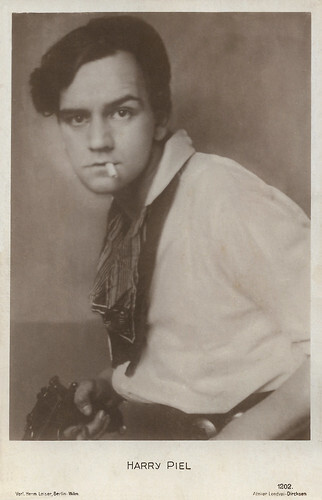
German postcard by Verlag Hermann Leiser, Berlin-Wilm., no. 1202, 1910s. Photo: Atelier Lendvai-Dircksen.
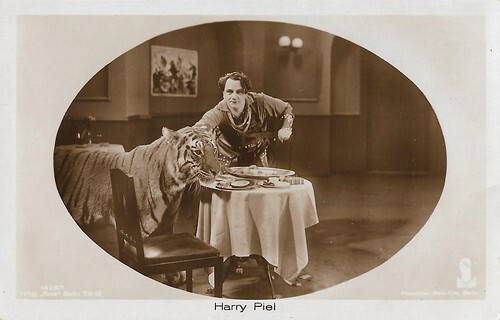
German postcard by Ross Verlag, Berlin, no. 1629/1. Photo: Nero-Film, Berlin. Was ist los im Zirkus Beely?/The Phantom of the Circus (Harry Piel, 1927) was Harry Piel's 75th film. It was the first Harry Piel film with a full-grown predator as Piel's companion: the tiger Bylard from the Leipzig Zoo. Mathias Bleckmann in his 1992 biography of Piel tells a nice anecdote. To the admiration of the wrangler present, Piel calmly managed to have the animal adapt to the camera. In order to have the tiger lick his face as the script demanded, he smeared his own mouth with cheese, but he had forgotten that a tiger's tongue might be sharp as a blade - so he ended up a few days in hospital...
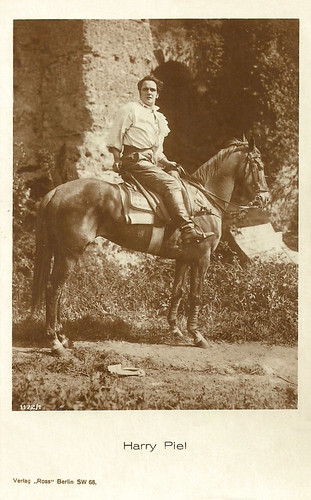
German postcard by Ross Verlag, no. 1172/1, 1927-1928. Photo: publicity still for the German-French co-production Zigano (Harry Piel, Gerard Bourgeois, 1925), for which the exteriors were shot in Rome.
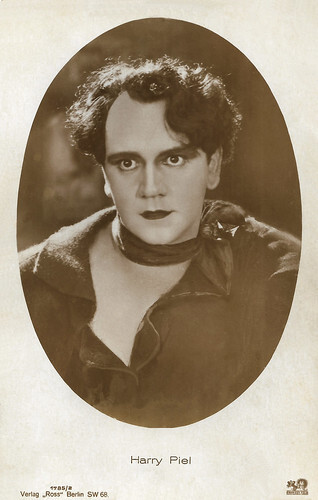
German postcard by Ross Verlag, Berlin, no. 1785/2, 1927-1928. Photo: Phoebus-Film. Harry Piel in Achtung Harry! Augen auf!/Neck or Nothing (Harry Piel, 1926).
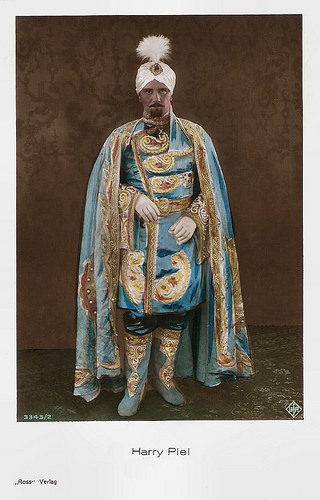
German postcard by Ross Verlag, no. 3343/2, 1928-1929. Photo: Ufa. Publicity still for Panik/Panic (Harry Piel, 1928), in which Piel plays Mister X, alias Harry Peel, alias The Rajah of Lahore.
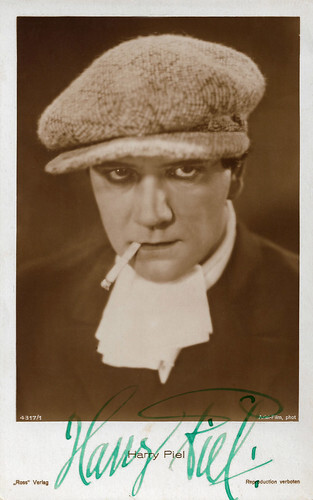
German postcard by Ross Verlag, Berlin, no. 4317/1, 1929-1930. Photo: Ariel-Film, Berlin.
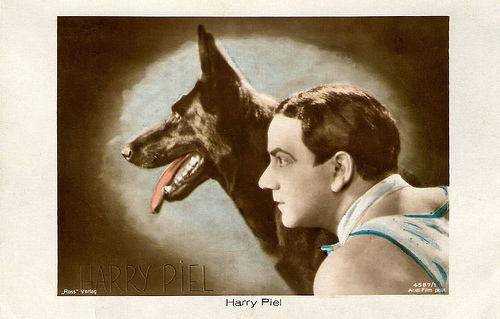
German postcard by Ross Verlag, Berlin, no. 4587/1, 1929-1930. Photo: Ariel-Film. Piel worked for Ariel-Film GmbH from 1928 to 1938. Publicity still for Sein bester Freund/His Best Friend (Harry Piel, 1929).
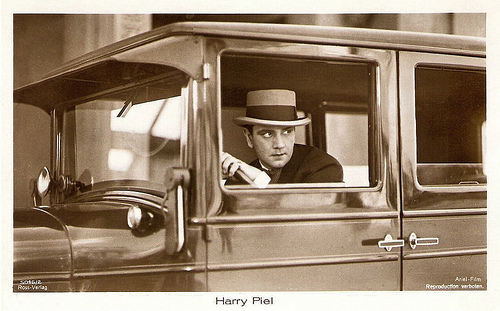
German postcard by Ross Verlag, no. 5046/2, 1930-1931. Photo: Ariel-Film. In 1930, Harry Piel produced and directed Achtung! Auto-Diebe!/Attention! Car Thieves! (Harry Piel, 1930). It was his last silent film.
The dynamite director
Hubert August Piel was born in Düsseldorf, Germany in 1892, as the son of an innkeeper and a farmer's daughter.
His career started already adventurous. After attending elementary school in Benrath and secondary school in Düsseldorf, Piel became a cadet in 1909 on a sail training ship, the Grand Duchess Elizabeth, but seven months later, he was sent back home because of heart failure. He started a commercial apprenticeship, did some odd jobs including working in a circus, and studied several foreign languages. In 1911 he went to Paris to become a stunt pilot.
In France, he met director Léonce Perret, who introduced him to Gaumont. There he wrote his first script and the cinema became his passion. In 1912 he moved to Berlin where he founded his first film company, the Kunst-Film-Verlags-GmbH. His debut as a director-writer-producer was the adventure film Schwarzes Blut/Black Blood (Harry Piel, 1912) starring Curt Goetz. Even though his company went bankrupt, Piel had become established.
In the following years, he shot dozens of short films full of action and adventure such as Der Triumph des Todes/The Triumph of the Death (Harry Piel, 1912), Ein Millionenraub/A Million Robbery (Harry Piel, 1914), and Die grosse Wette/The Large Bet (Harry Piel, 1916), all starring Ludwig Trautmann .
As a director, he had the nickname ‘the dynamite director’ because of all the exploding bridges and houses in his films. These explosions were often authentic. A demolition engineer notified him about forthcoming blow-ups. He filmed the explosions and inserted the footage into his films.
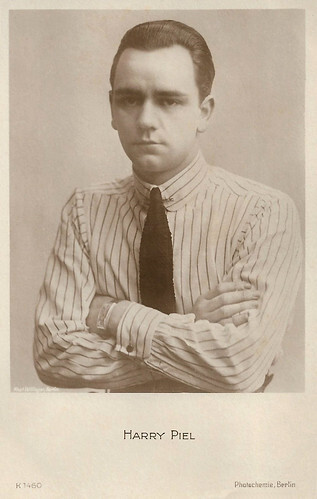
German postcard by Photochemie, Berlin, no. K. 1460. Photo: Willinger.
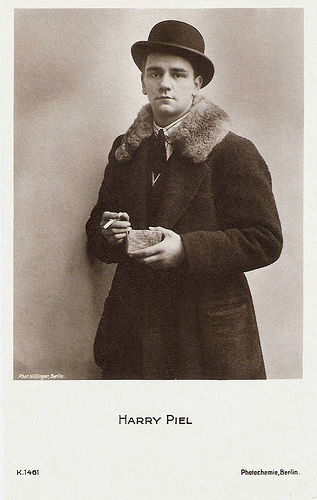
German postcard by Photochemie, Berlin, no. K. 1481. Photo: Willinger, Berlin.
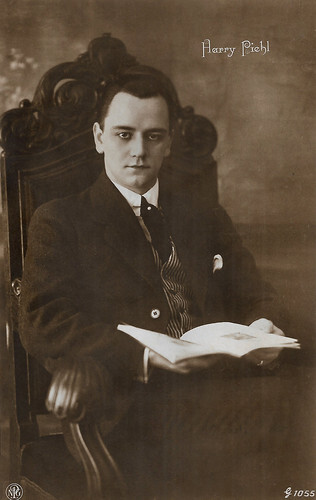
German postcard by NPG, no. G 1055. Sent by mail in 1917.
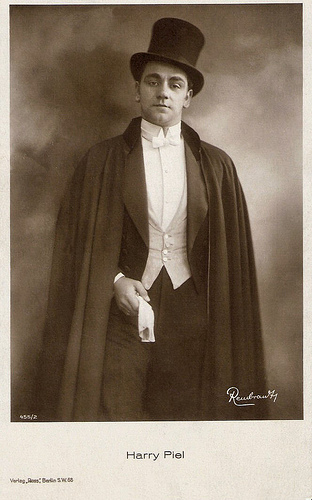
German postcard by Ross Verlag, Berlin, no. 455/2, 1919-1924. Photo: Rembrandt.
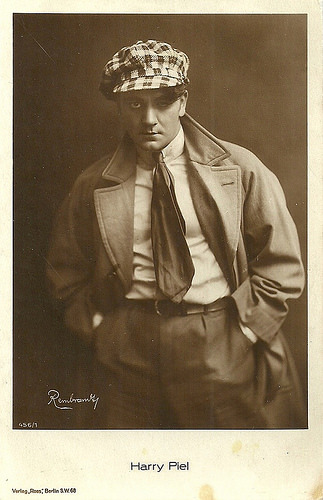
German postcard by Ross Verlag, Berlin, no. 456/1, 1919-1924. Photo: Rembrandt.
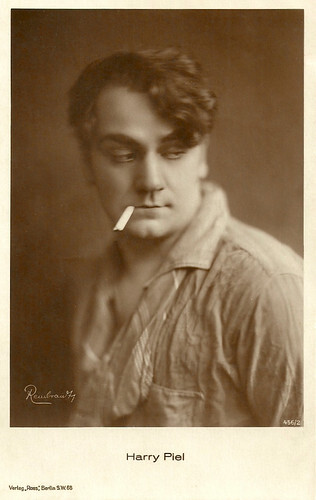
German postcard by Ross Verlag, Berlin, no. 456/2, 1919-1924. Photo: Rembrandt. Harry Piel in his own production Der Fürst der Berge/The King of the Mountains (1921), shot in Holland, Spain, Morocco and Rüdensdorfer Heinitzsee.
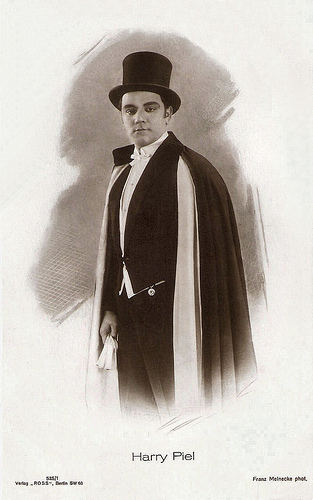
German postcard by Ross Verlag, Berlin, no. 525/1, 1919-1924. Photo: Franz Meinecke, Berlin.
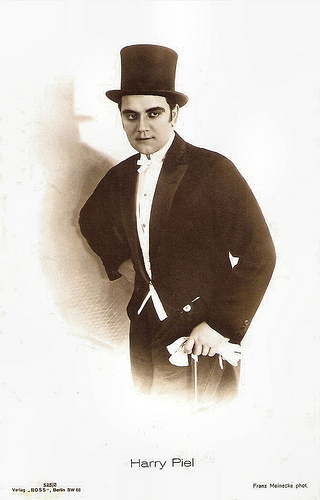
German postcard by Ross Verlag, Berlin, no. 525/2, 1919-1924. Photo: Franz Meinecke, Berlin.
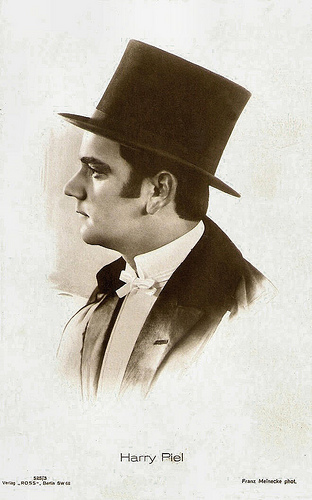
German postcard by Ross Verlag, Berlin, no. 525/3, 1919-1924. Photo: Franz Meinecke, Berlin.
Joe Deebs, Private Investigator
In 1915, Harry Piel became too bored with just standing behind the lens and he started to act before the camera. His first film as a leading actor, Die große Wette/The Large Bet (Harry Piel, 1916), was a Science-Fiction film on the subject of man-machines.
In Unter heißer Zone/Under the Hot Sun (Harry Piel, 1916) he used scenes with wild animals for the first time. He pretended that he did all his stunts himself, but the most dangerous stunts were carried out by Hermann Stetza.
During 1918 and 1919, Piel directed and starred in eight films of the Joe Deebs, private investigator series. Internationally he became a popular film star under the name of Harry Peel. Sadly not many of the films of his best period - the 1920s - have survived: 72 negatives of his films, including nearly all his silent pictures, perished in a WWII air raid.
David Cairns in his Notebook: "One that can still be seen is his circus mystery, Was ist Los im Zirkus Beely? (1927), in which Harry is falsely accused of murder and must uncover chicanery at a huge circus—not a travelling one, a permanent one, a mighty big top of the stone. Piel gets a lot of exciting use out of this edifice, rather like the way Buster Keaton would exploit the structural qualities of a locomotive or ocean liner. Most of the film is set here, as Harry evades capture by the stalwart Inspector Bull and hunts the three villains, a vixenish vamp, a hulking henchman and a masked man of mystery. The latter is authentically alarming, his mask a good deal scarier than Michael Myers' melted Shatner visage."
In 1927 he also starred in a double role alongside Marlene Dietrich in Sein größter Bluff/His Greatest Bluff (Henrik Galeen, Harry Piel, 1927). That same year he married actress Dary Holm , who appeared in several of his films.
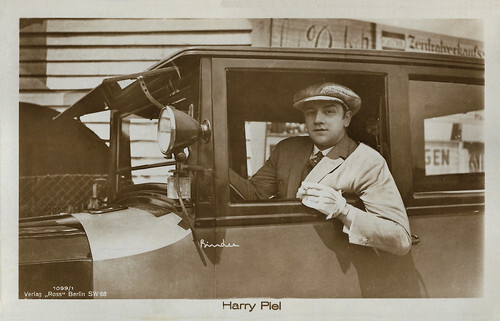
German postcard by Ross Verlag, Berlin, no. 1099/1, 1927-1928. Photo: Binder / Ariel-Film.
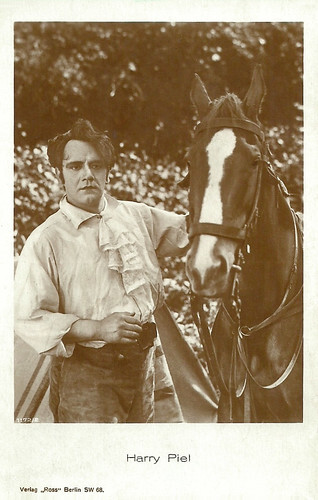
German postcard by Ross Verlag, Berlin, no. 1172/2, 1927-28. Photo: still for Zigano (Harry Piel, Gérard Bourgeois, 1925).
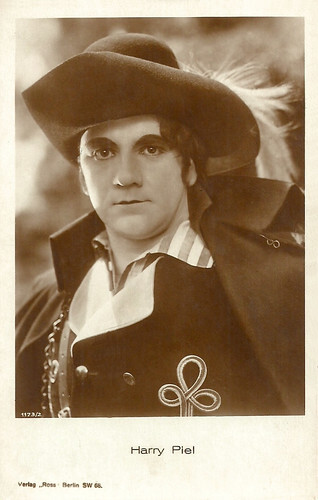
German postcard by Ross Verlag, Berlin, no. 1173/2, 1927-28. Photo: still for Zigano (Harry Piel, Gérard Bourgeois, 1925).
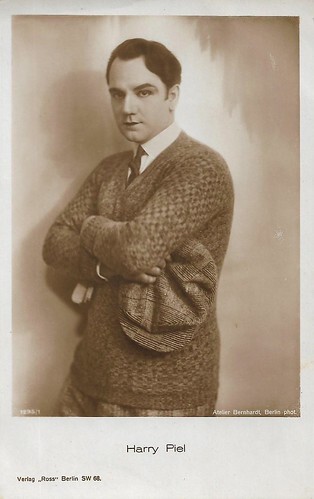
German postcard by Ross Verlag, Berlin, no. 1295/1, 1927-1928. Photo: Atelier Bernhardt, Berlin.
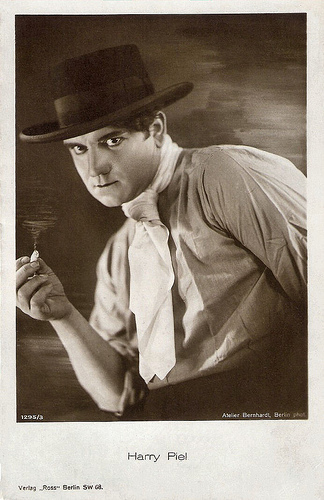
German postcard by Ross Verlag, Berlin, no. 1295/3, 1927-1928. Photo: Atelier Bernhardt, Berlin.
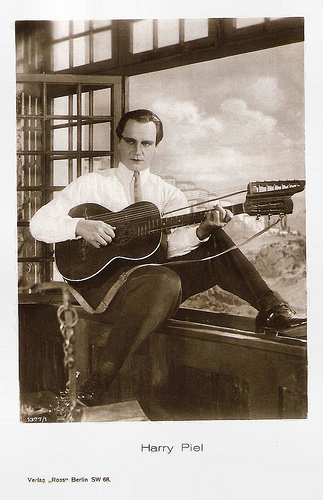
German postcard by Ross Verlag, Berlin, no. 1377/1, 1927-1928.
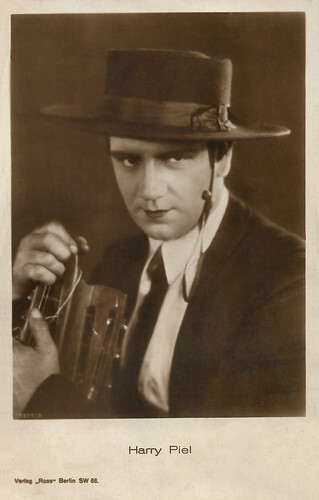
German postcard by Ross Verlag, Berlin, no. 1377/2, 1927-1928.
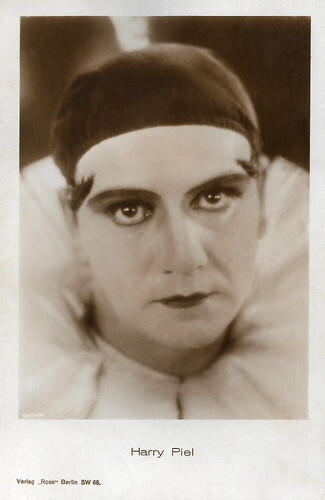
German postcard by Ross Verlag, Berlin, no. 1377/4, 1927-1928.
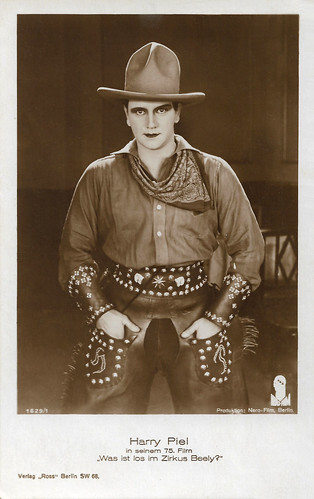
German postcard by Ross Verlag, Berlin, no. 1629/1, 1927-1928. Photo: Nero-Film, Berlin. Publicity still for Was ist los im Zirkus Beely?/The Phantom of the Circus (Harry Piel, 1927).
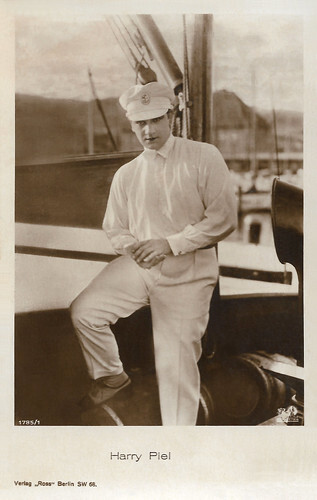
German postcard by Ross Verlag, Berlin, no. 1885/1, 1927-1928. Photo: Phoebus-Film. Harry Piel in Achtung Harry! Augen auf!/Neck or Nothing (Harry Piel, 1926).
Doppelganger
Effortlessly Harry Piel changed to sound film in the doppelganger comedy Er oder ich/Him or Me (Harry Piel, 1930) with Valerie Boothby .
Many adventure films followed, such as the box-office hits Schatten der Unterwelt/Shade of the Underworld (Harry Piel, 1931) with Elisabeth Pinajeff , Jonny stiehlt Europa/Johnny Steals Europe (Andrew Marton, Harry Piel, 1932) with Alfred Abel , and Der Dschungel ruft/The Call of the Jungle (Harry Piel, 1935) with Gerda Maurus .
Difficulties began with Panik/Panic (Harry Piel, 1940-1943), about an animal catcher who works for German zoos. At the film's climax, an air raid on a German city frees the wild animals in the zoo and only the heroic trapper can recapture them. The authorities found the air strikes too realistic and did not want the public to believe that Germany was in danger, so the film was forbidden.
Furthermore, his production company, Ariel Film Co., was liquidated through the nationalisation and 72 negatives of his films, nearly all silent films, were destroyed with an air strike. He was a sustaining member of the NSDAP (the Nazi party), and after the war he first concealed this to his enquirers. He was sentenced to six months of detention and five years of professional disqualification.
After his denazification in 1950, he refounded Ariel Film. His last directorial effort was Gesprengte Gitter/Elephant Fury (Harry Piel, 1953) with Dorothea Wieck , which was based on Panik. However, it had only moderate success. Piel gave up Ariel-film in 1960 and retired. Harry Piel died in Munich, Germany in 1963.
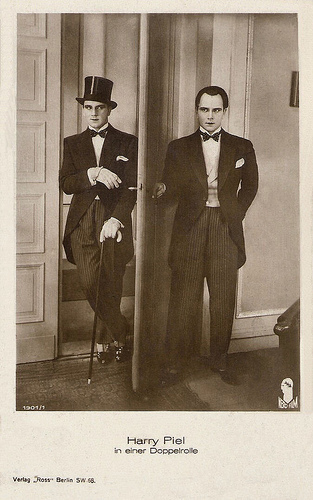
German postcard by Ross Verlag, Berlin, no. 1901/1, 1927-1928. Photo: Nero Film. Piel played twin brothers in Sein grösster Bluff/His Greatest Bluff (Harry Piel, 1927).
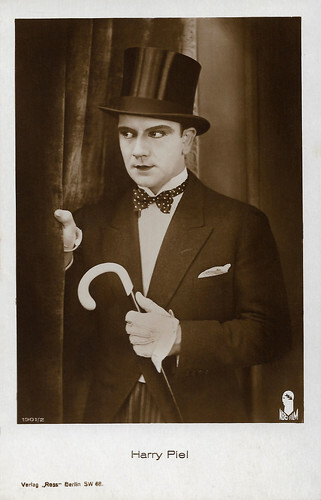
German postcard by Ross Verlag, Berlin, no. 1901/2, 1927-1928. Photo: Nero-Film.
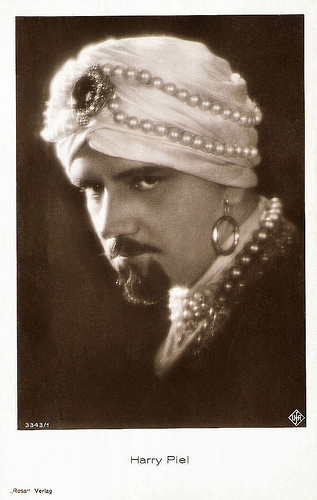
German postcard by Ross Verlag, Berlin, no. 3343/1, 1928-1929. Photo: Ufa. Publicity still for Panik/Panic (Harry Piel, 1928).
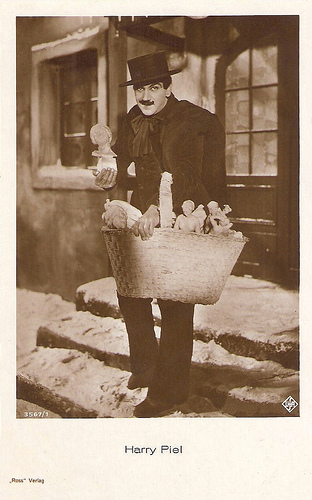
German postcard by Ross Verlag, Berlin, no. 3567/1, 1928-1929. Photo: Ufa.
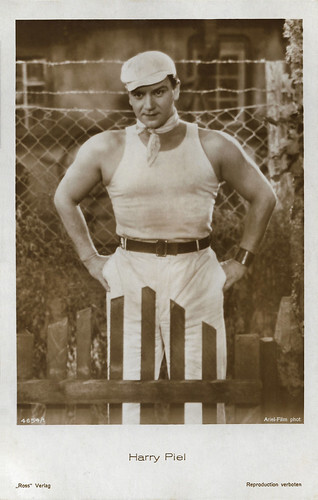
German postcard by Ross Verlag, Berlin, no. 4654/1, 1929-1930. Photo: Ariel-Film, Berlin. Publicity still for Sein bester Freund (Harry Piel, 1930).
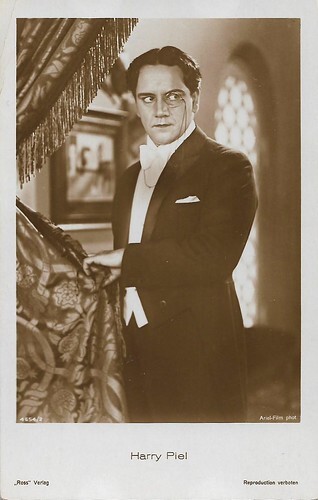
German postcard by Ross Verlag, Berlin, no. 4654/2, 1929-1930. Photo: Ariel-Film. Mailed in Riga, Latvia, in 1930.
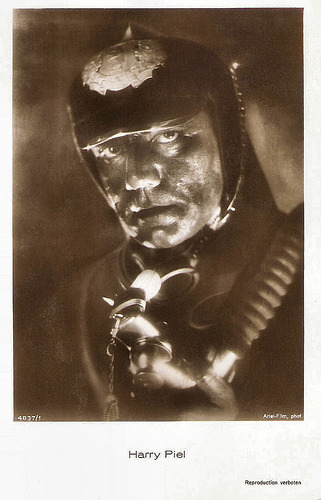
German postcard by Ross Verlag, Berlin, no. 4837/1, 1929-1930. Photo: Ariel-Film. Publicity still for Menschen im Feuer (Harry Piel, 1930).
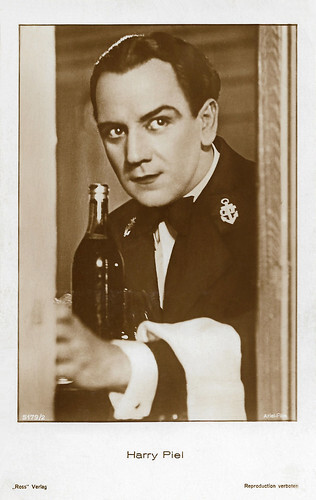
German postcard by Ross Verlag, Berlin, no. 5179/2, 1930-1931. Photo: Ariel-Film, Berlin. Publicity still for Er oder ich/He or I (Harry Piel, 1930).
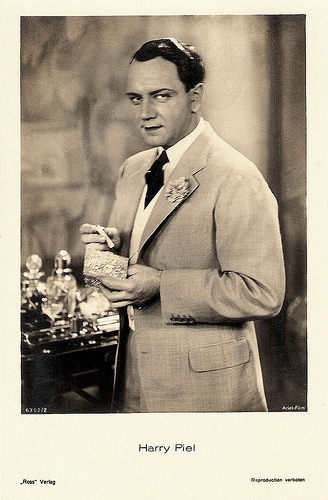
German postcard by Ross Verlag, no. 6302/2, 1931-1932. Photo: Ariel-Film.
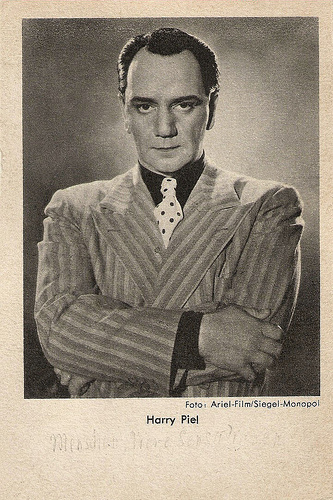
German postcard. Photo: Ariel-Film / Siegel-Monopol.
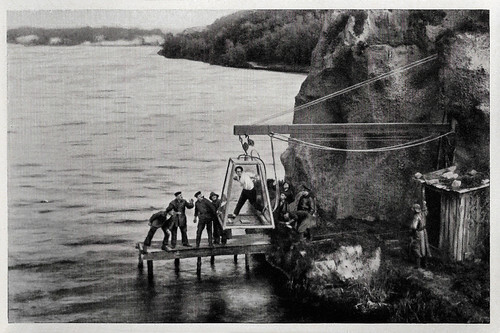
German collectors card by Ross Verlag in the series Vom Werden deutscher Filmkunst - Der Stumme Film, album no. 43, picture no. 126. Photo: Harry Piel-Film. Publicity still for Rivalen/Rivals (Harry Piel, 1923).
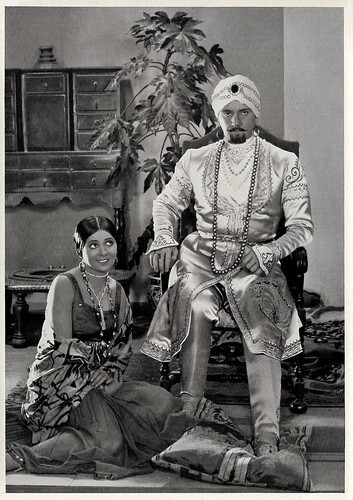
German collectors card by Ross Verlag in the series 'Vom Werden deutscher Filmkunst - Der stumme Film', album no. 42, picture no. 127. Photo: Ufa. Harry Piel and Dary Holm in Panik/Panic (Harry Piel, 1928).
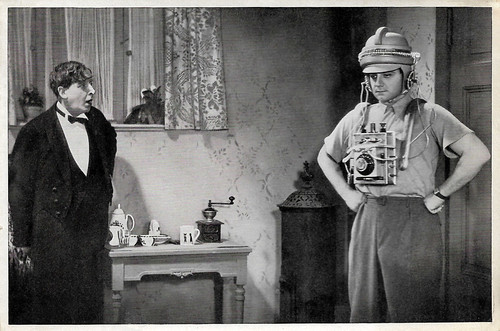
German collectors card in the series 'Vom Werden deutscher Filmkunst - Der Tonfilm', album no. 11, picture no. 90. Photo: Ariel-Film / Ross Verlag. Fritz Odemar and Harry Piel in Ein Unsichtbarer geht durch die Stadt/An Invisible Man Goes Through the City (Harry Piel, 1934).
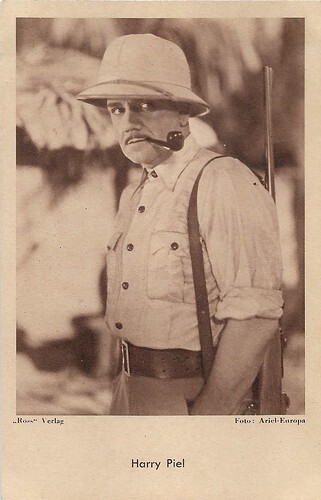
German postcard by "Das Programm von Heute" für Film und Theater GmbH / Ross Verlag. Photo: Ariel-Europa. Probably for the film Der Dschungel ruft/The Call of the Jungle (Harry Piel, 1936).
Sources: David Cairns (Notebook), Thomas Staedeli (Cyranos), Stephanie D'heil (Steffi-Line) (German), Wikipedia, Filmportal.de and .

German postcard by Verlag Hermann Leiser, Berlin-Wilm., no. 1202, 1910s. Photo: Atelier Lendvai-Dircksen.

German postcard by Ross Verlag, Berlin, no. 1629/1. Photo: Nero-Film, Berlin. Was ist los im Zirkus Beely?/The Phantom of the Circus (Harry Piel, 1927) was Harry Piel's 75th film. It was the first Harry Piel film with a full-grown predator as Piel's companion: the tiger Bylard from the Leipzig Zoo. Mathias Bleckmann in his 1992 biography of Piel tells a nice anecdote. To the admiration of the wrangler present, Piel calmly managed to have the animal adapt to the camera. In order to have the tiger lick his face as the script demanded, he smeared his own mouth with cheese, but he had forgotten that a tiger's tongue might be sharp as a blade - so he ended up a few days in hospital...

German postcard by Ross Verlag, no. 1172/1, 1927-1928. Photo: publicity still for the German-French co-production Zigano (Harry Piel, Gerard Bourgeois, 1925), for which the exteriors were shot in Rome.

German postcard by Ross Verlag, Berlin, no. 1785/2, 1927-1928. Photo: Phoebus-Film. Harry Piel in Achtung Harry! Augen auf!/Neck or Nothing (Harry Piel, 1926).

German postcard by Ross Verlag, no. 3343/2, 1928-1929. Photo: Ufa. Publicity still for Panik/Panic (Harry Piel, 1928), in which Piel plays Mister X, alias Harry Peel, alias The Rajah of Lahore.

German postcard by Ross Verlag, Berlin, no. 4317/1, 1929-1930. Photo: Ariel-Film, Berlin.

German postcard by Ross Verlag, Berlin, no. 4587/1, 1929-1930. Photo: Ariel-Film. Piel worked for Ariel-Film GmbH from 1928 to 1938. Publicity still for Sein bester Freund/His Best Friend (Harry Piel, 1929).

German postcard by Ross Verlag, no. 5046/2, 1930-1931. Photo: Ariel-Film. In 1930, Harry Piel produced and directed Achtung! Auto-Diebe!/Attention! Car Thieves! (Harry Piel, 1930). It was his last silent film.
The dynamite director
Hubert August Piel was born in Düsseldorf, Germany in 1892, as the son of an innkeeper and a farmer's daughter.
His career started already adventurous. After attending elementary school in Benrath and secondary school in Düsseldorf, Piel became a cadet in 1909 on a sail training ship, the Grand Duchess Elizabeth, but seven months later, he was sent back home because of heart failure. He started a commercial apprenticeship, did some odd jobs including working in a circus, and studied several foreign languages. In 1911 he went to Paris to become a stunt pilot.
In France, he met director Léonce Perret, who introduced him to Gaumont. There he wrote his first script and the cinema became his passion. In 1912 he moved to Berlin where he founded his first film company, the Kunst-Film-Verlags-GmbH. His debut as a director-writer-producer was the adventure film Schwarzes Blut/Black Blood (Harry Piel, 1912) starring Curt Goetz. Even though his company went bankrupt, Piel had become established.
In the following years, he shot dozens of short films full of action and adventure such as Der Triumph des Todes/The Triumph of the Death (Harry Piel, 1912), Ein Millionenraub/A Million Robbery (Harry Piel, 1914), and Die grosse Wette/The Large Bet (Harry Piel, 1916), all starring Ludwig Trautmann .
As a director, he had the nickname ‘the dynamite director’ because of all the exploding bridges and houses in his films. These explosions were often authentic. A demolition engineer notified him about forthcoming blow-ups. He filmed the explosions and inserted the footage into his films.

German postcard by Photochemie, Berlin, no. K. 1460. Photo: Willinger.

German postcard by Photochemie, Berlin, no. K. 1481. Photo: Willinger, Berlin.

German postcard by NPG, no. G 1055. Sent by mail in 1917.

German postcard by Ross Verlag, Berlin, no. 455/2, 1919-1924. Photo: Rembrandt.

German postcard by Ross Verlag, Berlin, no. 456/1, 1919-1924. Photo: Rembrandt.

German postcard by Ross Verlag, Berlin, no. 456/2, 1919-1924. Photo: Rembrandt. Harry Piel in his own production Der Fürst der Berge/The King of the Mountains (1921), shot in Holland, Spain, Morocco and Rüdensdorfer Heinitzsee.

German postcard by Ross Verlag, Berlin, no. 525/1, 1919-1924. Photo: Franz Meinecke, Berlin.

German postcard by Ross Verlag, Berlin, no. 525/2, 1919-1924. Photo: Franz Meinecke, Berlin.

German postcard by Ross Verlag, Berlin, no. 525/3, 1919-1924. Photo: Franz Meinecke, Berlin.
Joe Deebs, Private Investigator
In 1915, Harry Piel became too bored with just standing behind the lens and he started to act before the camera. His first film as a leading actor, Die große Wette/The Large Bet (Harry Piel, 1916), was a Science-Fiction film on the subject of man-machines.
In Unter heißer Zone/Under the Hot Sun (Harry Piel, 1916) he used scenes with wild animals for the first time. He pretended that he did all his stunts himself, but the most dangerous stunts were carried out by Hermann Stetza.
During 1918 and 1919, Piel directed and starred in eight films of the Joe Deebs, private investigator series. Internationally he became a popular film star under the name of Harry Peel. Sadly not many of the films of his best period - the 1920s - have survived: 72 negatives of his films, including nearly all his silent pictures, perished in a WWII air raid.
David Cairns in his Notebook: "One that can still be seen is his circus mystery, Was ist Los im Zirkus Beely? (1927), in which Harry is falsely accused of murder and must uncover chicanery at a huge circus—not a travelling one, a permanent one, a mighty big top of the stone. Piel gets a lot of exciting use out of this edifice, rather like the way Buster Keaton would exploit the structural qualities of a locomotive or ocean liner. Most of the film is set here, as Harry evades capture by the stalwart Inspector Bull and hunts the three villains, a vixenish vamp, a hulking henchman and a masked man of mystery. The latter is authentically alarming, his mask a good deal scarier than Michael Myers' melted Shatner visage."
In 1927 he also starred in a double role alongside Marlene Dietrich in Sein größter Bluff/His Greatest Bluff (Henrik Galeen, Harry Piel, 1927). That same year he married actress Dary Holm , who appeared in several of his films.

German postcard by Ross Verlag, Berlin, no. 1099/1, 1927-1928. Photo: Binder / Ariel-Film.

German postcard by Ross Verlag, Berlin, no. 1172/2, 1927-28. Photo: still for Zigano (Harry Piel, Gérard Bourgeois, 1925).

German postcard by Ross Verlag, Berlin, no. 1173/2, 1927-28. Photo: still for Zigano (Harry Piel, Gérard Bourgeois, 1925).

German postcard by Ross Verlag, Berlin, no. 1295/1, 1927-1928. Photo: Atelier Bernhardt, Berlin.

German postcard by Ross Verlag, Berlin, no. 1295/3, 1927-1928. Photo: Atelier Bernhardt, Berlin.

German postcard by Ross Verlag, Berlin, no. 1377/1, 1927-1928.

German postcard by Ross Verlag, Berlin, no. 1377/2, 1927-1928.

German postcard by Ross Verlag, Berlin, no. 1377/4, 1927-1928.

German postcard by Ross Verlag, Berlin, no. 1629/1, 1927-1928. Photo: Nero-Film, Berlin. Publicity still for Was ist los im Zirkus Beely?/The Phantom of the Circus (Harry Piel, 1927).

German postcard by Ross Verlag, Berlin, no. 1885/1, 1927-1928. Photo: Phoebus-Film. Harry Piel in Achtung Harry! Augen auf!/Neck or Nothing (Harry Piel, 1926).
Doppelganger
Effortlessly Harry Piel changed to sound film in the doppelganger comedy Er oder ich/Him or Me (Harry Piel, 1930) with Valerie Boothby .
Many adventure films followed, such as the box-office hits Schatten der Unterwelt/Shade of the Underworld (Harry Piel, 1931) with Elisabeth Pinajeff , Jonny stiehlt Europa/Johnny Steals Europe (Andrew Marton, Harry Piel, 1932) with Alfred Abel , and Der Dschungel ruft/The Call of the Jungle (Harry Piel, 1935) with Gerda Maurus .
Difficulties began with Panik/Panic (Harry Piel, 1940-1943), about an animal catcher who works for German zoos. At the film's climax, an air raid on a German city frees the wild animals in the zoo and only the heroic trapper can recapture them. The authorities found the air strikes too realistic and did not want the public to believe that Germany was in danger, so the film was forbidden.
Furthermore, his production company, Ariel Film Co., was liquidated through the nationalisation and 72 negatives of his films, nearly all silent films, were destroyed with an air strike. He was a sustaining member of the NSDAP (the Nazi party), and after the war he first concealed this to his enquirers. He was sentenced to six months of detention and five years of professional disqualification.
After his denazification in 1950, he refounded Ariel Film. His last directorial effort was Gesprengte Gitter/Elephant Fury (Harry Piel, 1953) with Dorothea Wieck , which was based on Panik. However, it had only moderate success. Piel gave up Ariel-film in 1960 and retired. Harry Piel died in Munich, Germany in 1963.

German postcard by Ross Verlag, Berlin, no. 1901/1, 1927-1928. Photo: Nero Film. Piel played twin brothers in Sein grösster Bluff/His Greatest Bluff (Harry Piel, 1927).

German postcard by Ross Verlag, Berlin, no. 1901/2, 1927-1928. Photo: Nero-Film.

German postcard by Ross Verlag, Berlin, no. 3343/1, 1928-1929. Photo: Ufa. Publicity still for Panik/Panic (Harry Piel, 1928).

German postcard by Ross Verlag, Berlin, no. 3567/1, 1928-1929. Photo: Ufa.

German postcard by Ross Verlag, Berlin, no. 4654/1, 1929-1930. Photo: Ariel-Film, Berlin. Publicity still for Sein bester Freund (Harry Piel, 1930).

German postcard by Ross Verlag, Berlin, no. 4654/2, 1929-1930. Photo: Ariel-Film. Mailed in Riga, Latvia, in 1930.

German postcard by Ross Verlag, Berlin, no. 4837/1, 1929-1930. Photo: Ariel-Film. Publicity still for Menschen im Feuer (Harry Piel, 1930).

German postcard by Ross Verlag, Berlin, no. 5179/2, 1930-1931. Photo: Ariel-Film, Berlin. Publicity still for Er oder ich/He or I (Harry Piel, 1930).

German postcard by Ross Verlag, no. 6302/2, 1931-1932. Photo: Ariel-Film.

German postcard. Photo: Ariel-Film / Siegel-Monopol.

German collectors card by Ross Verlag in the series Vom Werden deutscher Filmkunst - Der Stumme Film, album no. 43, picture no. 126. Photo: Harry Piel-Film. Publicity still for Rivalen/Rivals (Harry Piel, 1923).

German collectors card by Ross Verlag in the series 'Vom Werden deutscher Filmkunst - Der stumme Film', album no. 42, picture no. 127. Photo: Ufa. Harry Piel and Dary Holm in Panik/Panic (Harry Piel, 1928).

German collectors card in the series 'Vom Werden deutscher Filmkunst - Der Tonfilm', album no. 11, picture no. 90. Photo: Ariel-Film / Ross Verlag. Fritz Odemar and Harry Piel in Ein Unsichtbarer geht durch die Stadt/An Invisible Man Goes Through the City (Harry Piel, 1934).

German postcard by "Das Programm von Heute" für Film und Theater GmbH / Ross Verlag. Photo: Ariel-Europa. Probably for the film Der Dschungel ruft/The Call of the Jungle (Harry Piel, 1936).
Sources: David Cairns (Notebook), Thomas Staedeli (Cyranos), Stephanie D'heil (Steffi-Line) (German), Wikipedia, Filmportal.de and .
Published on October 09, 2023 22:00
October 8, 2023
Italia Vitaliani, Giuseppe Sterni and La madre (1917)
One of the films shown at the Pordenone Silent Film Festival 2023 is La Madre (1917) from the Eye Filmmuseum collection. Giuseppe Sterni directed this Italian film and also played the protagonist, a poor village boy with artist’s aspirations. His mother is played by Italia Vitaliani. "Behind her rigour and headstrong character, Vitaliani’s frailty was hidden, ready to take over. So the actress balanced between moments of enthusiasm and moments of deeply felt insecurity and mistrust", Ivo Blom cites Maria Procino (Enciclopedia delle donne) in the festival catalogue. EFSP was permitted to use his catalogue text for this post.

Italian postcard by NPG, no. 643. Photo: Sciutto. Italia Vitaliani . Gigi Sciutto was a famous Genovese photographer in the early 1900s. He supposedly shot the first film footage on Genova around 1897.
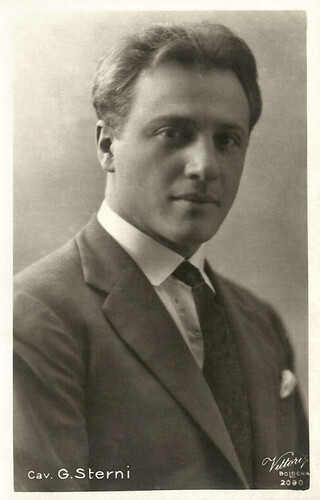
Italian postcard by Vettori, Bologna, no. 2000. Giuseppe Sterni.
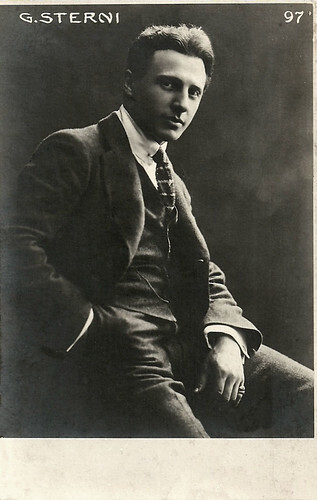
American or British postcard, no. 97. Editor unknown. Giuseppe Sterni.
A representative of the new school of acting
When Italia Vitaliani (1866-1938) acted as the mother in Giuseppe Sterni’s film La madre in 1916-17, she was already for decades a highly acclaimed stage actress, rivalling Eleonora Duse , whose niece she was. Thanks to her parents and uncle, actor, playwright and artistic director Cesare Vitaliani, Italia had had a comet-like stage career, becoming in 1892 even 'capocomico', artistic director, but also the administrator. She was one of the first women to perform this profession in Italy, and she did so well that people called her 'a perfect gentleman'.
Vitaliani was mentioned as a representative of the ‘new school of acting’ which also included her cousin Eleonora , Emma and Irma Grammatica , and Virginia Reiter. Vitaliani was a serious rival of her cousin Eleonora; both had a liking for the modern repertory and the ‘natural’ performance. Italia toured capitals but also small towns, staging Mary Stuart, Hedda Gabler, and Elisabeth of England, always with the woman at the centre.
In the 1890s she did a tour in Russia and Romania but also travelled to Spain and South America, where she was an acclaimed actress. In 1907 she founded a theatre company with her cousin Carlo Duse (1866-1937), whom she married. They performed repertory by Emile Zola , Henrik Ibsen, Alexandre Dumas and Maxim Gorki, but also by Duse himself. Playwright Roberto Bracco wrote: "The art of Italia Vitaliani is made of such subtle intentions, so humanely intimate, so exquisitely precious, that one cannot exactly judge her if one is not gifted of an equally fine aesthetic perception".
Sources strongly differ about Vitaliani’s film career. Italia Vitaliani , who only occasionally performed in films, made her screen debut with the title role in the short Fedra (Film d’Arte Italiana, 1909-1910), based on Jean Racine’s famous stage play. IMDb does not mention her title role in the Milano Film melodrama La madre/The Mother (Giuseppe Sterni, 1917). The film was based on the play 'La mare' (1907) by the Catalan writer and artist Santiago Rusiñol, which Vitaliani had performed with great success all over Spain in 1907.
Actually, Vitaliani had been a regular performer of Rusiñol’s plays around the 1900s, to great acclaim in Spain, in particular in Barcelona, and to Rusiñol’s own great satisfaction, praising her restrained, realist action. In 1901 he wrote: “The art of Italy Vitaliani is not of great plastic lines, nor does it wear the broad garb of Roman statues or Greek tragedies. It is of delicate lines and subtle emotions; it is art of actual life, the art of rare sensations, of lip-smacking phrases and exquisite perfumes; the art of feeling the nerves vibrating softly like the strings of a finely tuned lyre giving notes of subdued colours, of dying smiles and of all the shades of modern suffering.”
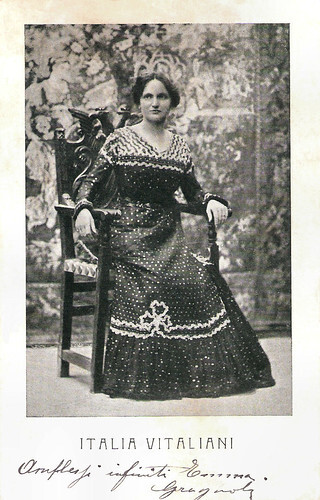
Italian postcard. Mailed in Rome, Monteverde, early 20th century. Italia Vitaliani .
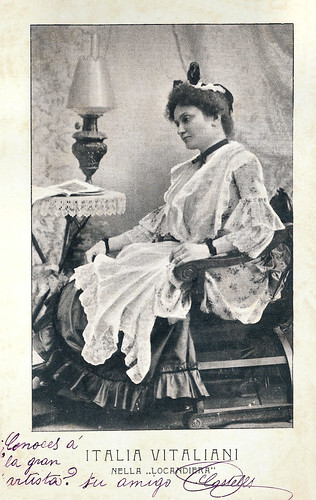
Italian postcard. Italia Vitaliani in the Carlo Goldoni theatre play 'La Locandiera'. Postcard mailed in Barcelona, Spain, early 20th century. The handwritten text by Casteles says: Do you know this great artist?
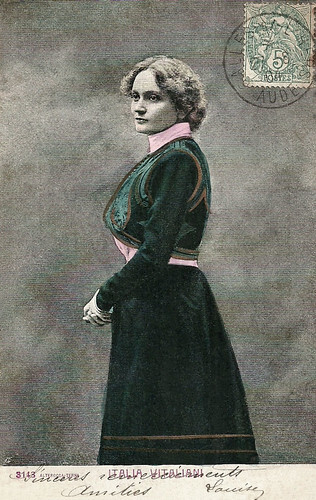
Italian postcard by Alterocca, Terni, no. 3143. Card mailed 27-8-1904 in Salles d'Aude, France. Italia Vitaliani. 'Sincères remerciements. Amitiés, Louise.'
Immortalising his mother in her Mother of Sorrows pose
Just a few years ago, the film La madre was rediscovered at the Eye Filmmuseum. In La madre, Giuseppe Sterni played the protagonist, a poor village boy with artist’s aspirations. His mother runs a bakery but she understands her son wants something else. On the invitation of another young artist, he goes to live in the city and starts a career as a painter. His female model and, even more so, her mother are gold-diggers. When his mother visits her son, she chases them, to the son’s chagrin. His fellow artist makes it clear though that his mother is his best model. Indeed, the portrait of his mother is a success in the art exhibition and brings him fame and fortune.
However, the success comes with a price to pay. Apart from some bit parts in the 1920s, Vitaliani didn’t act in film anymore but focused on the stage, and on acting teachings. She finally retired from screen and stage because of nervous exhaustion, becoming a misanthropist. In Milano, she lived alone and forgotten, and only thanks to the help of actors, writers and friends, she managed to survive her worst moments. Whoever asked her whether she would write her recollections, she answered: “I promise, I’ll never write them”.
The director of La madre, Giuseppe Sterni (1883-1952) started his stage career in a company of wandering artists in 1904, making a career in various stage companies, including that of Italia Vitaliani , rising to ‘primo attore giovane’ in 1906/7 and ‘primo attore’ in 1912, while from 1913 he became director himself of various theatrical companies. In 1916 Sterni temporarily left the stage for the cinema. He worked at several production companies, in particular at Milano Films. In addition to his film acting, he started to direct too, often playing the male leads in his own films. In addition to the mature Vitaliani, he would work with the young actresses Lina Millefleurs , Suzanne d’Armelle, Linda Pini and Paola Borboni . In 1921 he began again to direct and act in films, working with such actresses as Borboni and Carmen Boni . In 1921 he also founded his own film production company in Rome, but Sterni Film was short-lived. During the 1920s Sterni did a stage tour to New York. Here he remained, founding his own company, with a repertory ranging from William Shakespeare to Giovanni Verga, Gabriele D'Annunzio and Luigi Pirandello, and becoming popular within the Italian-American community in New York. He would stay in New York until his retirement in 1949.
La madre came out quite late in the Netherlands, in 1921, when it was released by F.A.N. Film, the distribution agency funded by film pioneer Franz Anton Nöggerath Jr. and in 1921 taken over by his former associate Piet Vermeer Sr. It was screened as a double bill together with another elder film, the Western drama The Brute Breaker (1919) with Frank Mayo. Unfortunately, many European and American films produced during the First World War had late releases in the Netherlands. At the premiere at Nöggerath’s own Bioscope-Theater in Amsterdam, the regular violin player Boris Lensky, one of the most acclaimed cinema musicians at the time in the Netherlands, gave a violin solo of Paolo Tosti’s song Ninon while accompanying the film.
During the 2018 workshop 'A Dive into the Collections of the Eye Film Museum', La madre was rediscovered as an unknown melodrama, which strikes because of the immobility of the dominating mother, thus stressing the stillness of painting vis à vis cinema, and even showing model and painting side by side. It is as if a tableau vivant, but then rather the inversed version of it, because of instead of a painting coming to life it is the filmic model becoming lifeless (a bit as in Edgar Allan Poe’s 'The Oval Portrait'). Moreover, the self-sacrificing mother who still manages the situation and is the opposite of a hyperbolic, hysterical character - thus creating a strong feeling of guilt in the son - is also a prototype of melodramatic silent cinema. The son will symbolically efface a portrait of his model and girlfriend, in order to find a canvas to immortalise his mother in her Mother of Sorrows pose.
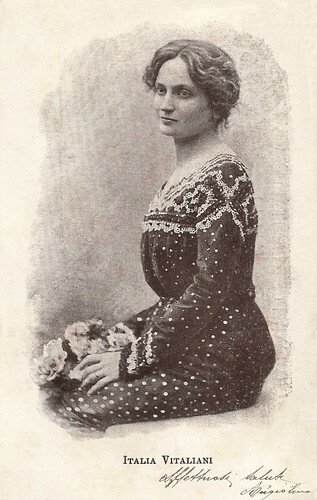
Italian postcard. Mailed 1902 in Italy: 'Affetuosi saluti'.
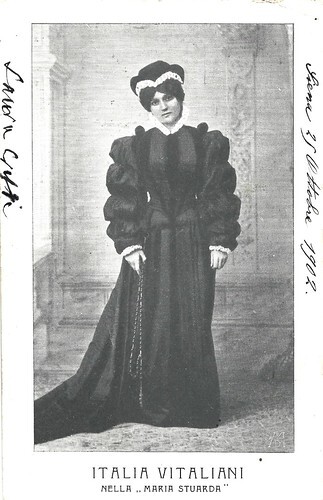
Italian postcard, mailed in Siena, 25 October 1902. Italia Vitaliani in the play 'Maria Stuarda' (Mary Stuart, 1800) by Friedrich von Schiller, which was turned into an opera by Donizetti in 1835.
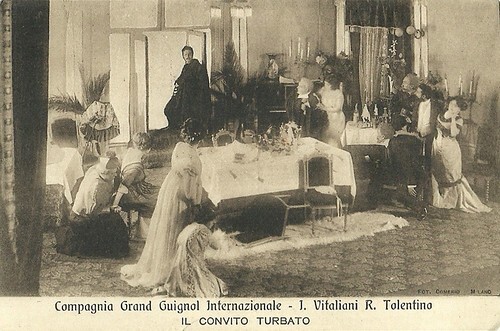
Italian postcard. Photo: Comerio, Milan. Italia Vitaliani and Riccardo Tolentino in the play 'Il convito turbato', performed by the Compagnia Grand Guignol Internazionale, c. 1910-11. This company was founded in 1910 by Tolentino and Vitaliani, after the founding of the first Italian Grand Guignol company by Alfredo Sainati in 1908. The two companies were fierce rivals, but Tolentino's company already halted in 1911.
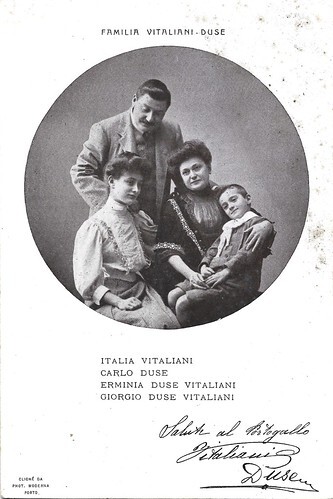
Portuguese postcard by Ed. Fabri, Porto. Photo: Moderna, Porto. Italian stage actress Italia Vitaliani with her husband Carlo Duse and their children Erminia and Giorgio. Caption: "Saluti al Portogallo, Vitaliani, Duse."
Text and Postcards: Ivo Blom.

Italian postcard by NPG, no. 643. Photo: Sciutto. Italia Vitaliani . Gigi Sciutto was a famous Genovese photographer in the early 1900s. He supposedly shot the first film footage on Genova around 1897.

Italian postcard by Vettori, Bologna, no. 2000. Giuseppe Sterni.

American or British postcard, no. 97. Editor unknown. Giuseppe Sterni.
A representative of the new school of acting
When Italia Vitaliani (1866-1938) acted as the mother in Giuseppe Sterni’s film La madre in 1916-17, she was already for decades a highly acclaimed stage actress, rivalling Eleonora Duse , whose niece she was. Thanks to her parents and uncle, actor, playwright and artistic director Cesare Vitaliani, Italia had had a comet-like stage career, becoming in 1892 even 'capocomico', artistic director, but also the administrator. She was one of the first women to perform this profession in Italy, and she did so well that people called her 'a perfect gentleman'.
Vitaliani was mentioned as a representative of the ‘new school of acting’ which also included her cousin Eleonora , Emma and Irma Grammatica , and Virginia Reiter. Vitaliani was a serious rival of her cousin Eleonora; both had a liking for the modern repertory and the ‘natural’ performance. Italia toured capitals but also small towns, staging Mary Stuart, Hedda Gabler, and Elisabeth of England, always with the woman at the centre.
In the 1890s she did a tour in Russia and Romania but also travelled to Spain and South America, where she was an acclaimed actress. In 1907 she founded a theatre company with her cousin Carlo Duse (1866-1937), whom she married. They performed repertory by Emile Zola , Henrik Ibsen, Alexandre Dumas and Maxim Gorki, but also by Duse himself. Playwright Roberto Bracco wrote: "The art of Italia Vitaliani is made of such subtle intentions, so humanely intimate, so exquisitely precious, that one cannot exactly judge her if one is not gifted of an equally fine aesthetic perception".
Sources strongly differ about Vitaliani’s film career. Italia Vitaliani , who only occasionally performed in films, made her screen debut with the title role in the short Fedra (Film d’Arte Italiana, 1909-1910), based on Jean Racine’s famous stage play. IMDb does not mention her title role in the Milano Film melodrama La madre/The Mother (Giuseppe Sterni, 1917). The film was based on the play 'La mare' (1907) by the Catalan writer and artist Santiago Rusiñol, which Vitaliani had performed with great success all over Spain in 1907.
Actually, Vitaliani had been a regular performer of Rusiñol’s plays around the 1900s, to great acclaim in Spain, in particular in Barcelona, and to Rusiñol’s own great satisfaction, praising her restrained, realist action. In 1901 he wrote: “The art of Italy Vitaliani is not of great plastic lines, nor does it wear the broad garb of Roman statues or Greek tragedies. It is of delicate lines and subtle emotions; it is art of actual life, the art of rare sensations, of lip-smacking phrases and exquisite perfumes; the art of feeling the nerves vibrating softly like the strings of a finely tuned lyre giving notes of subdued colours, of dying smiles and of all the shades of modern suffering.”

Italian postcard. Mailed in Rome, Monteverde, early 20th century. Italia Vitaliani .

Italian postcard. Italia Vitaliani in the Carlo Goldoni theatre play 'La Locandiera'. Postcard mailed in Barcelona, Spain, early 20th century. The handwritten text by Casteles says: Do you know this great artist?

Italian postcard by Alterocca, Terni, no. 3143. Card mailed 27-8-1904 in Salles d'Aude, France. Italia Vitaliani. 'Sincères remerciements. Amitiés, Louise.'
Immortalising his mother in her Mother of Sorrows pose
Just a few years ago, the film La madre was rediscovered at the Eye Filmmuseum. In La madre, Giuseppe Sterni played the protagonist, a poor village boy with artist’s aspirations. His mother runs a bakery but she understands her son wants something else. On the invitation of another young artist, he goes to live in the city and starts a career as a painter. His female model and, even more so, her mother are gold-diggers. When his mother visits her son, she chases them, to the son’s chagrin. His fellow artist makes it clear though that his mother is his best model. Indeed, the portrait of his mother is a success in the art exhibition and brings him fame and fortune.
However, the success comes with a price to pay. Apart from some bit parts in the 1920s, Vitaliani didn’t act in film anymore but focused on the stage, and on acting teachings. She finally retired from screen and stage because of nervous exhaustion, becoming a misanthropist. In Milano, she lived alone and forgotten, and only thanks to the help of actors, writers and friends, she managed to survive her worst moments. Whoever asked her whether she would write her recollections, she answered: “I promise, I’ll never write them”.
The director of La madre, Giuseppe Sterni (1883-1952) started his stage career in a company of wandering artists in 1904, making a career in various stage companies, including that of Italia Vitaliani , rising to ‘primo attore giovane’ in 1906/7 and ‘primo attore’ in 1912, while from 1913 he became director himself of various theatrical companies. In 1916 Sterni temporarily left the stage for the cinema. He worked at several production companies, in particular at Milano Films. In addition to his film acting, he started to direct too, often playing the male leads in his own films. In addition to the mature Vitaliani, he would work with the young actresses Lina Millefleurs , Suzanne d’Armelle, Linda Pini and Paola Borboni . In 1921 he began again to direct and act in films, working with such actresses as Borboni and Carmen Boni . In 1921 he also founded his own film production company in Rome, but Sterni Film was short-lived. During the 1920s Sterni did a stage tour to New York. Here he remained, founding his own company, with a repertory ranging from William Shakespeare to Giovanni Verga, Gabriele D'Annunzio and Luigi Pirandello, and becoming popular within the Italian-American community in New York. He would stay in New York until his retirement in 1949.
La madre came out quite late in the Netherlands, in 1921, when it was released by F.A.N. Film, the distribution agency funded by film pioneer Franz Anton Nöggerath Jr. and in 1921 taken over by his former associate Piet Vermeer Sr. It was screened as a double bill together with another elder film, the Western drama The Brute Breaker (1919) with Frank Mayo. Unfortunately, many European and American films produced during the First World War had late releases in the Netherlands. At the premiere at Nöggerath’s own Bioscope-Theater in Amsterdam, the regular violin player Boris Lensky, one of the most acclaimed cinema musicians at the time in the Netherlands, gave a violin solo of Paolo Tosti’s song Ninon while accompanying the film.
During the 2018 workshop 'A Dive into the Collections of the Eye Film Museum', La madre was rediscovered as an unknown melodrama, which strikes because of the immobility of the dominating mother, thus stressing the stillness of painting vis à vis cinema, and even showing model and painting side by side. It is as if a tableau vivant, but then rather the inversed version of it, because of instead of a painting coming to life it is the filmic model becoming lifeless (a bit as in Edgar Allan Poe’s 'The Oval Portrait'). Moreover, the self-sacrificing mother who still manages the situation and is the opposite of a hyperbolic, hysterical character - thus creating a strong feeling of guilt in the son - is also a prototype of melodramatic silent cinema. The son will symbolically efface a portrait of his model and girlfriend, in order to find a canvas to immortalise his mother in her Mother of Sorrows pose.

Italian postcard. Mailed 1902 in Italy: 'Affetuosi saluti'.

Italian postcard, mailed in Siena, 25 October 1902. Italia Vitaliani in the play 'Maria Stuarda' (Mary Stuart, 1800) by Friedrich von Schiller, which was turned into an opera by Donizetti in 1835.

Italian postcard. Photo: Comerio, Milan. Italia Vitaliani and Riccardo Tolentino in the play 'Il convito turbato', performed by the Compagnia Grand Guignol Internazionale, c. 1910-11. This company was founded in 1910 by Tolentino and Vitaliani, after the founding of the first Italian Grand Guignol company by Alfredo Sainati in 1908. The two companies were fierce rivals, but Tolentino's company already halted in 1911.

Portuguese postcard by Ed. Fabri, Porto. Photo: Moderna, Porto. Italian stage actress Italia Vitaliani with her husband Carlo Duse and their children Erminia and Giorgio. Caption: "Saluti al Portogallo, Vitaliani, Duse."
Text and Postcards: Ivo Blom.
Published on October 08, 2023 22:00
October 7, 2023
The early Western and the origins of the Western
The Western was enormously popular in the silent-film era (1894–1927). The genre is set in the American West, usually in the period from the 1850s to the end of the 19th century. In 2016, Richard Abel curated three early Western programmes at the Giornate del Cinema Muto. This year, Abel is back at the Pordenone Silent Film Festival with a new programme on the early Western and the origins of the Western. We selected postcards for this post that illustrate the influence of art and theatre on the early Western and we included postcards of the first cowboy stars. Happy trails!
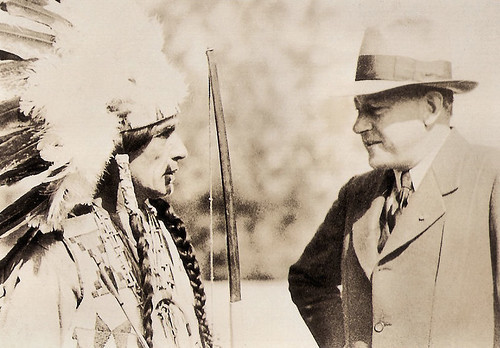
Dutch postcard, no. P. 13730. Photo: M.G.M. Cecil B. DeMille and Chief Little Bison.
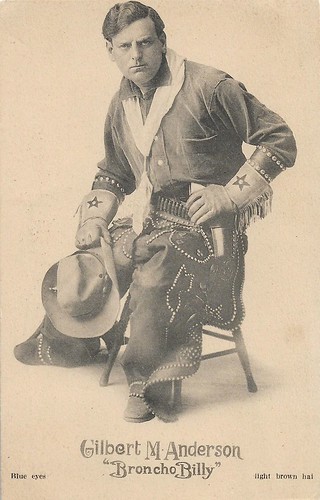
American postcard by Kraus Mfg., Co., New York. Photo: Essanay. Gilbert M. Anderson (Broncho Billy). Blue eyes light, brown hat.
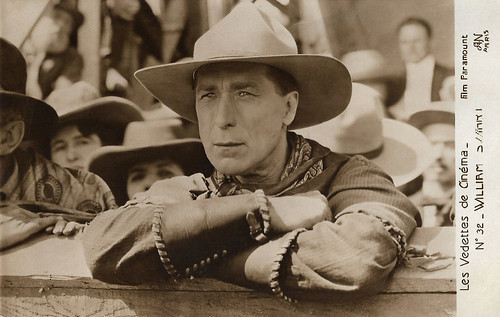
French postcard by A.N. in the Les vedettes de cinéma series, Paris, no. 32. Photo: Film Paramount. William S. Hart .

American card. Tom Mix and his horse Tony, posing.
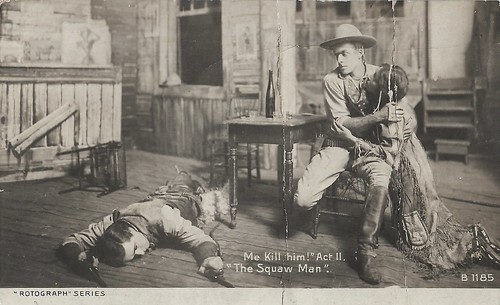
American postcard in the Rotograph series, no. B1185. Scene from the stage play version of 'The Squaw Man' by Edwin Milton Royle (1905), performed from 1905. Act II, caption: Me Kill him! (Nat-u-Ritch has killed the evil Cash Hawkins, who wanted to kill Jim Carson aka James Wynnegate). This photo is identical to the poster that was made in 1905 by the Strobridge Co. of Cincinnati for the play and that some today use as if for the 1914 film by Cecil B. DeMille . Depicted here are William Faversham as James Wynnegate, Adrienne Morrison as Nat-u-Ritch, and (just killed) William S. Hart as Cash Hawkins.
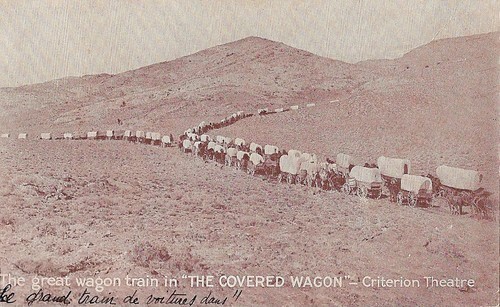
American card for the Criterion Theatre, with French handwriting. Caption: The great wagon train in "The Covered Wagon", refers to the American silent film The Covered Wagon (James Cruze, 1923).
The earliest known Western narrative film
Film Westerns derive from the Wild West shows that began in the 1870s. These shows, which included stage plays and outdoor exhibitions, culminated in Buffalo Bill's Wild West, a touring performance that ran from 1883 to 1913. Wild West shows, which were intended for urban audiences, established many of the elements that came to define Western films, such as the blending of fact and fiction and the romanticisation of the frontier. The first films that belong to the Western genre are a series of short single reel silents made in 1894 by Edison Studios at their Black Maria studio in West Orange, New Jersey. These featured veterans of Buffalo Bill's Wild West show exhibiting skills acquired by living in the Old West – they included Annie Oakley (shooting) and members of the Sioux (dancing).
The earliest known Western narrative film is not an American production but a British short Kidnapping by Indians. It was made by the Mitchell & Kenyon film company in Blackburn, England, in 1899. The plot concerns an attack by Native Americans on a camp where white people are staying. The attackers set fire to the camp and kidnap a young girl. Some cowboys arrive and a gunfight begins. The captured girl is rescued by the cowboys. The running time is 1 minute. According to Jamie Holman, a local researcher, James Kenyon of Mitchell & Kenyon met some Americans in Blackburn when he was a boy. This sparked his interest in the 'Wild West' and ultimately led to the production of this film. The storyline of a white girl being kidnapped by Indians is also in James Fenimore Cooper's novel 'The Last of the Mohicans' (1826) and many later Wild West films such as John Ford's The Searchers (1956).
Another influential early British film A Daring Daylight Burglary (1903) directed by Frank Mottershaw and produced by the Sheffield Photo Company, features members from the Sheffield Fire Brigade as part of the cast. The innovative technique of the film inspired Edwin S. Porter's film The Great Train Robbery (1903), produced by the Edison Manufacturing Company and starring Gilbert M. 'Broncho Billy' Anderson. In The Great Train Robbery, a gang of outlaws hold up and rob a steam locomotive at a station in the American West. The outlaws flee across mountainous terrain and are finally defeated by a posse of locals.
Porter's storytelling approach allowed him to include many popular techniques of the time, including scenes staged in wide shots, a matte effect, and an attempt to indicate simultaneous action across multiple scenes. Camera pans, location shooting, and moments of violent action helped give The Great Train Robbery a sense of rough-edged immediacy. A special close-up shot, which was unconnected to the story and could either begin or end the film depending on the projectionist's whim, showed Justus D. Barnes, as the outlaw leader, emptying his gun directly into the camera.
Although The Great Train Robbery was not the first Western, Porter's film set the pattern — of crime, pursuit, and retribution — for the Western film as a genre. The short film draws on many sources, including a robust existing tradition of Western films, recent European innovations in film technique, the 1896 play of the same name by Scott Marble, the popularity of train-themed films, and possibly real-life incidents involving outlaws such as Butch Cassidy. The Great Train Robbery was an unprecedented commercial success. Though it did not significantly influence or advance the Western film genre, it was widely distributed and copied.
D.W. Griffith made a series of highly successful Westerns including In Old California (1910), The Twisted Trail (1910) with Mary Pickford , The Last Drop of Water (1911), with the Western's first characteristic scenes of a wagon train siege and a cavalry rescue, the innovatively-filmed Fighting Blood (1911) about conflict between white settlers and Sioux Indians in the Dakota territory of 1899 and Griffith's last major Biograph Western filmed in Southern California, titled The Battle of Elderbush Gulch (1914).
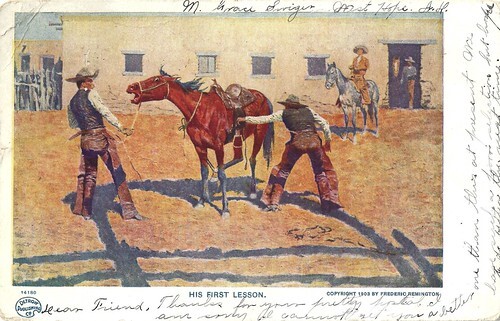
American postcard by Detroit Publishing Co., 14180, postcard mailed US 1907. His First Lesson (1903) by the American artist Frederic Remington (1861-1909). Today, the painting is housed at the Amon Carter Museum of American Art, Fort Worth, Texas, and is part of the Amon G. Carter Collection.
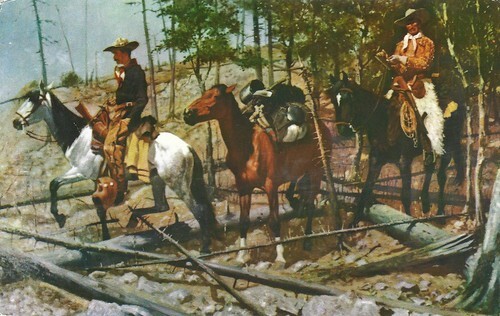
American postcard by Intermountain Tourist Supply Inc., Salt Lake City, no. C9531. Natural Colors by Mike Roberts. Postcard mailed in 1962 from Cody, Wyoming. The Prospectors, now called Prospecting for Cattle Range (1889) by Frederic Remington (1861-1909), Whitney Gallery of Art, Cody, Wyoming (opened in 1959, now merged with other museums into the Buffalo Bill Center of the West in Cody). The painting was a gift by Cornelius Vanderbilt Whitney.
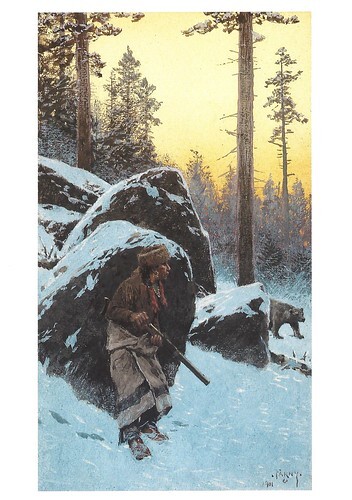
American postcard by Garamond / Pridemark Press, Inc., Baltimore. The Indian Bear Hunter (Henry F. Farny, 1911), Corcoran Gallery of Art, Washington DC.
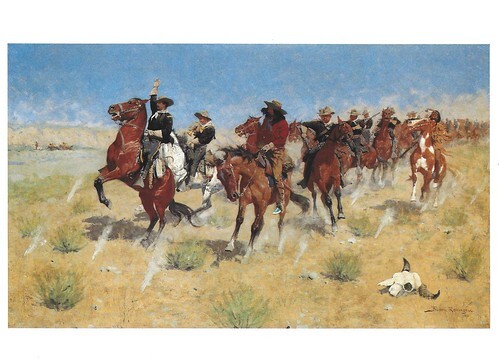
American postcard. Halt, Dismount! (Frederic Remington, 1901), Timken Art Gallery, Putnam Foundation Collection.
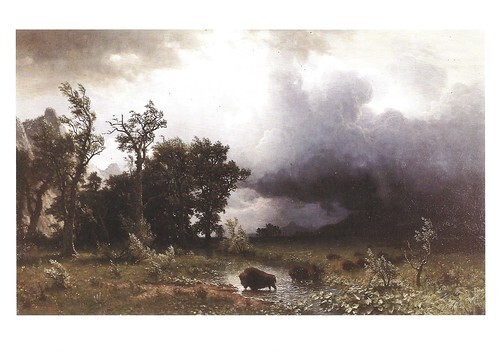
American postcard by Garamond / Pridemark Press, Inc., Baltimore. Buffalo Trail. The Impending Storm (Albert Bierstadt, 1869), Corcoran Gallery of Art, Washington DC.

American postcard by Garamond/ Pridemark Press, Inc., Baltimore. The Last of the Buffalo (Albert Bierstadt, c. 1889), Corcoran Gallery of Art, Washington DC.
A horse named Fritz
In The Great Train Robbery (1903), Broncho Billy Anderson played the dancing tenderfoot and the train passenger who gets shot and bandit #1. Seeing the film for the first time at a vaudeville theatre and being overwhelmed by the audience's reaction, he decided to work in the film industry exclusively. He began to write, direct, and act in his own westerns under the name Gilbert M. Anderson. In 1907 in Chicago, Anderson and George Kirke Spoor founded Essanay Studios ("S and A" for Spoor and Anderson), one of the major early movie studios. In 1909, he directed the film with the first known instance of the pie-the-face gag, Mr. Flip. Anderson acted in over 300 short films. He played a wide variety of characters, but he gained enormous popularity from a series of 148 silent western shorts and was the first film cowboy star, "Broncho Billy."
So popular was the genre that Anderson soon faced competition from Tom Mix and William S. Hart . Tom Mix began his film career in 1909 as a supporting cast member with the Selig Polyscope Company. His first appearance was in a short film, The Cowboy Millionaire (1909). In 1910, he appeared as himself in a short documentary film, Ranch Life in the Great Southwest, in which he displayed his skills as a cattle wrangler. Shot in Dewey, Oklahoma with Selig studio cameramen, the film was a success, and Mix became a star. Mix performed in more than 100 films for Selig, many of which were filmed in Las Vegas, New Mexico. Fascinated by the Old West, William S. [Surrey] Hart acquired Billy the Kid's "six shooters" and was a friend of legendary lawmen Wyatt Earp and Bat Masterson. He entered films in 1914, and after playing supporting roles in two short films, he achieved stardom the same year as the lead in the feature The Bargain (Reginald Barker, 1914). Beginning in 1915, Hart starred in his own series of two-reel Western short subjects for producer Thomas Ince. Hart was particularly interested in making realistic Western films. His films, including The Disciple (1915), The Taking of Jim McLane (1915) and Devil's Double (1916), are noted for their authentic costumes and props, as well as Hart's acting ability, honed on Shakespearean theatre stages in the United States and England.
Hart's films were so popular that they were supplanted by a series of feature films, starting with The Narrow Trail (1917), Hart's first feature production for Paramount. Many of Hart's early films continued to play in theatres, under new titles, for another decade. In 1915 and 1916 exhibitors voted him the biggest money-making star in the United States. In 1917 Hart accepted a lucrative offer from Adolph Zukor to join Famous Players–Lasky, which merged into Paramount Pictures. In the films Hart began to ride a brown and white pinto he called Fritz. Fritz was the forerunner of later famous movie horses known by their own name, e.g., horses like Tom Mix 's Tony, Roy Rogers 's Trigger and Clayton Moore's Silver. Tumbleweeds (1925) is Hart's best-known and greatest western, by director King Baggot and from UA - about the Cherokee Strip (Oklahoma) Gold Rush; the film's title referred to a breed of roaming cowboys.
Other early cowboy stars such as Hoot Gibson , Buck Jones ("The Red Rider"), Bob Steele ("Two-Fisted Hero of the West"), Tim McCoy, Ken Maynard , Tim Holt, William Boyd (Hopalong Cassidy), George O'Brien , Bill Elliott, Charles Starrett, Johnny Mack Brown and Harry Carey contributed to a romanticised concept of the hero of Westerns. The first feature-length western was Lawrence B. McGill's six-reel Arizona (1913). The first film to feature an all-Native American cast was Hiawatha (1913), made by the Colonial Motion Picture Corporation and based on Longfellow's poem. Young Cecil B. De Mille 's first motion picture was The Squaw Man (1914), usually credited as the first feature filmed entirely in Hollywood. De Mille remade the film in 1918 and 1931.
In the early days of the film industry, some real-life cowboys and legendary Western figures appeared in films: Wyatt Earp in The Half-Breed (1919) and Buffalo Bill Cody in The Adventures of Buffalo Bill (1917). Most of the hundreds of Westerns were low-budget films that had only slight variations on standard plots. But an increasing number were “big” or “epic” westerns, a type introduced in James Cruze's landmark and highly successful The Covered Wagon (1923), an expensive effort which cost $800,000 yet brought $4 million at the box office. Its success led to another silent Western tale of the building of the American empire by the construction of the Union and Central Pacific RRs - director John Ford's silent railroad classic epic The Iron Horse (1924). This type featured important stars and used larger budgets and modern production methods. The first epic Western to use talking in its soundtrack was Raoul Walsh’s The Big Trail (1930), starring John Wayne .
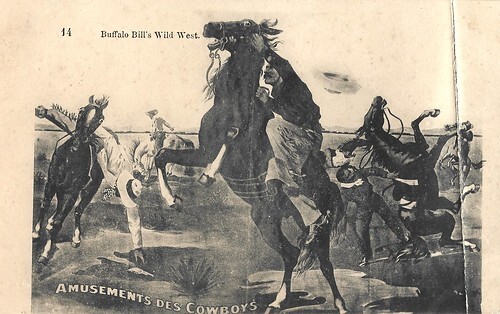
French postcard in the Buffalo Bill's Wild West series, no. 14. Caption: Amusements des Cowboys.
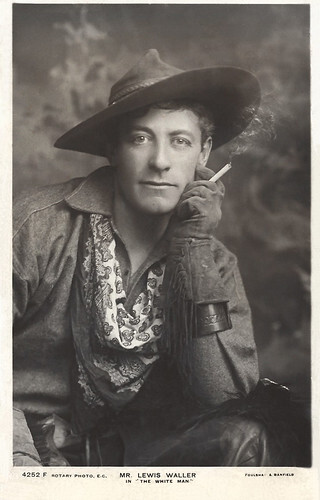
British postcard by Rotary Photographic Series, no. 4252F. Photo: Foulsham & Banfield. Publicity still for the play 'A White Man' (1908). In this play, based on the Western play 'The Squaw Man (1905) by Edwin Milton Royle, Lewis Waller appeared at the Lyric Theatre in London. In the cast, there were also several American performers, such as Herbert Sleath and George Fawcett, who already played the same parts in the 1905 play 'The Squaw Man'. Here the title is misspelled as 'The White Man'.
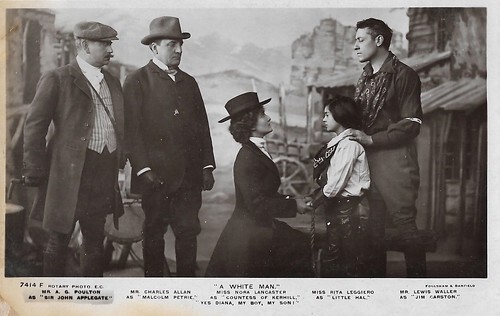
British postcard by Rotary Photographic Series, no. 7414 F. Photo: Foulsham & Banfield. Publicity still for the play 'A White Man' (1908). On this card, Lewis Waller as Jim Carston, Mora Lancaster as the Countess of Kerhill, Charles Allan as Malcolm Petrie, A.G, Poulton as Sir John Applegate, and Rita Leggiero as Little Hal.
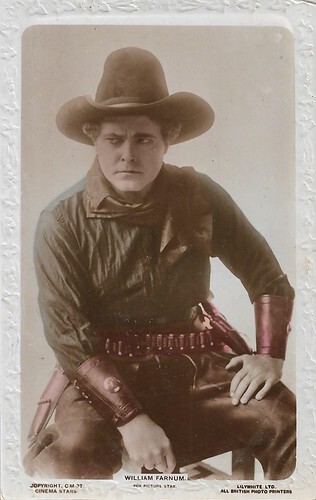
British postcard in the Cinema Stars series by Lilywhite Ltd., no. C.M. 37. Photo: Fox. American actor William Farnum (1876-1953) was one of the first major movie stars. From 1914 to 1925, Farnum was one of the biggest sensations in Hollywood, earning $10,000 a week. Farnum's silent pictures include the Westerns The Spoilers (1914) - which culminates in a spectacular saloon fistfight, and Drag Harlan (1920).
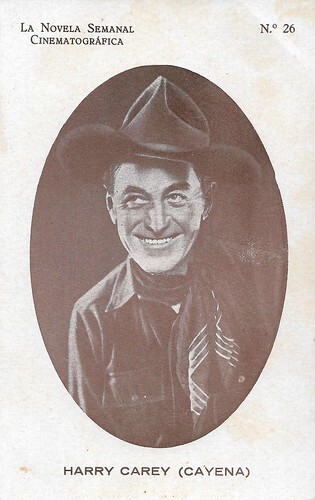
Spanish collectors card by La Novela Semanal Cinematográfica, no. 26. 'Cayena' refers to Carey's character Cheyenne Harry. American actor and cowboy Harry Carey (1878-1947) was one of silent film's earliest superstars. He was the father of Harry Carey Jr., who was also a prominent actor.
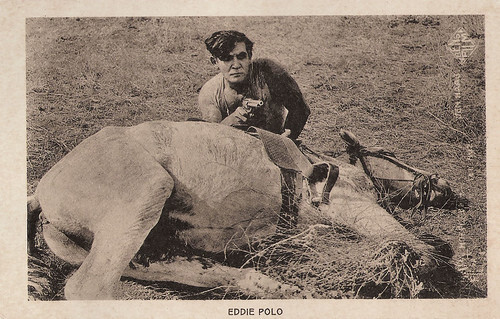
Dutch postcard by HAP Film, Den Haag. Photo: BenS Film. Eddie Polo (1875–1961) was an Austro-American actor of the silent era. With his brother Sam, he was the trapeze act The Flying Cordovas. He was the first man to parachute off the Eiffel Tower. Beginning in 1913, he appeared in serials and films in the USA and as Cyclone Smith, he became a popular Western hero. During the late 1920s, he was an action star in the German silent cinema.
[image error]
American arcade card by Ex. Sup. Co., Chicago. Photo: Famous Players-Lasky. Jack Holt as Cash Hawkins, Ann Little as Nat-u-Ritch and Elliott Dexter as Jim Carson aka James Wynnegate in The Squaw Man (Cecil B. deMille, 1918), based on the eponymous play by Edwin Milton Royle.
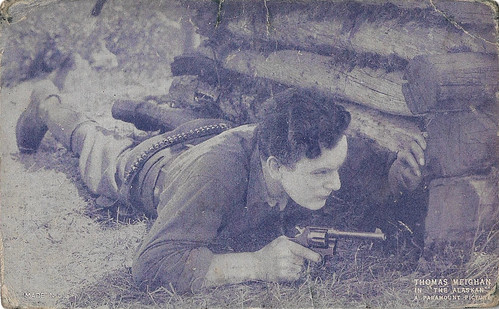
American Arcade Card by Ex. Sup. Co., Chicago. Photo: Paramount Pictures. Thomas Meighan in The Alaskan (Herbert Brenon, 1924).
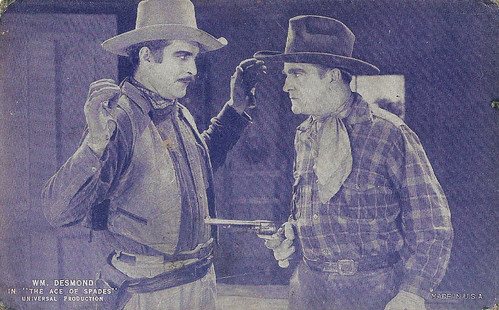
American Arcade card. Photo: Universal Production. William Desmond in The Ace of Spades (Henry MacRae, 1925). William Desmond (1878–1949) was an American actor, who appeared in 205 films between 1915 and 1948. He was nicknamed "The King of the Silent Serials" and acted in numerous Westerns.
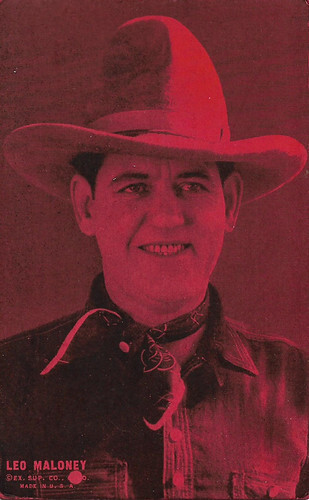
American Arcade card by Ex. Sup. Co., Chicago. Leo Maloney (1888-1929) was an American actor, stuntman, director and screenwriter. Maloney started his film career in 1911 at Selig, as a bit actor opposite Western hero Tom Mix. He appeared in 183 films,e directed forty-eight films, produced thirteen and wrote the screenplay for 10 films.
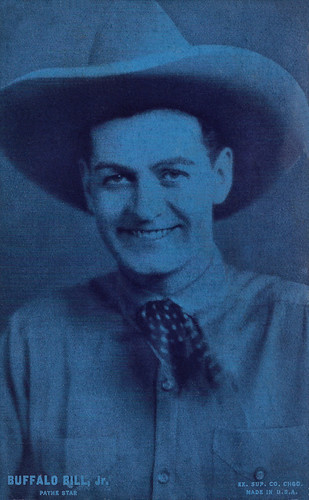
American Arcade card by Ex. Sup. Co. (Exhibition Supply Company), Chicago, Ill. Photo: Pathé. American actor Jay Wilsey (1895-1961) was a star of the silent Western and later appeared in B to Z Westerns. His first studio called him 'Buffalo Bill Jr.', although he had no connection whatsoever with the real Buffalo Bill, William F. Cody. Wilsey appeared in nearly 100 films between 1924 and 1944.
The Squaw Man
The Western has as its setting the immense plains, rugged tablelands, and mountain ranges of the portion of the United States lying west of the Mississippi River, particularly the Great Plains and the Southwest. This area was not truly opened to white settlement until after the American Civil War (1861–1865), at which time the Plains Indians were gradually subdued and deprived of most of their lands by white settlers and by the U.S. cavalry. The conflict between white pioneers and Indians forms one of the basic themes of the Western.
Another theme sprang out of the class of men known as cowboys, who were hired by ranchers to drive cattle across hundreds of miles of Western pasturelands to railheads where the animals could be shipped eastward to market. The cattle and mining industries spurred the growth of towns, and the gradual imposition of law and order that such settled communities needed was accomplished by another class of men who became staple figures in the Western, the town sheriff and the U.S. marshal. Actual historical persons in the American West have figured prominently in latter-day re-creations of the era. Wild Bill Hickok, Wyatt Earp, and other lawmen have frequently been portrayed, as have such outlaws as Billy the Kid and Jesse James.
The Squaw Man was a 1905 Western/drama stage play in four acts written by Edwin Milton Royle. It debuted on October 23, 1905, at the Wallack's Theatre, Broadway, starring William Faversham in the title role, as Captain James Wynnegate also known as Jim Carson. The doomed bad man, Cash Hawkins, was played by William S. Hart . Directed by Edwin Milton Royle and William Faversham, The Squaw Man was produced by Liebler & Company. Receiving significant critical acclaim, the play ran for 222 performances before closing on April 1, 1906. 'The Squaw' Man had four Broadway revivals, in 1907, 1908, 1911 and 1921. The 1911 revival starring Dustin Farnum ran for only eight performances. The 1921 revival starring William Faversham at the Astor Theatre ran for 50 performances. The Squaw Man was filmed three times by Cecil B. DeMille , first in 1913-14 in co-direction with Oscar Apfel. The barn which DeMille rented as his first film studio is still kept in Los Angeles. The film, starring Dustin Farnum was a huge success and confirmed the founding of the new Lasky company (out of which the major Paramount would rise). It also goes as the first American feature, even if Griffith's Judith of Bethulia was filmed first, but released after DeMille's film. DeMille made the first remake of his film in 1918, starring Elliott Dexter, after which a second followed in the early sound era (1931), starring Warner Baxter.
In literature, the Western story had its beginnings in the first adventure narratives that accompanied the opening of the West to white settlement shortly before the Civil War. Accounts of the Western plainsmen, scouts, buffalo hunters, and trappers were highly popular in the East. Perhaps the earliest and finest work in this genre was James Fenimore Cooper’s 'The Prairie' (1827), though the high artistic level of this novel was perhaps atypical regarding what followed. An early writer to capitalise on the popularity of Western adventure narratives was E.Z.C. Judson, whose pseudonym was Ned Buntline; known as “the father of the dime novel,” he wrote dozens of Western stories and was responsible for transforming Buffalo Bill into an archetype.
Owen Wister, who first saw the West while recuperating from an illness, wrote the first Western that won critical praise, 'The Virginian' (1902). Classics of the genre have been written by men who actually worked as cowboys; one of the best-loved of these was 'Bransford in Arcadia' (1914; reprinted 1917 as 'Bransford of Rainbow Range') by Eugene Manlove Rhodes, a former cowboy and government scout. Andy Adams incorporated many autobiographical incidents in his 'Log of a Cowboy' (1903). By far the best-known and one of the most prolific writers of Westerns was Zane Grey, an Ohio dentist who became famous with the classic 'Riders of the Purple Sage' (1912). In all, Grey wrote more than 80 books, many of which retained wide popularity.
Though basically an American creation, the Western had its counterparts in the gaucho literature of Argentina and in tales of the settlement of the Australian outback. The genre reached its greatest popularity in the early and middle decades of the 20th century and declined somewhat thereafter.
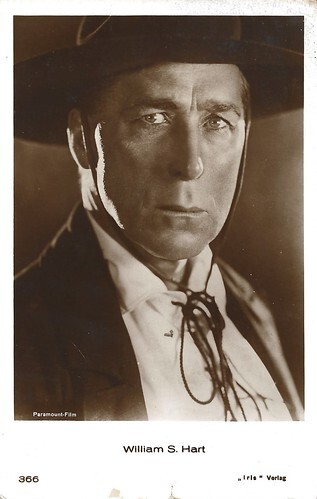
Austrian postcard by Iris Verlag, no. 366. Photo: Paramount-Film.
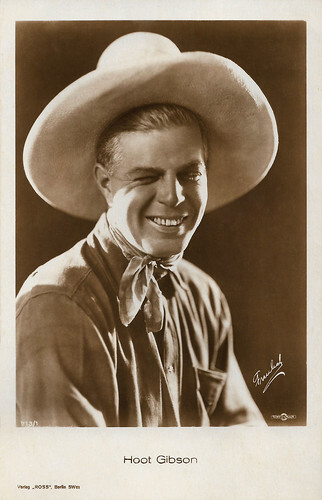
German postcard by Ross Verlag, no. 713/1, 1925-1926. Photo: Roman Freulich / Unifilman (Universal). Hoot Gibson (1892-1962) was a rodeo champion and pioneering cowboy star of silent Westerns. With his easy combination of light, breezy, boyish charm comedy and riding abilities, Hoot filled a gap between the austere William S. Hart and the flamboyant Tom Mix and appealed both to adults (especially women) and kids. During the 1920s, he was one of the most popular children's matinée heroes, ranking second only to Mix, and one of Universal's top-paid stars. In his real life, however, he had an expensive love for fast cars, motorcycles and aeroplanes and led a rather painful rags-to-riches-and-back-to-rags career.
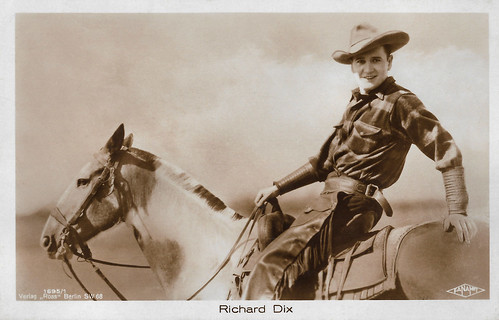
German postcard by Ross Verlag, no. 1685/1, 1927-1928. Photo: Fanamet. Richard Dix in Womanhandled (Gregory La Cava, 1925). Richard Dix (1893–1949) achieved popularity in both silent and sound film, first as the rugged and stalwart hero in countless Westerns, then dramatic features such as the Cecil B. DeMille's The Ten Commandments (1923). After his years of silent film at Paramount, and thanks to his deep voice and commanding presence, he became a well-known star at RKO in the 1930s. He was nominated for the Academy Award for Best Actor for his lead role in the Best Picture-winning epic, Cimarron (1931).
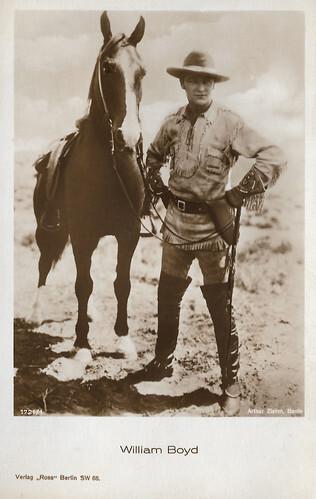
German postcard by Ross Verlag, no. 1721/1, 1927-1928. Photo: Arthur Ziehm, Berlin. William Boyd as Tom Kirby in The Last Frontier (Geoge B. Seitz, 1926).
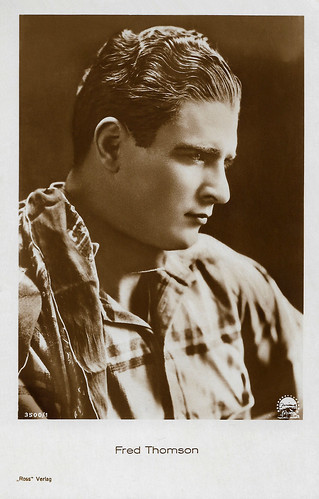
German postcard by Ross Verlag, no. 3500/1, 1928-1929. Photo: Paramount. Handsome Fred Thomson (1890–1928) was an American silent film cowboy, who rivalled Tom Mix in popularity in the mid-1920s. He was the no. 2 box office star for 1926 and 1927 and played the legendary Jesse James and Kit Carson. In 1928, he suddenly died of tetanus, at only 38 years old.
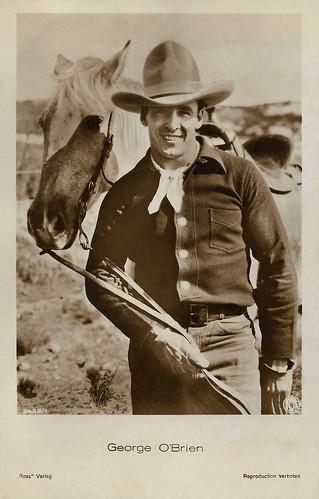
German postcard by Ross Verlag, no. 3836/1, 1928-1929. Photo: Fox. George O'Brien (1899-1985) was a muscular, barrel-chested, yet sensitively talented leading man of classic silent films, like John Ford's The Iron Horse (1924) and F. W. Murnau's Sunrise (1927). He became a different kind of star as a cowboy in B-Westerns during the sound era.
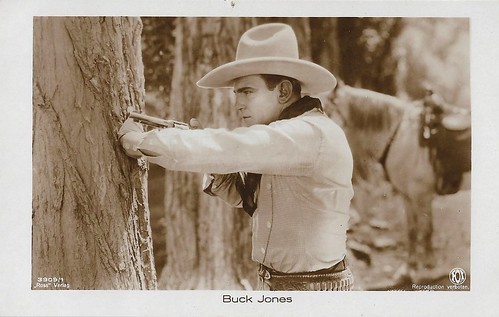
German postcard by Ross Verlag, no. 3909/1, 1928-1929. Photo: Fox. American film star Buck Jones (1891–1942) starred in many popular B-Westerns of the 1920s, 1930s, and 1940s. Executive William Fox decided to use him as a backup to Tom Mix. This led to his first starring role, The Last Straw (Denison Clift, Charles Swickard, 1920). With his famed horse Silver, Jones would make more than 160 film credits.

German postcard by Ross Verlag, no. 4813/1, 1929-1930. Photo: Radio Pictures. Tom Mix (1880-1940) was the star of many early Westerns between 1909 and 1935. Mix appeared in 291 films, all but nine of which were silent movies. He was Hollywood's first Western megastar and helped to define the genre for all cowboy actors who followed.
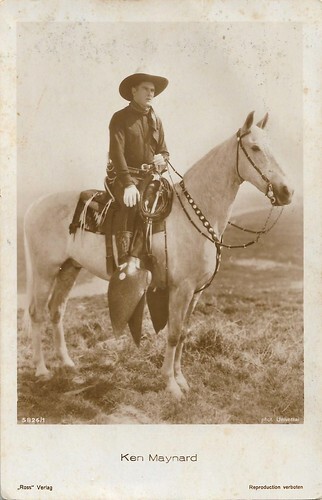
German postcard by Ross Verlag, no. 5826/1. Photo Universal. Ken Maynard (1895–1973) was one of the superstars among the film cowboys.
And for more silent Wild West, check out our posts Twelve Silent Cowboys and La Collectionneuse: Actresses as Native Americans.
Sources: Nanna Verhoeff (The West in Early Cinema - After the Beginning), Tim Dirks (Filmsite), Britannica, Wikipedia and IMDb.

Dutch postcard, no. P. 13730. Photo: M.G.M. Cecil B. DeMille and Chief Little Bison.

American postcard by Kraus Mfg., Co., New York. Photo: Essanay. Gilbert M. Anderson (Broncho Billy). Blue eyes light, brown hat.

French postcard by A.N. in the Les vedettes de cinéma series, Paris, no. 32. Photo: Film Paramount. William S. Hart .

American card. Tom Mix and his horse Tony, posing.

American postcard in the Rotograph series, no. B1185. Scene from the stage play version of 'The Squaw Man' by Edwin Milton Royle (1905), performed from 1905. Act II, caption: Me Kill him! (Nat-u-Ritch has killed the evil Cash Hawkins, who wanted to kill Jim Carson aka James Wynnegate). This photo is identical to the poster that was made in 1905 by the Strobridge Co. of Cincinnati for the play and that some today use as if for the 1914 film by Cecil B. DeMille . Depicted here are William Faversham as James Wynnegate, Adrienne Morrison as Nat-u-Ritch, and (just killed) William S. Hart as Cash Hawkins.

American card for the Criterion Theatre, with French handwriting. Caption: The great wagon train in "The Covered Wagon", refers to the American silent film The Covered Wagon (James Cruze, 1923).
The earliest known Western narrative film
Film Westerns derive from the Wild West shows that began in the 1870s. These shows, which included stage plays and outdoor exhibitions, culminated in Buffalo Bill's Wild West, a touring performance that ran from 1883 to 1913. Wild West shows, which were intended for urban audiences, established many of the elements that came to define Western films, such as the blending of fact and fiction and the romanticisation of the frontier. The first films that belong to the Western genre are a series of short single reel silents made in 1894 by Edison Studios at their Black Maria studio in West Orange, New Jersey. These featured veterans of Buffalo Bill's Wild West show exhibiting skills acquired by living in the Old West – they included Annie Oakley (shooting) and members of the Sioux (dancing).
The earliest known Western narrative film is not an American production but a British short Kidnapping by Indians. It was made by the Mitchell & Kenyon film company in Blackburn, England, in 1899. The plot concerns an attack by Native Americans on a camp where white people are staying. The attackers set fire to the camp and kidnap a young girl. Some cowboys arrive and a gunfight begins. The captured girl is rescued by the cowboys. The running time is 1 minute. According to Jamie Holman, a local researcher, James Kenyon of Mitchell & Kenyon met some Americans in Blackburn when he was a boy. This sparked his interest in the 'Wild West' and ultimately led to the production of this film. The storyline of a white girl being kidnapped by Indians is also in James Fenimore Cooper's novel 'The Last of the Mohicans' (1826) and many later Wild West films such as John Ford's The Searchers (1956).
Another influential early British film A Daring Daylight Burglary (1903) directed by Frank Mottershaw and produced by the Sheffield Photo Company, features members from the Sheffield Fire Brigade as part of the cast. The innovative technique of the film inspired Edwin S. Porter's film The Great Train Robbery (1903), produced by the Edison Manufacturing Company and starring Gilbert M. 'Broncho Billy' Anderson. In The Great Train Robbery, a gang of outlaws hold up and rob a steam locomotive at a station in the American West. The outlaws flee across mountainous terrain and are finally defeated by a posse of locals.
Porter's storytelling approach allowed him to include many popular techniques of the time, including scenes staged in wide shots, a matte effect, and an attempt to indicate simultaneous action across multiple scenes. Camera pans, location shooting, and moments of violent action helped give The Great Train Robbery a sense of rough-edged immediacy. A special close-up shot, which was unconnected to the story and could either begin or end the film depending on the projectionist's whim, showed Justus D. Barnes, as the outlaw leader, emptying his gun directly into the camera.
Although The Great Train Robbery was not the first Western, Porter's film set the pattern — of crime, pursuit, and retribution — for the Western film as a genre. The short film draws on many sources, including a robust existing tradition of Western films, recent European innovations in film technique, the 1896 play of the same name by Scott Marble, the popularity of train-themed films, and possibly real-life incidents involving outlaws such as Butch Cassidy. The Great Train Robbery was an unprecedented commercial success. Though it did not significantly influence or advance the Western film genre, it was widely distributed and copied.
D.W. Griffith made a series of highly successful Westerns including In Old California (1910), The Twisted Trail (1910) with Mary Pickford , The Last Drop of Water (1911), with the Western's first characteristic scenes of a wagon train siege and a cavalry rescue, the innovatively-filmed Fighting Blood (1911) about conflict between white settlers and Sioux Indians in the Dakota territory of 1899 and Griffith's last major Biograph Western filmed in Southern California, titled The Battle of Elderbush Gulch (1914).

American postcard by Detroit Publishing Co., 14180, postcard mailed US 1907. His First Lesson (1903) by the American artist Frederic Remington (1861-1909). Today, the painting is housed at the Amon Carter Museum of American Art, Fort Worth, Texas, and is part of the Amon G. Carter Collection.

American postcard by Intermountain Tourist Supply Inc., Salt Lake City, no. C9531. Natural Colors by Mike Roberts. Postcard mailed in 1962 from Cody, Wyoming. The Prospectors, now called Prospecting for Cattle Range (1889) by Frederic Remington (1861-1909), Whitney Gallery of Art, Cody, Wyoming (opened in 1959, now merged with other museums into the Buffalo Bill Center of the West in Cody). The painting was a gift by Cornelius Vanderbilt Whitney.

American postcard by Garamond / Pridemark Press, Inc., Baltimore. The Indian Bear Hunter (Henry F. Farny, 1911), Corcoran Gallery of Art, Washington DC.

American postcard. Halt, Dismount! (Frederic Remington, 1901), Timken Art Gallery, Putnam Foundation Collection.

American postcard by Garamond / Pridemark Press, Inc., Baltimore. Buffalo Trail. The Impending Storm (Albert Bierstadt, 1869), Corcoran Gallery of Art, Washington DC.

American postcard by Garamond/ Pridemark Press, Inc., Baltimore. The Last of the Buffalo (Albert Bierstadt, c. 1889), Corcoran Gallery of Art, Washington DC.
A horse named Fritz
In The Great Train Robbery (1903), Broncho Billy Anderson played the dancing tenderfoot and the train passenger who gets shot and bandit #1. Seeing the film for the first time at a vaudeville theatre and being overwhelmed by the audience's reaction, he decided to work in the film industry exclusively. He began to write, direct, and act in his own westerns under the name Gilbert M. Anderson. In 1907 in Chicago, Anderson and George Kirke Spoor founded Essanay Studios ("S and A" for Spoor and Anderson), one of the major early movie studios. In 1909, he directed the film with the first known instance of the pie-the-face gag, Mr. Flip. Anderson acted in over 300 short films. He played a wide variety of characters, but he gained enormous popularity from a series of 148 silent western shorts and was the first film cowboy star, "Broncho Billy."
So popular was the genre that Anderson soon faced competition from Tom Mix and William S. Hart . Tom Mix began his film career in 1909 as a supporting cast member with the Selig Polyscope Company. His first appearance was in a short film, The Cowboy Millionaire (1909). In 1910, he appeared as himself in a short documentary film, Ranch Life in the Great Southwest, in which he displayed his skills as a cattle wrangler. Shot in Dewey, Oklahoma with Selig studio cameramen, the film was a success, and Mix became a star. Mix performed in more than 100 films for Selig, many of which were filmed in Las Vegas, New Mexico. Fascinated by the Old West, William S. [Surrey] Hart acquired Billy the Kid's "six shooters" and was a friend of legendary lawmen Wyatt Earp and Bat Masterson. He entered films in 1914, and after playing supporting roles in two short films, he achieved stardom the same year as the lead in the feature The Bargain (Reginald Barker, 1914). Beginning in 1915, Hart starred in his own series of two-reel Western short subjects for producer Thomas Ince. Hart was particularly interested in making realistic Western films. His films, including The Disciple (1915), The Taking of Jim McLane (1915) and Devil's Double (1916), are noted for their authentic costumes and props, as well as Hart's acting ability, honed on Shakespearean theatre stages in the United States and England.
Hart's films were so popular that they were supplanted by a series of feature films, starting with The Narrow Trail (1917), Hart's first feature production for Paramount. Many of Hart's early films continued to play in theatres, under new titles, for another decade. In 1915 and 1916 exhibitors voted him the biggest money-making star in the United States. In 1917 Hart accepted a lucrative offer from Adolph Zukor to join Famous Players–Lasky, which merged into Paramount Pictures. In the films Hart began to ride a brown and white pinto he called Fritz. Fritz was the forerunner of later famous movie horses known by their own name, e.g., horses like Tom Mix 's Tony, Roy Rogers 's Trigger and Clayton Moore's Silver. Tumbleweeds (1925) is Hart's best-known and greatest western, by director King Baggot and from UA - about the Cherokee Strip (Oklahoma) Gold Rush; the film's title referred to a breed of roaming cowboys.
Other early cowboy stars such as Hoot Gibson , Buck Jones ("The Red Rider"), Bob Steele ("Two-Fisted Hero of the West"), Tim McCoy, Ken Maynard , Tim Holt, William Boyd (Hopalong Cassidy), George O'Brien , Bill Elliott, Charles Starrett, Johnny Mack Brown and Harry Carey contributed to a romanticised concept of the hero of Westerns. The first feature-length western was Lawrence B. McGill's six-reel Arizona (1913). The first film to feature an all-Native American cast was Hiawatha (1913), made by the Colonial Motion Picture Corporation and based on Longfellow's poem. Young Cecil B. De Mille 's first motion picture was The Squaw Man (1914), usually credited as the first feature filmed entirely in Hollywood. De Mille remade the film in 1918 and 1931.
In the early days of the film industry, some real-life cowboys and legendary Western figures appeared in films: Wyatt Earp in The Half-Breed (1919) and Buffalo Bill Cody in The Adventures of Buffalo Bill (1917). Most of the hundreds of Westerns were low-budget films that had only slight variations on standard plots. But an increasing number were “big” or “epic” westerns, a type introduced in James Cruze's landmark and highly successful The Covered Wagon (1923), an expensive effort which cost $800,000 yet brought $4 million at the box office. Its success led to another silent Western tale of the building of the American empire by the construction of the Union and Central Pacific RRs - director John Ford's silent railroad classic epic The Iron Horse (1924). This type featured important stars and used larger budgets and modern production methods. The first epic Western to use talking in its soundtrack was Raoul Walsh’s The Big Trail (1930), starring John Wayne .

French postcard in the Buffalo Bill's Wild West series, no. 14. Caption: Amusements des Cowboys.

British postcard by Rotary Photographic Series, no. 4252F. Photo: Foulsham & Banfield. Publicity still for the play 'A White Man' (1908). In this play, based on the Western play 'The Squaw Man (1905) by Edwin Milton Royle, Lewis Waller appeared at the Lyric Theatre in London. In the cast, there were also several American performers, such as Herbert Sleath and George Fawcett, who already played the same parts in the 1905 play 'The Squaw Man'. Here the title is misspelled as 'The White Man'.

British postcard by Rotary Photographic Series, no. 7414 F. Photo: Foulsham & Banfield. Publicity still for the play 'A White Man' (1908). On this card, Lewis Waller as Jim Carston, Mora Lancaster as the Countess of Kerhill, Charles Allan as Malcolm Petrie, A.G, Poulton as Sir John Applegate, and Rita Leggiero as Little Hal.

British postcard in the Cinema Stars series by Lilywhite Ltd., no. C.M. 37. Photo: Fox. American actor William Farnum (1876-1953) was one of the first major movie stars. From 1914 to 1925, Farnum was one of the biggest sensations in Hollywood, earning $10,000 a week. Farnum's silent pictures include the Westerns The Spoilers (1914) - which culminates in a spectacular saloon fistfight, and Drag Harlan (1920).

Spanish collectors card by La Novela Semanal Cinematográfica, no. 26. 'Cayena' refers to Carey's character Cheyenne Harry. American actor and cowboy Harry Carey (1878-1947) was one of silent film's earliest superstars. He was the father of Harry Carey Jr., who was also a prominent actor.

Dutch postcard by HAP Film, Den Haag. Photo: BenS Film. Eddie Polo (1875–1961) was an Austro-American actor of the silent era. With his brother Sam, he was the trapeze act The Flying Cordovas. He was the first man to parachute off the Eiffel Tower. Beginning in 1913, he appeared in serials and films in the USA and as Cyclone Smith, he became a popular Western hero. During the late 1920s, he was an action star in the German silent cinema.
[image error]
American arcade card by Ex. Sup. Co., Chicago. Photo: Famous Players-Lasky. Jack Holt as Cash Hawkins, Ann Little as Nat-u-Ritch and Elliott Dexter as Jim Carson aka James Wynnegate in The Squaw Man (Cecil B. deMille, 1918), based on the eponymous play by Edwin Milton Royle.

American Arcade Card by Ex. Sup. Co., Chicago. Photo: Paramount Pictures. Thomas Meighan in The Alaskan (Herbert Brenon, 1924).

American Arcade card. Photo: Universal Production. William Desmond in The Ace of Spades (Henry MacRae, 1925). William Desmond (1878–1949) was an American actor, who appeared in 205 films between 1915 and 1948. He was nicknamed "The King of the Silent Serials" and acted in numerous Westerns.

American Arcade card by Ex. Sup. Co., Chicago. Leo Maloney (1888-1929) was an American actor, stuntman, director and screenwriter. Maloney started his film career in 1911 at Selig, as a bit actor opposite Western hero Tom Mix. He appeared in 183 films,e directed forty-eight films, produced thirteen and wrote the screenplay for 10 films.

American Arcade card by Ex. Sup. Co. (Exhibition Supply Company), Chicago, Ill. Photo: Pathé. American actor Jay Wilsey (1895-1961) was a star of the silent Western and later appeared in B to Z Westerns. His first studio called him 'Buffalo Bill Jr.', although he had no connection whatsoever with the real Buffalo Bill, William F. Cody. Wilsey appeared in nearly 100 films between 1924 and 1944.
The Squaw Man
The Western has as its setting the immense plains, rugged tablelands, and mountain ranges of the portion of the United States lying west of the Mississippi River, particularly the Great Plains and the Southwest. This area was not truly opened to white settlement until after the American Civil War (1861–1865), at which time the Plains Indians were gradually subdued and deprived of most of their lands by white settlers and by the U.S. cavalry. The conflict between white pioneers and Indians forms one of the basic themes of the Western.
Another theme sprang out of the class of men known as cowboys, who were hired by ranchers to drive cattle across hundreds of miles of Western pasturelands to railheads where the animals could be shipped eastward to market. The cattle and mining industries spurred the growth of towns, and the gradual imposition of law and order that such settled communities needed was accomplished by another class of men who became staple figures in the Western, the town sheriff and the U.S. marshal. Actual historical persons in the American West have figured prominently in latter-day re-creations of the era. Wild Bill Hickok, Wyatt Earp, and other lawmen have frequently been portrayed, as have such outlaws as Billy the Kid and Jesse James.
The Squaw Man was a 1905 Western/drama stage play in four acts written by Edwin Milton Royle. It debuted on October 23, 1905, at the Wallack's Theatre, Broadway, starring William Faversham in the title role, as Captain James Wynnegate also known as Jim Carson. The doomed bad man, Cash Hawkins, was played by William S. Hart . Directed by Edwin Milton Royle and William Faversham, The Squaw Man was produced by Liebler & Company. Receiving significant critical acclaim, the play ran for 222 performances before closing on April 1, 1906. 'The Squaw' Man had four Broadway revivals, in 1907, 1908, 1911 and 1921. The 1911 revival starring Dustin Farnum ran for only eight performances. The 1921 revival starring William Faversham at the Astor Theatre ran for 50 performances. The Squaw Man was filmed three times by Cecil B. DeMille , first in 1913-14 in co-direction with Oscar Apfel. The barn which DeMille rented as his first film studio is still kept in Los Angeles. The film, starring Dustin Farnum was a huge success and confirmed the founding of the new Lasky company (out of which the major Paramount would rise). It also goes as the first American feature, even if Griffith's Judith of Bethulia was filmed first, but released after DeMille's film. DeMille made the first remake of his film in 1918, starring Elliott Dexter, after which a second followed in the early sound era (1931), starring Warner Baxter.
In literature, the Western story had its beginnings in the first adventure narratives that accompanied the opening of the West to white settlement shortly before the Civil War. Accounts of the Western plainsmen, scouts, buffalo hunters, and trappers were highly popular in the East. Perhaps the earliest and finest work in this genre was James Fenimore Cooper’s 'The Prairie' (1827), though the high artistic level of this novel was perhaps atypical regarding what followed. An early writer to capitalise on the popularity of Western adventure narratives was E.Z.C. Judson, whose pseudonym was Ned Buntline; known as “the father of the dime novel,” he wrote dozens of Western stories and was responsible for transforming Buffalo Bill into an archetype.
Owen Wister, who first saw the West while recuperating from an illness, wrote the first Western that won critical praise, 'The Virginian' (1902). Classics of the genre have been written by men who actually worked as cowboys; one of the best-loved of these was 'Bransford in Arcadia' (1914; reprinted 1917 as 'Bransford of Rainbow Range') by Eugene Manlove Rhodes, a former cowboy and government scout. Andy Adams incorporated many autobiographical incidents in his 'Log of a Cowboy' (1903). By far the best-known and one of the most prolific writers of Westerns was Zane Grey, an Ohio dentist who became famous with the classic 'Riders of the Purple Sage' (1912). In all, Grey wrote more than 80 books, many of which retained wide popularity.
Though basically an American creation, the Western had its counterparts in the gaucho literature of Argentina and in tales of the settlement of the Australian outback. The genre reached its greatest popularity in the early and middle decades of the 20th century and declined somewhat thereafter.

Austrian postcard by Iris Verlag, no. 366. Photo: Paramount-Film.

German postcard by Ross Verlag, no. 713/1, 1925-1926. Photo: Roman Freulich / Unifilman (Universal). Hoot Gibson (1892-1962) was a rodeo champion and pioneering cowboy star of silent Westerns. With his easy combination of light, breezy, boyish charm comedy and riding abilities, Hoot filled a gap between the austere William S. Hart and the flamboyant Tom Mix and appealed both to adults (especially women) and kids. During the 1920s, he was one of the most popular children's matinée heroes, ranking second only to Mix, and one of Universal's top-paid stars. In his real life, however, he had an expensive love for fast cars, motorcycles and aeroplanes and led a rather painful rags-to-riches-and-back-to-rags career.

German postcard by Ross Verlag, no. 1685/1, 1927-1928. Photo: Fanamet. Richard Dix in Womanhandled (Gregory La Cava, 1925). Richard Dix (1893–1949) achieved popularity in both silent and sound film, first as the rugged and stalwart hero in countless Westerns, then dramatic features such as the Cecil B. DeMille's The Ten Commandments (1923). After his years of silent film at Paramount, and thanks to his deep voice and commanding presence, he became a well-known star at RKO in the 1930s. He was nominated for the Academy Award for Best Actor for his lead role in the Best Picture-winning epic, Cimarron (1931).

German postcard by Ross Verlag, no. 1721/1, 1927-1928. Photo: Arthur Ziehm, Berlin. William Boyd as Tom Kirby in The Last Frontier (Geoge B. Seitz, 1926).

German postcard by Ross Verlag, no. 3500/1, 1928-1929. Photo: Paramount. Handsome Fred Thomson (1890–1928) was an American silent film cowboy, who rivalled Tom Mix in popularity in the mid-1920s. He was the no. 2 box office star for 1926 and 1927 and played the legendary Jesse James and Kit Carson. In 1928, he suddenly died of tetanus, at only 38 years old.

German postcard by Ross Verlag, no. 3836/1, 1928-1929. Photo: Fox. George O'Brien (1899-1985) was a muscular, barrel-chested, yet sensitively talented leading man of classic silent films, like John Ford's The Iron Horse (1924) and F. W. Murnau's Sunrise (1927). He became a different kind of star as a cowboy in B-Westerns during the sound era.

German postcard by Ross Verlag, no. 3909/1, 1928-1929. Photo: Fox. American film star Buck Jones (1891–1942) starred in many popular B-Westerns of the 1920s, 1930s, and 1940s. Executive William Fox decided to use him as a backup to Tom Mix. This led to his first starring role, The Last Straw (Denison Clift, Charles Swickard, 1920). With his famed horse Silver, Jones would make more than 160 film credits.

German postcard by Ross Verlag, no. 4813/1, 1929-1930. Photo: Radio Pictures. Tom Mix (1880-1940) was the star of many early Westerns between 1909 and 1935. Mix appeared in 291 films, all but nine of which were silent movies. He was Hollywood's first Western megastar and helped to define the genre for all cowboy actors who followed.

German postcard by Ross Verlag, no. 5826/1. Photo Universal. Ken Maynard (1895–1973) was one of the superstars among the film cowboys.
And for more silent Wild West, check out our posts Twelve Silent Cowboys and La Collectionneuse: Actresses as Native Americans.
Sources: Nanna Verhoeff (The West in Early Cinema - After the Beginning), Tim Dirks (Filmsite), Britannica, Wikipedia and IMDb.
Published on October 07, 2023 22:00
Paul van Yperen's Blog
- Paul van Yperen's profile
- 13 followers
Paul van Yperen isn't a Goodreads Author
(yet),
but they
do have a blog,
so here are some recent posts imported from
their feed.



